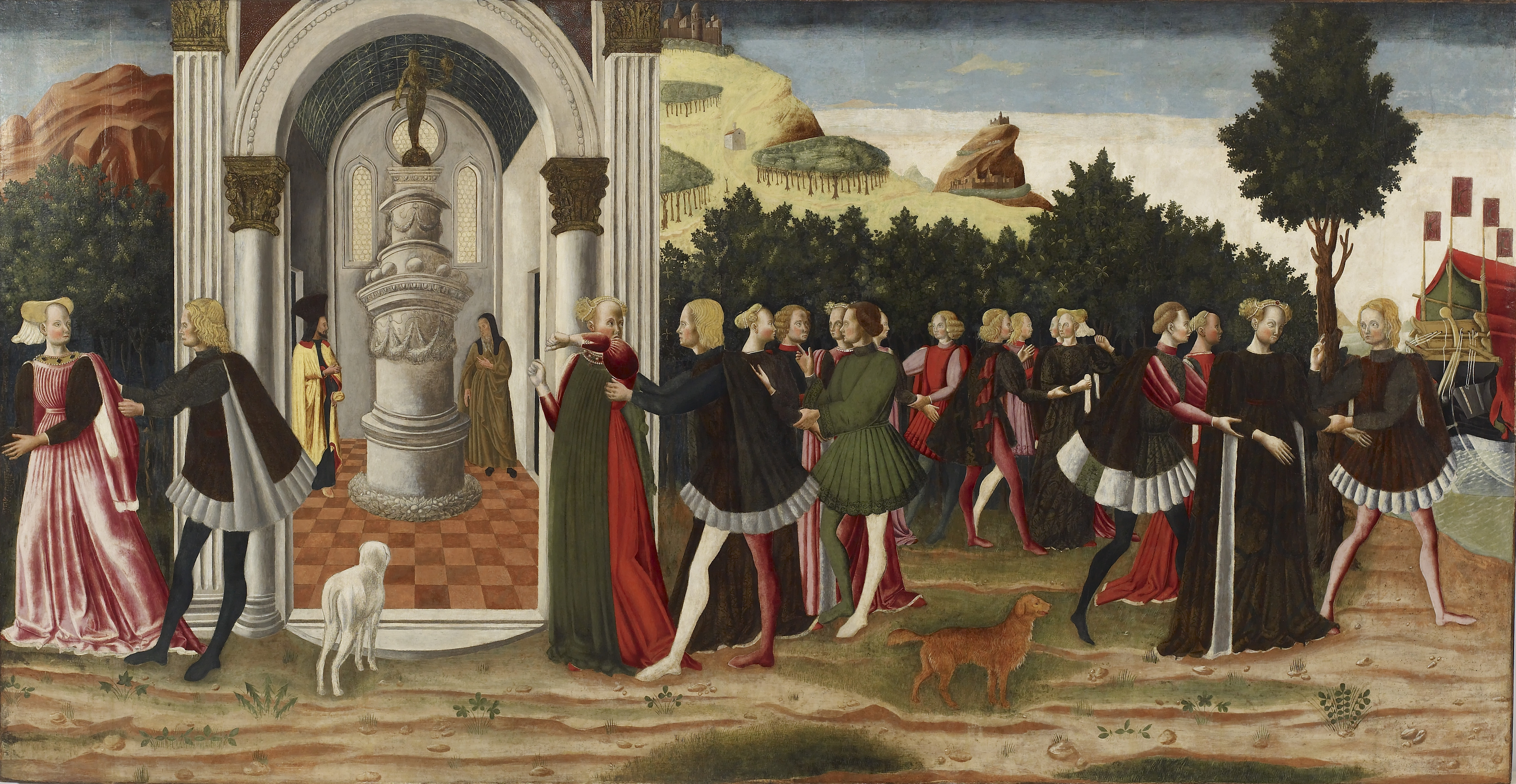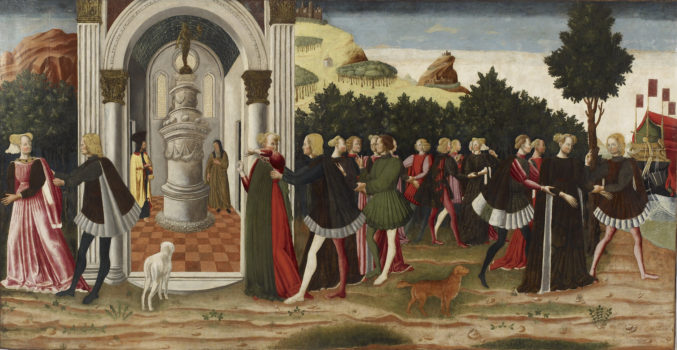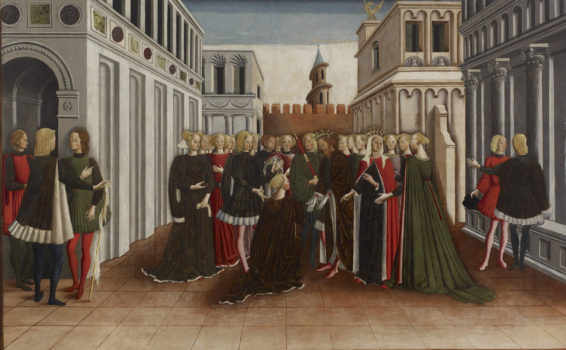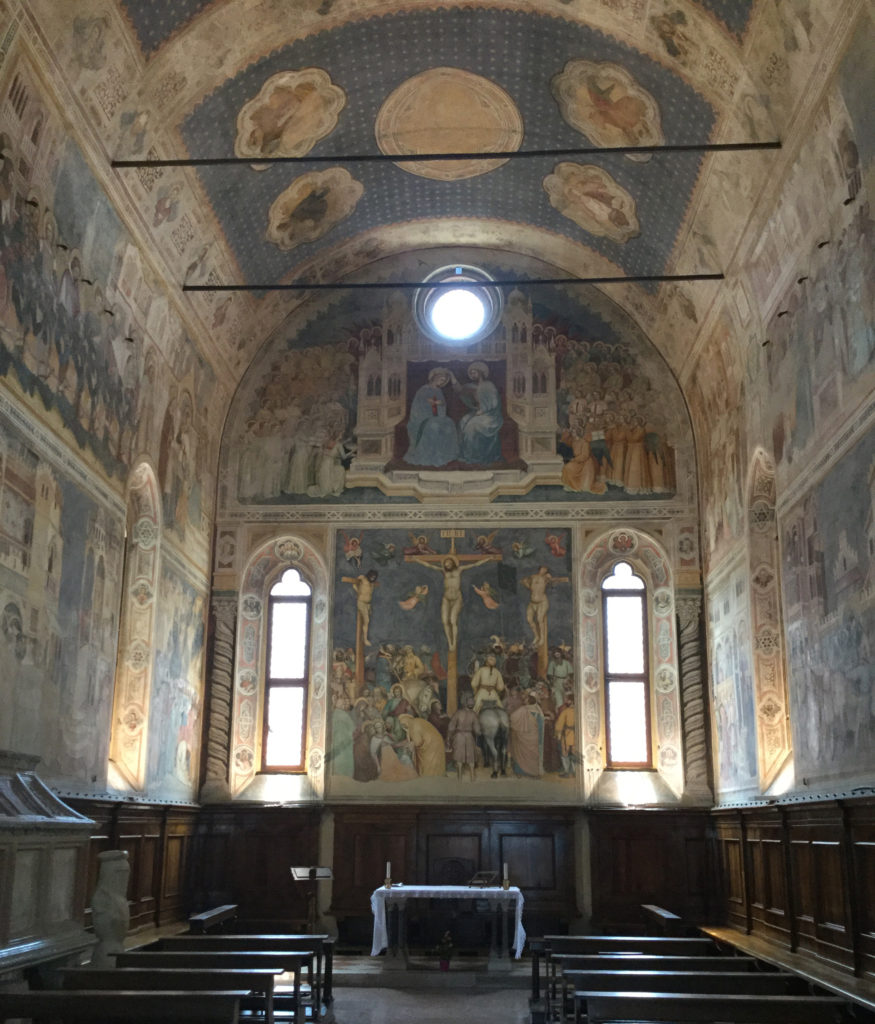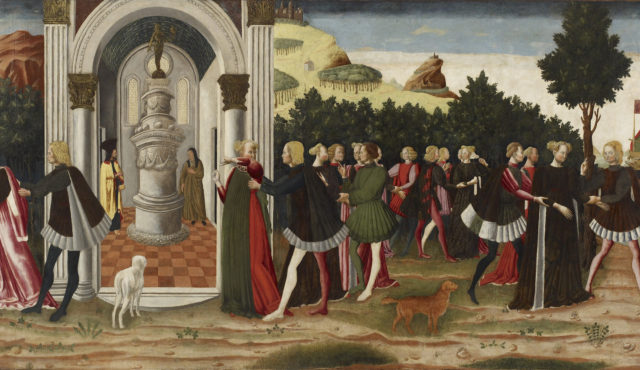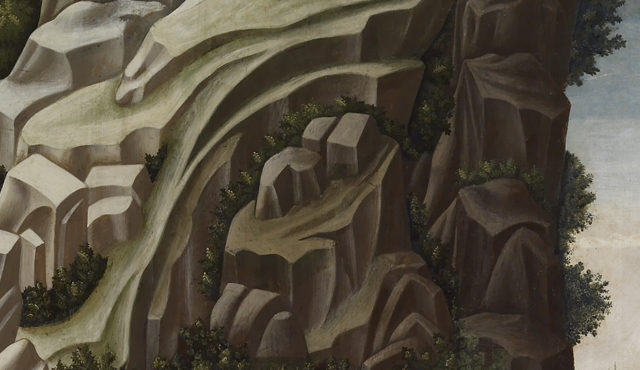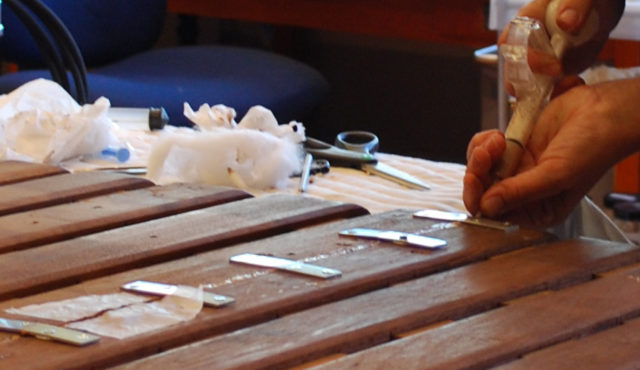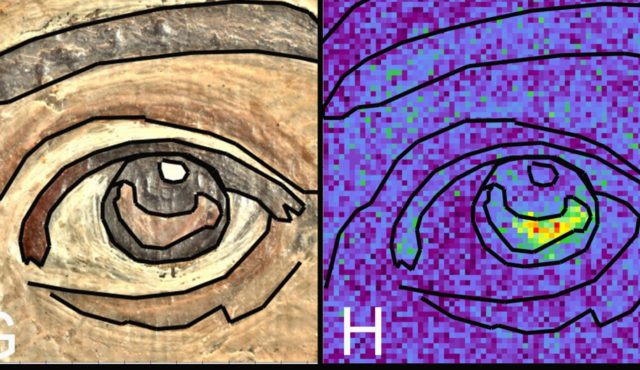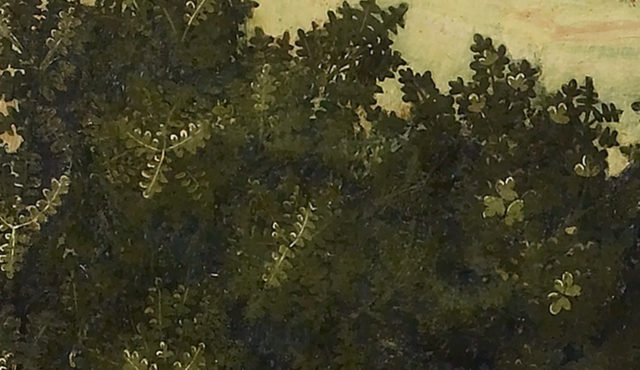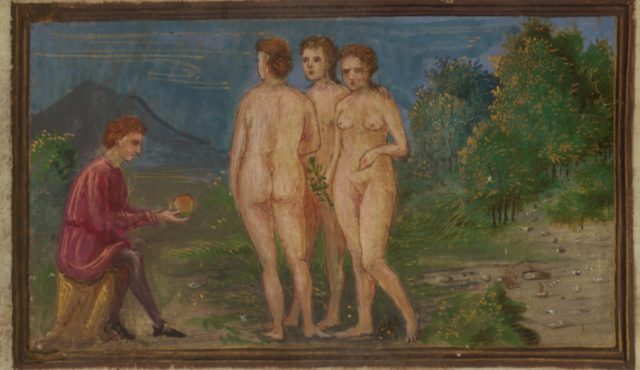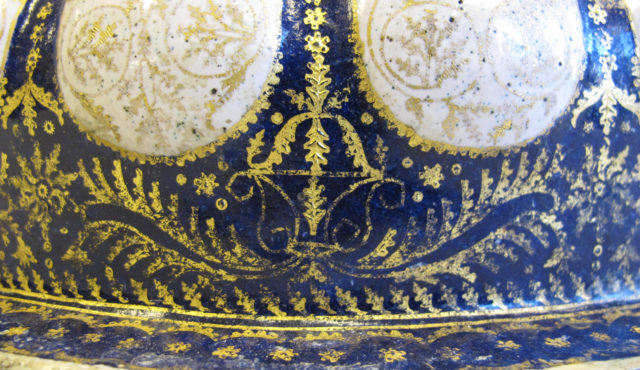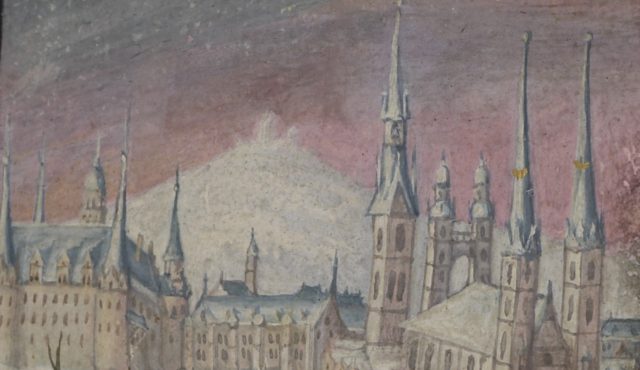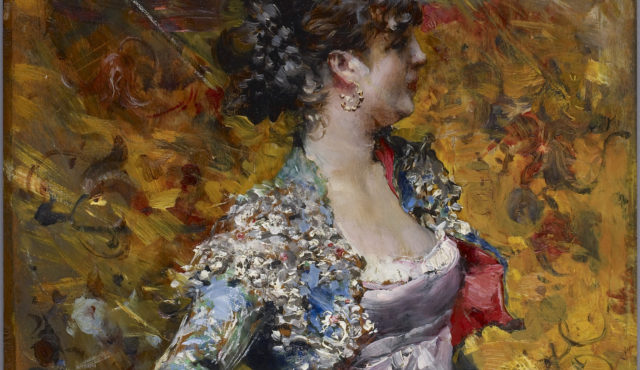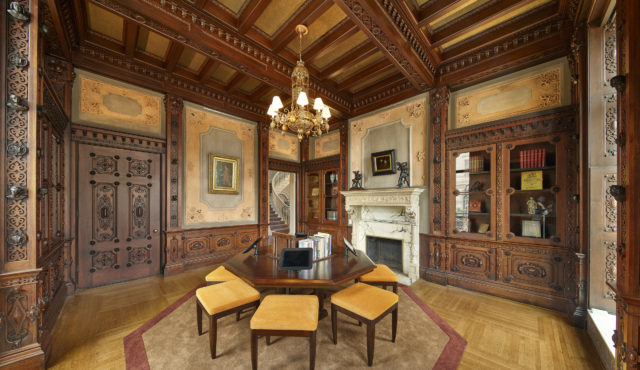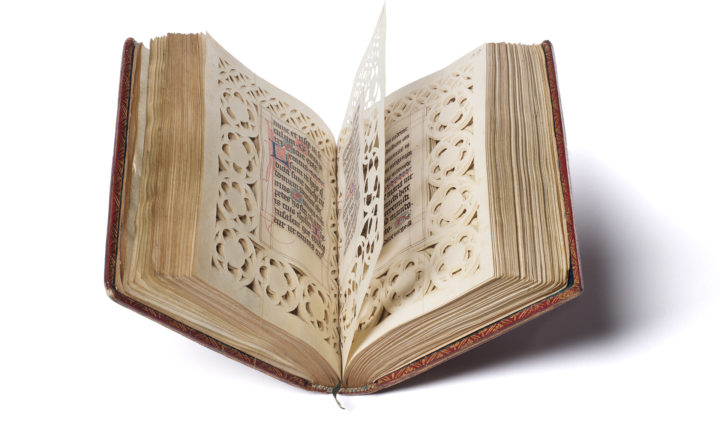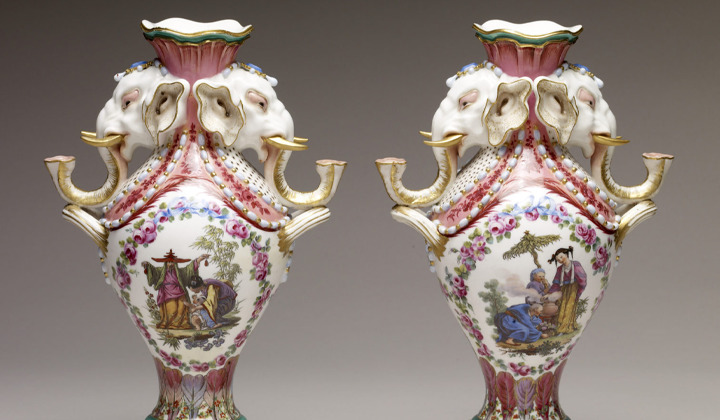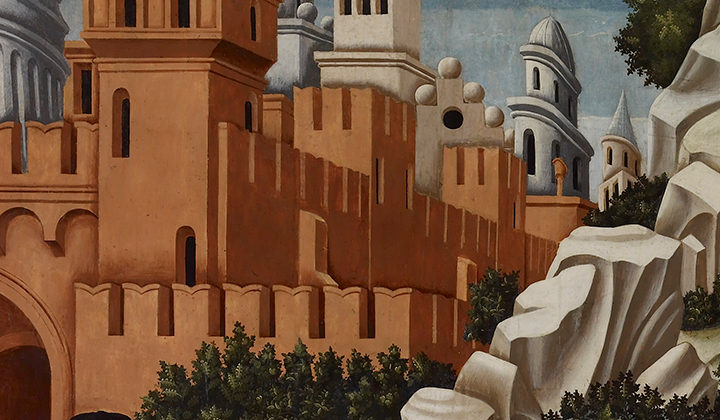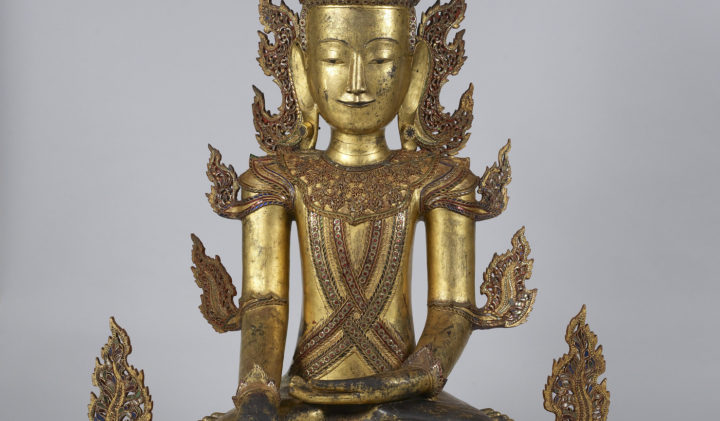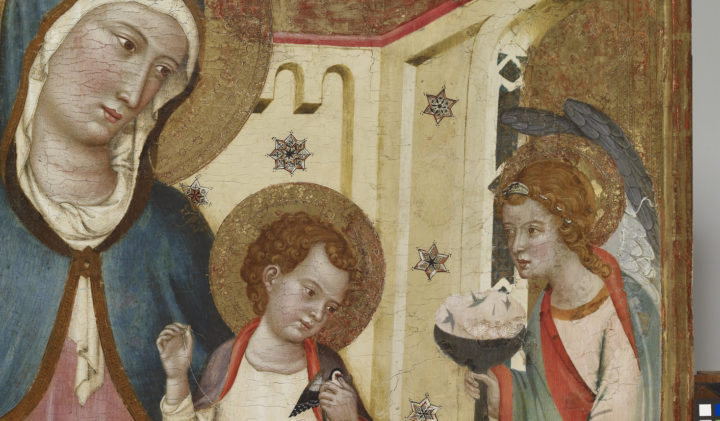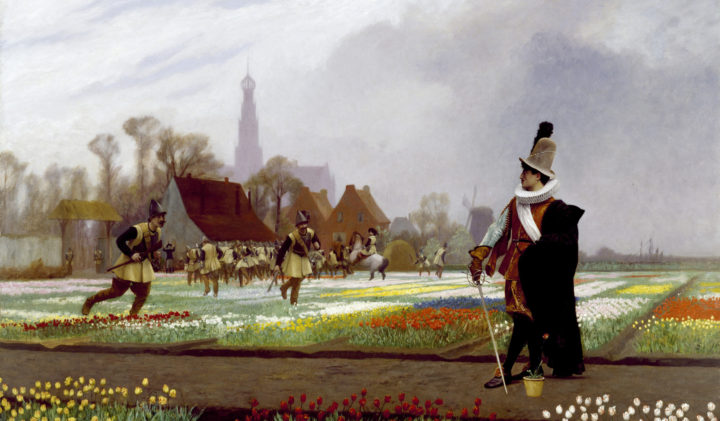The series of three very large panel paintings in the Walters Art Museum that are the focus of this essay depicts the abduction of Helen, queen of Sparta by the Trojan prince Paris: The Departure of Queen Helen and Her Entourage for Cythera, The Abduction of Helen from Cythera, and The Reception of Helen at Troy (fig. 1). They are here attributed to the Paduan-trained painter Dario di Giovanni and collaborators as part of an extraordinary, larger commission of five or six paintings carried out in Venice around 1468–1469 in celebration of the proxy marriage of the young Caterina Corner (1455/56–1520) with Jacques II Lusignan, king of Cyprus, in July 1468.[1] No document specifically referencing the commission has been identified; however, the multiple components of this proposal are sufficiently intertwined for a working hypothesis about the painter, the subject, and the occasion for the commission. The paintings are remarkable for their qualities as history paintings (istorie [plural] in contemporary usage), including technical features that surely dazzled contemporary viewers, and for the perspectives they offer on significant gaps in current knowledge of Venetian domestic painting in the 1400s.[2]
This new characterization of the series constitutes a major change: the paintings were previously assigned to various artists over time but principally to the “Master of the Stories of Helen,” in the Venetian circle of the Vivarini family, with datings ranging from 1445–50 to the later 1460s, the latter finding more adherents.[3] There has been no specific proposal as to their function, which, given their size, is a primary consideration. However, the Walters paintings have rarely been on public view, residing in the museum’s storage for decades and for several years in conservation.
The paucity of extant secular panel painting in Italy outside of Tuscany for this period means that there are not many works with which to compare them. Building an argument for a new reading of the Abduction of Helen series calls for a new approach, beginning with a basic description of the series’ essential features.
Constructing an Initial Frame of Reference
The Abduction of Helen series comprises three immense Italian fifteenth-century panel paintings with a total width unframed of 306 inches (778 cm, originally slightly wider), painted in tempera on spruce panels with applied Pressbrokat detailing, representing a subject taken from ancient history: the abduction of Helen, queen of Sparta, by the Trojan prince Paris. They were acquired by Henry Walters after 1905, when they were auctioned in a sale in Rome, and before 1915, when they are referenced in an article by art historian Bernard Berenson as being in Walters’ collection.[4] Two other extant paintings were certainly part of the same overarching commission (and possibly a third).
The Walters panels are spalliere, paintings generally installed at shoulder height (spalla = shoulder) or higher, depending on the height of the actual painting and of the ceiling), set into woodwork or molding, sometimes suggesting the conceit of an open window through which history appears to come alive.[5] The development of this type of panel painting is associated with Florence in the second half of the 1400s, and the only earlier or larger known monumental spalliera series is Paolo Uccello’s three-part Battle of San Romano, ca. 1438–1440 (fig. 2), with a combined width of 377 inches (957 cm).[6]

Paolo Uccello (1397–1475), The Battle of San Romano, ca. 1438–1440. Tempera on poplar. Left: National Gallery, London, NG 583, 71.6 × 126 in. (182 × 320 cm); center: Gallerie degli Uffizi, Florence, 1890 no. 479, 71.6 × 126 in. (182 × 320 cm); right: Musée du Louvre, Paris, MI 479, 71.6 × 125 in. (182 × 317 cm). London: © The National Gallery, London; Florence: Scala / Art Resource; Paris: © RMN-Grand Palais / Art Resource, NY
The earliest provenance documentation (see Coda) places the Walters series in England in the 1800s, at which time the three panels were together with two other panels, a Garden of Love and a Garden Wall with a Trellis of Roses (figs. 3, 4). If five fifteenth-century paintings, inter-related by artist, theme, and physical characteristics, were together in the 1800s, it is a reasonable assumption that they were from the same commission and, given the combination, celebrated love and marriage.
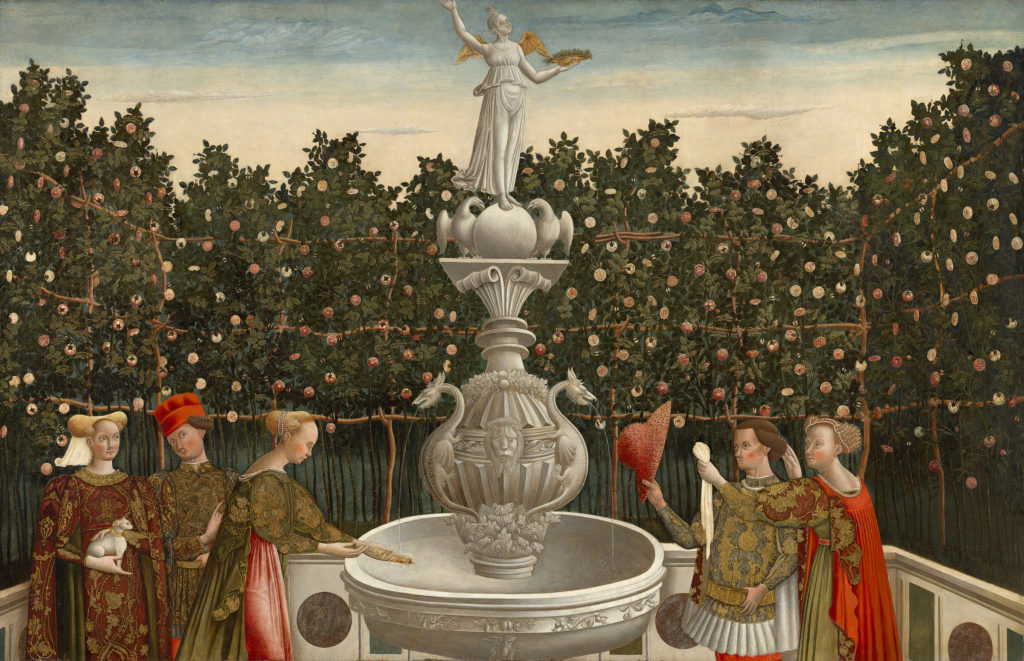
Master of the Stories of Helen, Studio of Antonio Vivarini (attributed here to Dario di Giovanni and collaborators), The Garden of Love. 60 1/16 × 94 1/16 in. (152.5 × 239 cm). National Gallery of Victoria, Melbourne, Felton bequest, 1948, acc. no. 1827/4
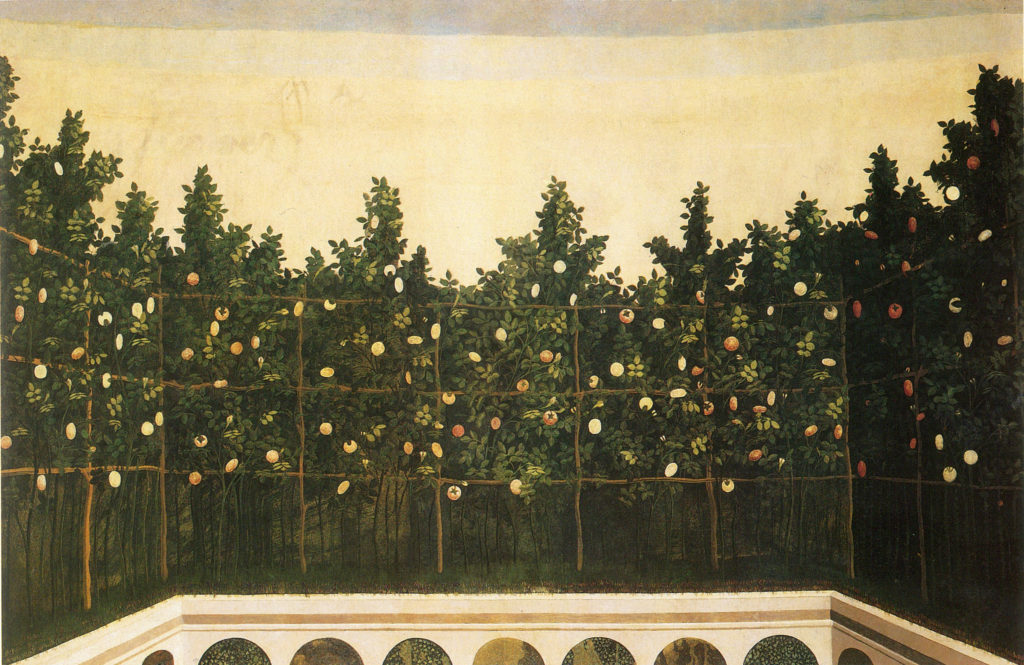
Collaborator of Dario di Giovanni (from the Vivarini family workshop?), Garden Wall with a Trellis of Roses, ca. 1468. Tempera on spruce, 60 × 92 in. (152.5 × 233.5 cm). Private collection, Venice
Three factors affect a discussion of geographical origins. The geographical indicators point to the Veneto, which would be consistent with the traditional attribution to a Venetian artist working in the circle of the Vivarini family workshop in the 1460s or possibly earlier. Any attempt to place the panels at a distance from the Veneto bears an extra burden of proof. First, spruce, in place of the traditional poplar, does not appear to have been used as a support in Italy outside of the Veneto or Lombardy.[7] Second, the extensive presence of Pressbrokat, a special technique for simulating the richest brocades with glittering surfaces of gold and silver threads (for which see Betts and Gates, “Dressed in Tin,” in this volume), is truly extraordinary, especially for a secular history painting, in which context it appears to be otherwise undocumented. It would most certainly convey magnificence. While Pressbrokat is widely encountered in Northern Europe, its use in Italy outside of the Veneto and Friuli is also undocumented. The only extant, traditional usage in Venice is the 1446 Altarpiece with Madonna and Child with Saints (Galleria della Academia, Venice), of which the lead painter was Giovani d’Alemagna (from Ulm), whom Dario knew in Padua. Third, the adaptation of a type of Roman altar characteristic of the region around Padua has been identified otherwise only in the work of other artists active in the region, including Giovanni d’Alemagna.
Five large paintings on inter-related secular subjects for domestic spaces within the same palace constituted a very sizable commission for a private patron or artist in the 1400s. The subject matter indicates a wedding, while the attention to magnificence expressed through clothing points to one of significance, within the highest rungs of society.[8] Although an important wedding normally enlarged a family’s sense of identity, there is no obvious reference to a family, even a family device: just a single initial (“C”) on the queen’s pennant in the first painting. As this is a striking, large-scale representation of ancient history, and Trojan history at that, for a domestic space, what families in the region were most likely to have embraced this form of self-representation?
Were there wealthy, elite (probably noble) families of the Veneto who celebrated major marriages during this period, marriages for which an extraordinary level of magnificence framed through allusions to ancient history was appropriate? My research yielded only one marriage and family consistent with the cited properties and their implications: the extended Corner (written “Cornaro” in the rest of Italy), family, one of the oldest and wealthiest noble families of Venice, with palaces dotting the city and a wedding to celebrate in 1468, the consequences of which would reverberate throughout the Venetian Republic.
History Paintings for the Private Sphere in Venice
For all the glories of large-scale narrative painting for public spaces in Venice during the 1400s that Patricia Fortini Brown and many others have extensively documented, very little has been established regarding this category of domestic painting from the 1400s in Venice.[9] Perhaps one reason for the mysterious absence of evidence for domestic secular wall painting in Venice (versus, for example, Florence and the Venetian mainland) might be that many were probably executed in fresco, a medium popular and long lasting for domestic decoration on the Venetian mainland but gradually destroyed by damp in the atmosphere of the lagoon.[10] Wall decoration might also involve various kinds of hangings including Flemish tapestries, often millefleurs (a pattern of scattered flowers), mentioned in existing inventories.[11] With their rich textures and gold and silver threads, they contributed to an atmosphere of luxurious décor valued by the Venetian elite, but these also disintegrate in damp conditions. Indeed, the defining physical impact of the Walters spalliere—their size and the effect throughout of simulated rich brocades, complete with the illusion of gold and silver threads (due to the Pressbrokat)—might indicate that the series was conceived in part to compete with or replace more expensive but fading Flemish tapestries that did not lend themselves to shaping an iconographic program, especially as there was as yet no Italian center for tapestry production.
The current state of knowledge of fifteenth-century commissions for large-scale history painting for the domestic sphere in Venice could be described as a vacuum with bookends, both of the latter, as it happens, supplied by members of the Corner family. The earliest evidence for istorie in a domestic palace in Venice of which I am aware is from 1437.[12] In that year Giovanni d’Alemagna (1399–1450) was commissioned to paint for a chapel in the palace of Pietro Donato, the bishop in Padua, a series of istorie with a border of simulated porphyry and serpentine as he had done “in la casa de messer zuan Corner a Vinexia,” thus, “in the palace in Venice of the Sen. Giovanni Corner,” the Venetian magistrate or podestà of Padua (born 1374), most likely for the family palace in Venice acquired by his father, Cav. Federico Corner, and uncles in 1364.[13] This palace, now known as Ca’ Loredan for the family to whom it passed, was the one where in 1366 the Corners hosted Peter I Lusignan, king of Cyprus, with consequences for the founding of the branch of the family (known as Piscopia [for their estates in Cyprus]) that would dominate the sugar trade between Venice and Cyprus.
The next previously identified large-scale history paintings that are probably for a Venetian palace were created by Vittore Carpaccio in the last years of the century. They include The Story of Alcyone (Philadelphia Museum of Art), though no location or patron has been proposed.[14] It is not until 1505 that we have a documented commission of surviving paintings: four canvases (of which two were delivered) for Francesco Corner (a nephew of Caterina Corner) contracted with Andrea Mantegna and after his death, partially carried out by Giovanni Bellini (fig. 5). They address the virtues of the Corner family’s Roman ancestors of the Cornelia line (including most famously the general P. Cornelius Scipio Africanus) for a camerino (small chamber) in a family palace.[15] Two examples do not demonstrate a long-term pattern of commissions, but, in the absence of evidence of commissions by other families, they suggest receptivity toward a role for art in self-representation.

Giovanni Bellini (1431/36–1516), The Continence of Publius Cornelius Scipio, Known as Africanus, after 1506. Oil on canvas, 29 7/16 × 140 1/4 in. (74.8 × 356.2 cm). National Gallery of Art, Washington, D.C., Samuel H. Kress Collection, 152.2.7
Where would spalliere such as the Walters’ have been displayed? In late medieval and Renaissance palaces in Venice, the layout was quite standardized, so that even though floor plans of Corner palaces from the 1400s have not survived, certain assumptions are justified.[16] The portego, the large gallery running from front to back on the main living floor, might be hung with tapestries or, at least by the 1500s, with paintings. This was an essentially public space off which opened private chambers where important visitors would be entertained. The Walters series could have been installed in one of the latter.[17] The two large companion paintings making up a garden of lovers (see fig. 3 and 4), part of the same commission, would have been for a separate chamber, a more intimate camerino, where, given the angle of vision, they might have been installed closer to eye level so that persons entering the space would feel delightfully surrounded by nature and affection.[18]
Venice and the Corner Family
For the last half of the 1400s the Republic of Venice, centered in the city perched on islands in the midst of the lagoon, as represented by Erhard Reuwich in 1486 (fig. 6), was at the height of its prosperity and influence on the international stage as a great maritime power (fig. 7).[19] Its stato da màr (maritime possessions) stretched along the eastern coast of the Adriatic from Istria to Dalmatia, Albania, ports in the Peloponnese, Cythera, the Greek archipelagoes, and Crete, reaching its eastward apogee with the acquisition of Cyprus in 1489, all steps on the spice and luxury goods routes to Alexandria, Antioch, and Constantinople. In the first half of the century, Venice expanded and deepened its control of cities on the mainland, its terrafirma, including in 1406 the university city of Padua. The fame of Venice owed much to its projection of magnificence, which in turn owed a great deal to the palaces of its nobility, among which were three belonging to the extended Corner family that are relevant to this essay: the casa (“house”; Venetians used “palazzo” only for the doge’s palace) known as Ca’Corner at San Cassiano, which is where Caterina grew up, where the Walters Abduction series most likely hung (fig. 8, with 18th-century facade), and which was later known as Ca’Corner della Regina (“of the queen”), referencing its use by Caterina after her abdication;[20] Ca’ Corner (Loredan, the family to whom it passed); and Ca’ Corner della Ca’ Granda, celebrated by 1500 as the palace of the “magnificent knight Zorzi (Giorgio) Corner, brother of the queen of Cyprus.”[21]

Erhard Reuwich (ca. 1455–1490), Panorama of Venice, foldout page from Bernhard van Breydenbach, Peregrinatio in Terra Sanctam (Mainz, 1486). Woodcut. The Walters Art Museum, Baltimore, bequest of Henry Walters, 1931, acc. no. 91.283

The Venetian Maritime Dominions in 1489

Ca’ Corner della Regina, façade (18th century) facing the Grand Canal, Venice
Nevertheless, conditions were changing that already by the turn of the century would reduce the republic’s prosperity and power, underlining the importance of controlling Cyprus. The first, in 1453, was the Ottoman conquest of Constantinople, capital of the Byzantine Empire. Although trading relations with Mamluk Egypt had long been to mutual benefit, the growing territorial ambitions of the Ottomans and the Venetian defeat in the Battle of Zonchio in 1499 were a shock. The year before, the Portuguese arrived in Calicut, having round the Cape of Good Hope, becoming the first Europeans to reach the spice markets of Asia by sea, opening new trade routes for these profitable commodities that bypassed Venice.
The Corner, like much of the Venetian nobility, were merchants, and therefore vulnerable to such shifts. However, many of them rose to high office in the government of the republic and in the Catholic Church.[22] Another aspect of their dignity in the eyes of Venetians was their antiquity, not only in their involvement in the affairs of Venice back at least to the seventh century, but in their accepted claims of Roman ancestry as descendants of the gens Cornelia. This claim was to become an element in the pedigree of young Caterina as queen, expressed, for example, by the poet Bartolomeo Pagello in his poem on the wedding “De nuptiis Zachi Cypriorum regi et Catherinae Corneliae ex sanguine Venetorum,” (On the nuptials of Jacques, king of the Cypriots, and Catherine Cornelia of the blood of the Venetians”) written between 1468 and 1473.[23]
There is little documented or to be surmised about Caterina prior to the discussions surrounding the marriage.[24] Born in 1455 or 1456, she apparently received the convent education (in Padua) of a young girl of her class, with little else to distinguish her. Everything changed when the proposal was put to Jacques II Lusignan of Cyprus that marrying her might be a more attractive option than other family alliances in the region might offer. While the Corner family line could not claim royal blood, Caterina could, through her mother, Fiorenza Crispo, a niece of the emperor of Trebizond. More to the point, the king owed tens of thousands of ducats to Marco Corner. The astonishing dowry of 100,000 ducats he offered (versus the official limit of 1,600 ducats) would more than eliminate the king’s debt.[25] The island of Cyprus needed protection, which Venice could offer. For Marco Corner and his family, the prestige and social value of having performed such a level of service to the state was incalculable; indeed, members of the Venetian Senate were apparently already thinking about how to shape such a marriage alliance into an opportunity to gain control of Cyprus, the last remaining stepping-stone to eastern Mediterranean markets that Venice did not already control.[26]
In connection with the negotiations, a portrait of Caterina as a prospective bride, to be sent to Jacques for his approval, was said by her earliest biographer, Antonio Colbertaldo (1556–1602), to have been commissioned from “Dario da Treviso” (Dario di Giovanni, ca. 1420–before 1498).[27] There is no reason to doubt this statement, as it is impossible to imagine a young king at this period not insisting on a portrait, whether or not one is cited in surviving documents of the negotiations.[28] Though Dario was associated with numerous noble patrons and major projects (few of which survive), he was hardly so well known as someone like Jacopo Bellini, whose name Colbertaldo could have inserted if it was a question of inflating the portrait’s prestige after the fact.[29] In any case, Dario’s skills at rendering a nuanced profile of a young woman are demonstrated in the Walters Departure (fig. 9) and in his two extant donor portraits. In republics such as Venice or Florence, elite families normally sought allegiances (and brides) locally, so there was no tradition of such portraits in either city.[30] It was, however, a common practice for European rulers in the 1400s in connection with long-distance searches for a bride.[31] Examples abound. King Charles VI of France (ca. 1380–1422) sent a painter to three royal courts before marrying Isabeau of Bavaria (1371–1435).[32] In 1442, Henry VI of England commissioned portraits of the daughters of the count of Armagnac depicting “their beaulte and color skynne and their countenaunces, with al maner of features.”[33] In Italy, for example, the Sforza court portraitist in Milan, Bugatto Zanetto (ca. 1433–1476), was called upon at least twice to produce portraits of prospective brides.[34] According to a diplomatic report, Jacques had previously been shown the portrait of the niece of Pope Pius II in connection with a potential deal (which Jacques declined) that the pope would crown him (giving him legitimacy) if he married her.[35] The portrait of Caterina is presumed lost, but it prompts the question: What did Caterina look like?
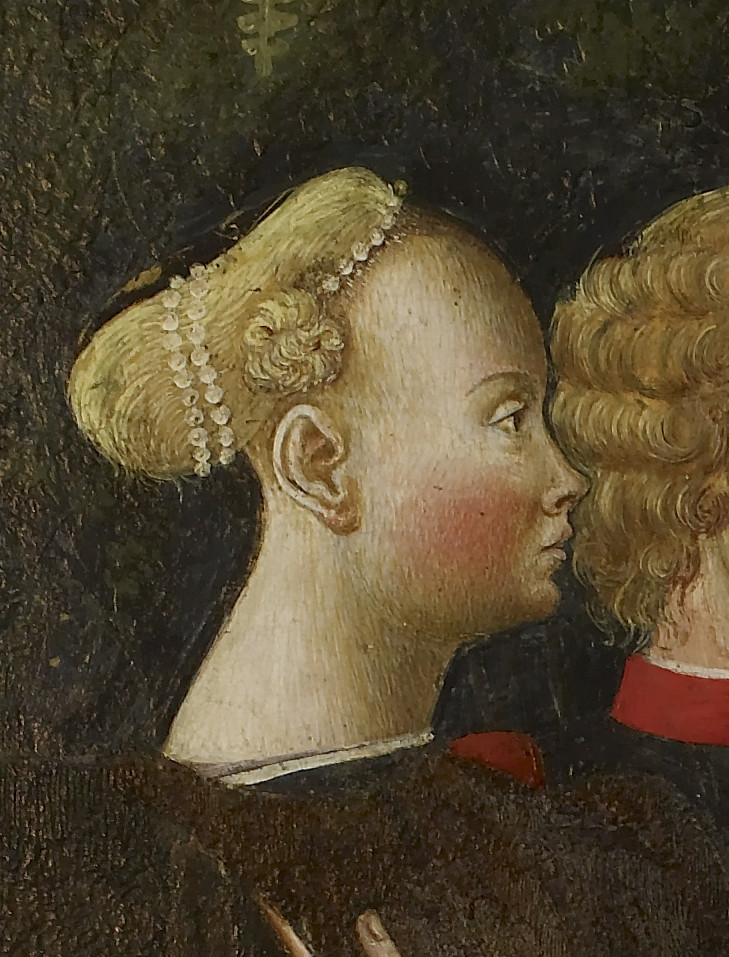
Detail from the Abduction
Again according to Colbertaldo, Caterina was “a young girl of about age fourteen whose face resembled the clear sky, the cheeks had no reason to envy vermilion roses, lips in the likeness of coral with teeth like little pearls, milk-white breasts, black eyelashes, eyes shining like two burning stars, and golden hair.”[36] Perhaps Caterina did look like that, but in any case, irresistible beauty that could arouse desire was called for in a royal bride, and what constituted irresistible beauty was codified in literature and the visual arts during the period. Colbertaldo’s description is conventional and nearly identical to those of so many historic paragons of female beauty, including those by the fourteenth-century humanist Francesco Petrarch of his beloved Laura, which were ingrained in the contemporary elite imagination.[37]
The unresolved question of Caterina’s appearance brings to the fore a sixth painting (fig. 10), tied to the others by manner, support, and use of Pressbrokat but not by provenance: a young girl, her blond hair tied up casually and wearing the same cut of dress as the older of the two girls in the Walters Departure, playing with a unicorn, a traditional symbol of chastity or virginity. In this context it could well be an allegory of “Caterina Corner as Chastity.”[38] There is a generic similarity of the face and that of Helen, but it is most unlikely that this is the “prospective bride” portrait, which would be a close-up depiction. It may be an earlier gift for a family member or tutor.
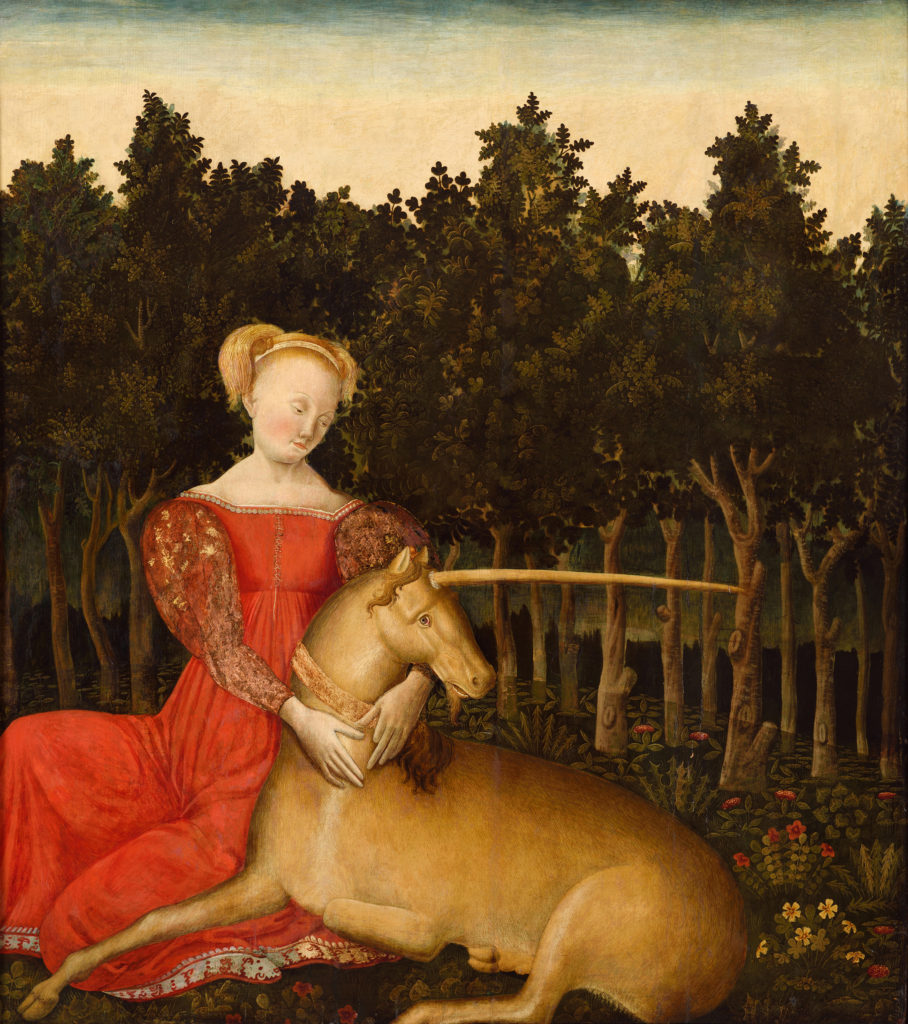
Dario di Giovanni, Caterina Corner as Chastity, ca. 1467–68. Tempera and Pressbrokat on spruce, 39.4 × 35.4 in. (100 × 90 cm). Keresztény Múzeum, Esztrogom, no. 13-18, 55.212. Photograph Mudrák Attila
Apparently, the portrait did its work. On July 31, 1468, Caterina was married in Venice to Jacques II of Cyprus, represented by his proxy, the Cypriot ambassador Philippe Mistachiel. The wedding was treated as a major civic event, enacted with all the fanfare for which Venice was so famous; and the ceremony took place not in the Corner palace but in the great ritual spaces of the ducal palace, with Doge Cristoforo Moro acting in place of Caterina’s father, Marco.[39]
Thus began Caterina’s metamorphosis from Caterina Corner, daughter of Marco Corner, not only to queen of Cyprus (which she became instantly, even though she would not join her husband in Cyprus for four years) but to “daughter of Venice,” an appellation with legal connotations that would deeply affect her life.[40] As the historian and poet Pietro Bembo put it, “It was from the Senate that he [Jacques Lusignan] had taken Cornelia [of the Cornelian line] to wife, taken on, as it were, as a daughter of the Republic (reipublicae filiam) guaranteed by the state.”[41] Similarly, the attendance of “Serenissima Domina Catherina Cornelia Veneta Regina Cypri” (the Most Serene Lady Caterina Cornelia Veneta, Queen of Cyprus” was noted at a state event in 1469.[42] Much the same wording was used by the poet Bartolomeo Pagello in a poem written between the years 1468 and 1473 celebrating the wedding.[43]
In quick succession after her happy reception in Cyprus in 1472, Caterina became pregnant; her husband the king died of a stomach ailment under somewhat suspicious circumstances, causing Caterina to become regent for her unborn child; and her son was born but died before his first year. Caterina now ruled as queen in her own right, a momentous expansion of responsibilities, but with the political and sometimes military support of her parent, Venice.[44] In the following years, pressure would grow on Caterina to abdicate in favor of this parent, and at last in 1489, under pressure from her brother Giorgio (subsequently knighted for his efforts), she acceded.
Her return to Venice and the act of handing over her crown to the doge were treated with the utmost ceremony, giving every public sign of the republic’s gratitude for her personal sacrifice and statesmanship, qualities they were not accustomed to acknowledging in a woman.[45] Of course the senate was overjoyed to have at last acquired Cyprus, and without firing a shot. On the basis of this act, the fortunes of her brother Giorgio soared, and Caterina retired to a fiefdom created for her by the republic on the terrafirma at Asolo, where she patronized poets and humanists as a manifestation of royal status while staying away from politics, with the exception of tireless efforts, primarily behind the scenes, to secure her family’s fortunes and continue support for Cyprus.[46] Portraits of Caterina by Gentile Bellini from around 1500, as that in Budapest (fig. 11), show her crowned but introspective.[47] Following the death of the “daughter of Venice” in 1510, the family’s claim on her as a Corner could at last take hold, generating a multitude of sculpture, portraits, and large-scale paintings on canvas celebrating her, but most especially re-creating her triumphal return to Venice and the gift of her crown.[48]
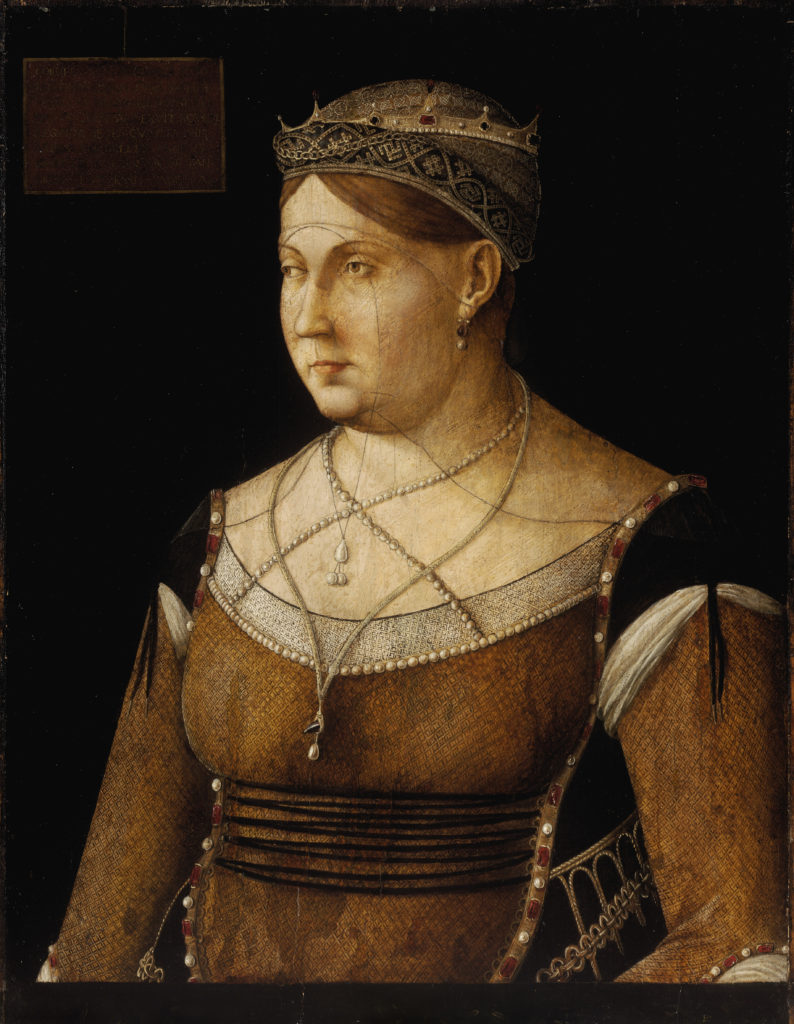
Gentile Bellini (ca. 1429–1507), Portrait of Queen Caterina, ca. 1500. Oil on poplar, 24.8 × 19.2 in. (63 × 49 cm). Szépművészeti Múzeum, Budapest. © The Museum of Fine Arts, Budapest / Scala / Art Resource, NY
The Painter
Dario di Giovanni, Caterina’s portraitist and proposed as painter of the Walters Abduction of Helen series, is something of an enigma. While there are many documents noting his responsibility for major projects on behalf of noble families or institutions, almost none of these paintings survive. On the other hand, the major surviving projects associated with him are not documented. The result is that past efforts to construct a body of work for Dario and/or the “Master of the Story of Helen” have depended on stylistic analysis. That this is not unusual for a period when few paintings were signed does not make the task easier.
The known attribution history of the paintings begins in 1905, when the paintings appeared at public auction in Rome with attributions to Vittore Carpaccio and to a “pedestrian imitator of Piero della Francesca.”[49] In 1915, by which time the paintings had been acquired by Henry Walters, Bernard Berenson established a fruitful framework by proposing that the artist was from the workshop or circle of Antonio Vivarini (ca. 1415–ca.1480, active in Venice and Padua).[50] Indeed both individual artists and altarpieces from the famous workshop, known for a lavish courtly style with elaborate clothing applied to exclusively religious subjects, exemplified by the Altarpiece of Santa Sabina of 1443 (fig. 12, detail) and the Adoration of the Three Kings, ca. 1445/47 (Gemäldegalerie, Berlin,), have since proved to be important for understanding the Walters paintings. In 1962 this attribution was refined to “The Master of the Story of Helen,” within the Vivarini circle.[51] This appellation was generally retained, including by Federico Zeri in his 1976 Italian Paintings in the Walters Art Gallery, adding the critical insight that the artist had adapted Roman altars characteristic of Padua, a motif shared with Giovanni d’Alemagna, Antonio Vivarini’s partner.[52]
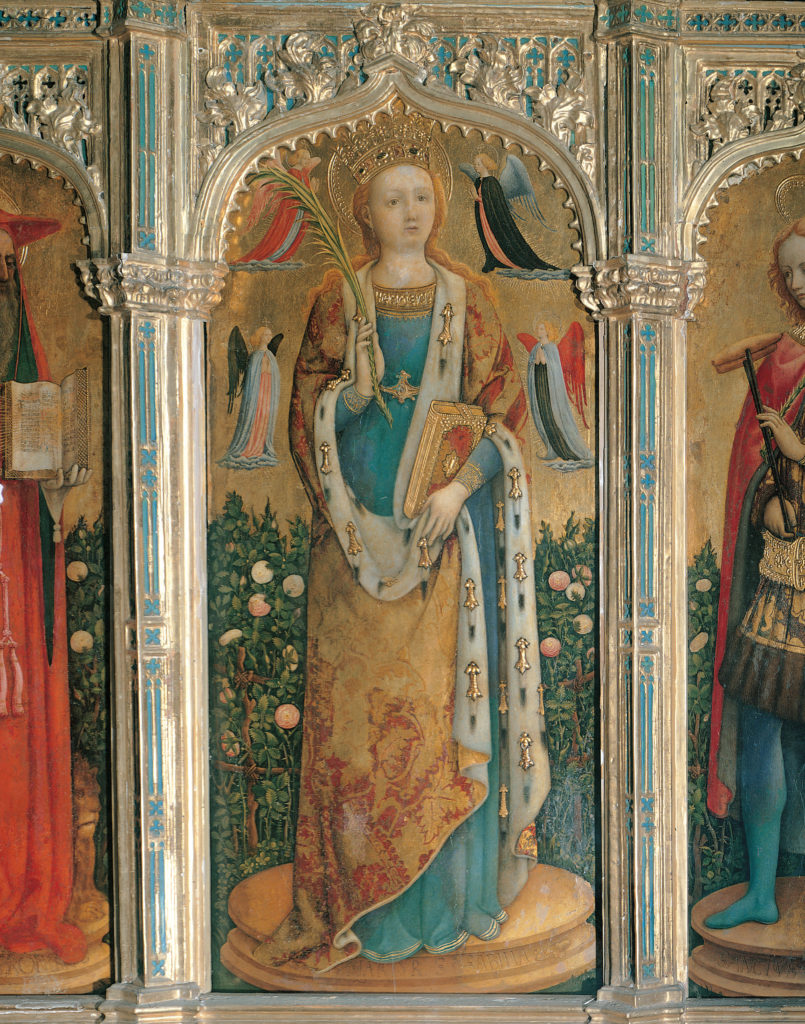
Antonio Vivarini (ca. 1415–1476/84) and Giovanni d’Alemagna (1399-1450), Santa Sabina Altarpiece, 1443: detail of lower register. Tempera and gold leaf on wood. Church of San Zaccaria, Venice
Zeri rejected, without comment, the attribution proposed by Luigi Coletti, in a footnote to his Pittura Veneta del Quattrocento (1953), to the Paduan-trained Dario di Giovanni (Dario da Pordenone, ca. 1419/1420–before 1498), previously little studied outside of regional histories.[53] Coletti associated Dario with the Melbourne painting (see fig. 3), a signed Madonna of Mercy (Museo civico, Bassano), the chapel of St. Nicholas in the cathedral of Pordenone (see figs. 18, 30), and frescos (facades or wall paintings) in Asolo (see fig. 15), Treviso, Serravalle, and Conigliano, drawing in part on extensive archival research on the artist published already in 1910.[54] Coletti’s attribution was supported by Italo Furlan, whose 1968 article Zeri does not cite, through illustrating convincing stylistic comparisons between the Pordenone frescos and the Abduction series.[55] Zeri’s rejection was followed by Miklós Boskovits (1977) and Giorgio Fossaluzza (2003), again without comment.[56] Recently (2019) Stephen Campbell has underlined the porosity of the artistic environment in Venice, with evident movement of artists between Tuscany and Padua/Venice, and sites in the Marches, as an important element in the interpretation of the Walters panels, a perspective fundamental as well to the following discussion.[57]
As in many large Renaissance paintings, there may be multiple hands responsible for what we see—in this case, independent collaborators as well as assistants. There is the craftsman responsible for the Pressbrokat, a distinct skill that appears not to have been practiced in Venice for some years, so that it is likely that he was invited to Venice for the purpose, possibly from the northern reaches of the Veneto, such as Udine, where the technique was practiced and where Dario had previously lived.[58] Some of the faces and possibly foliage (as in the Garden with Rose Trellis) could have been executed by a hand from the Vivarini workshop.[59] Finally, there are passages, such as the woman with the trailing white cape in the Departure, and the faces in lost profile, such as that of Helen in the Reception at Troy, that appear to draw on parallel solutions in the work of Piero della Francesca, as in The Legend of the True Cross in the Church of San Francesco at Arezzo (completed 1466) or his Madonna of Mercy, 1460–62 (Museo Civico, Sansepolcro), suggesting the participation of an unidentified assistant who had worked with Piero.[60]
Basic challenges to studying this painter resulting from the losses in his documented oeuvre are compounded by the multiple names by which he was and is known; however, these provide a brief itinerary of his career, reflecting the “gig” economy of his time (fig. 13).[61] He can be cited as “Dario da Pordenone,” referring to the town where he was born.[62] In the earliest known reference to Dario, concerning his entry into the studio of Francesco Squarcione in Padua in 1440, he is “Dario de Utino, filius Johannis, Pictor vagabundus”: Dario of Udine, son of Giovanni, a vagabond painter.[63] “Dario da Treviso,” referring to where he lived around 1449–1458 and where began to draw significant attention, is how he is known to Giorgio Vasari in his “Life of Andrea Mantegna” (1568), as well as to the seventeenth-century commentator Carlo Ridolfi. [64] In 1462 Dario is cited as “depentor de Asollo,” where he lived and worked around 1459–1466, the period in which his mature style came to the fore.[65] A posthumous citation of 1498 references “Darius pictor de Conegliano,” where he is documented between 1471 and 1477).[66]

Cities in the Veneto where Dario was active
The range of known commissions is wide, from entire chapels, altarpieces, portraits, and facades of palaces and churches, many for noble families.[67] He was paid for several jobs involving council chambers of the local governing magistrates (podestàs) including those in Bassano, Conegliano, and in the doge’s palace in Venice.[68] Like many successful artists of the time, he also carried out humble tasks; for example, in 1451 he touched up a polychrome wooden processional crucified Christ.[69]
Surveying Dario’s career for important, documented milestones offers a sense of the environments that shaped him and his profile for contemporary patrons. As this is not a survey of his artistic endeavors, attributed works of art referenced here are limited to a few projects from the years just preceding the Corner commission.
Although Dario probably received his initial instruction from his father, Master Giovanni, who remains otherwise unidentified, the major early influence on his artistic development was his years in Padua from 1440 to 1448, then one of the more fertile and diverse art centers in Italy. The period from 1440 to 1446 was spent as a pupil or salaried assistant of Francesco Squarcione (ca. 1395–after 1468), known less for his own paintings than for the tens of young artists who trained there and for his collection of antiquities, which he made available for study.[70] In the 1440s his students included the brilliant, ambitious young Andrea Mantegna (1431–1506; with Squarcione, 1440–1448), generating a competitive environment of which, according to Vasari, Dario was very much a part. In 1446 Dario was paid for his first known work, an important commission from the Basilica di Sant’ Antonio, the full-length Portrait of Bernardino da Siena (Museo Antoniano, Padua) representing the future saint after his death (1440) and prior to his canonization in 1450.[71] This project was also the first of many for a noble patron, Jacopo Pappafava.[72] The years 1446–1447/48 were spent in a partnership with the little-known Pietro de’ Mazzi, any products of which are unidentified.[73]
Beyond the stimulus of the workshop, there was much to absorb from the city’s active and varied artistic environment.[74] Looking back from the vantage point of the later 1460s and the Walters paintings, contacts made and approaches absorbed here remained with him throughout his artistic development. Artists practicing in Padua included Giovanni d’Alemagna (active in the city since the 1430s) and Antonio Vivarini, at work in the Ovetari Chapel in the Church of the Eremitani (from 1448), as were Niccolo Pizzolo and Mantegna, the latter subsequently taking over the project to create one of the most influential set of frescos of his time (see figs. 35, 36).[75] A strong conservative but stylish contingent encompassed Giovanni Francesco da Rimini (ca. 1420–1470) as well as numerous German sculptors and carvers. The imprint of Florence was significant: works by Pietro Lamberti and Filippo Lippi were to be savored, and in 1443, Donatello arrived, bringing a new way of thinking about space, architectural principles, and perspective to enhance narrative, represented by his sophisticated relief The Miracle of the Miser’s Heart (fig. 14) with its remarkable barrel-vaulted interior, completed around 1447 for the high altar of the cathedral. In 1445 he was joined by Paolo Uccello (1397–1475), who carried out a now-lost fresco cycle in the palace of the Vitalini family. To judge from Dario’s later surviving work, including the Abduction series, he was affected by these contemporary approaches, but also by the forceful characterization of form, especially of the face, seen in the great fresco cycles by earlier generations that abounded in Padua, as those in the Church of the Eremitani or the palace of the Carrara family by Guariento di Arpo (1310–1370).
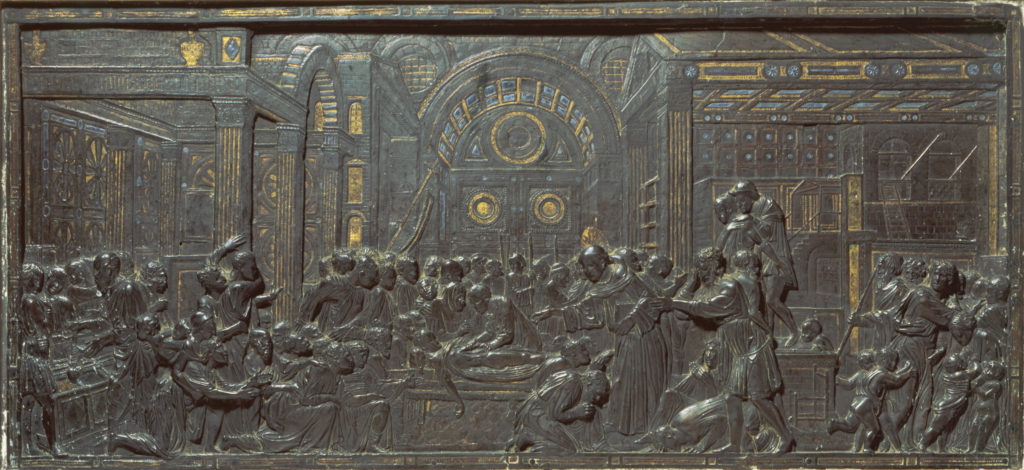
Donatello (Donato di Niccolo di Betto Bardi, ca. 1386–1466), The Miracle of the Miser’s Heart, ca. 1447–48. Bronze, 22 7/16 × 48 7/16 in. (57 × 123 cm). Altar of the Basilica di Sant’Antonio, Padua
Of the works that can be assigned to Dario’s first decade after leaving Squarcione and settling in the less demanding environment of nearby Treviso, the most important are lost.[76] In 1456 he was commissioned to carry out the decoration of an entire chapel in nearby Quinto belonging to the Venetian admiral and member of the governing Council of Ten, Orsato Giustiniani (d. 1464).[77] Nothing remains beyond the documents; its loss for understanding the artist’s development is great, as the Giustiniani were one of the ancient noble families of Venice (with ties to the Corner); Orsato, as a wealthy, worldly member of the Council of Ten, could have employed someone better known. It was also in 1456, apparently as a result of the frescoed chapel for Giustiniani, that Dario was called to Venice to exercise his skills as a painter in the Palazzo Ducale, the most prestigious site for a painter in the Venetian Republic.[78] The two existing documents initially refer to the artist as “the painter who had painted the chapel of N. [nobile] H.[homo] Orsato Giustinian” (pittore che dipinto aveva la capella del N.H. Orsato Giustinian). The second, indicating that he has gone to Venice, mentions his name. This suggests that the invitation was to the painter recommended by a member of the Council of Ten. The surviving reports do not indicate what he was to paint; so possibly the job was not to paint but to re-paint. Given that the immense frescos of earlier generations, the glory of the spaces they occupied, were subject to decay from damp, which the authorities sporadically made efforts to address, it is conceivable that Dario, practiced in fresco, a medium no longer common in Venice, was called in to touch them up.[79]
In the decade preceding the Corner commission, much of it spent in Asolo (ca. 1459–1465), Dario’s style, as judged by the greater number of extant paintings assignable to this period, evolved into the mature manner manifested in the Walters paintings.[80] The major surviving project from this period attributable to him involved interior and exterior fresco decoration of the medieval church in Asolo now known as San Gottardo.[81] Only scattered, partial figures remain, but some of the saints’ heads establish a continuity of style with the later Walters paintings (fig. 15), as Edward King, writing in 1939, was the first to note.[82] Two heads offering the most compelling comparisons are those of St. Chiara in the grouping of St. Gotthard between Saints Bonaventure and Chiara, and that of a Franciscan, possibly St. Francis (?), looming above from what reads as a different (subsequent?) campaign also by Dario.[83] The chiseled features with the long nose extended into an arcing eyebrow are characteristic; when carried over into panel painting, they retain the strengthened features developed for fresco. Close by there is a further intriguing fragment that has gone undiscussed (fig. 16). Above the coat of arms (unidentified) is a portion of a man’s fur trimmed outer garment in a contemporary, secular style, potentially belonging to a figure (wearing a sword) “presenting” the coat of arms.[84] This distinctive treatment, identical to parallel passages in the Walters Abduction, provides a clear, specific tie between the two painting projects, virtually a little signature.
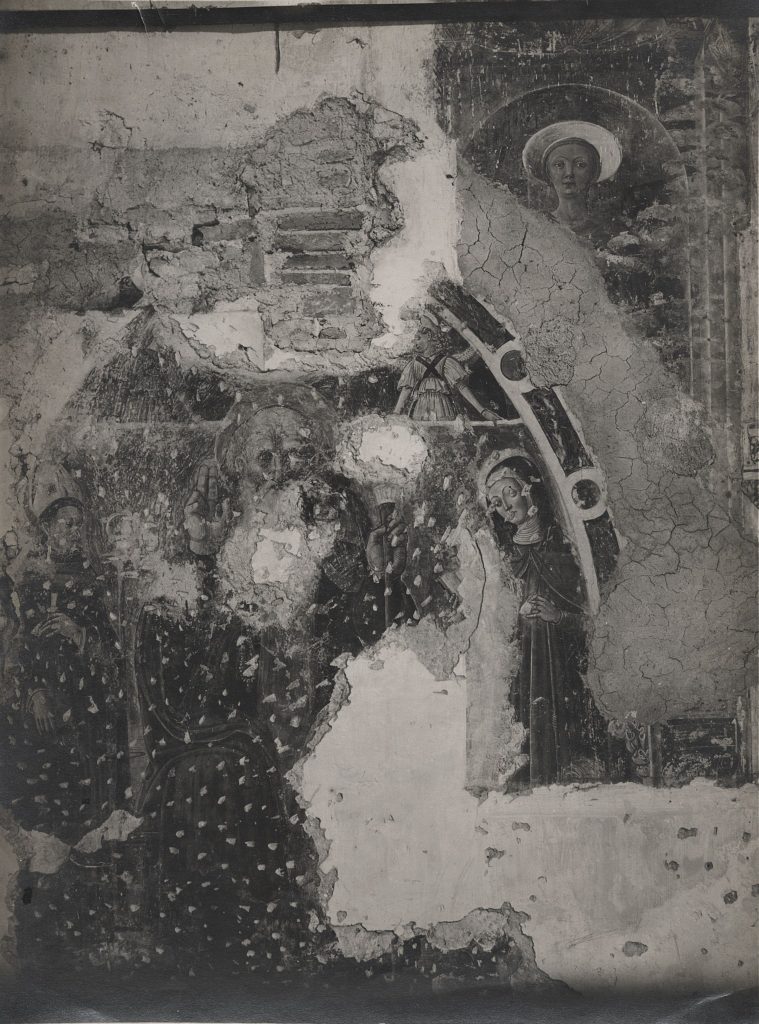
Dario di Giovanni, St. Gottardo between Saints Bonaventure and Chiara with St. Francis from a separate campaign. Fresco. Church of San Gottardo, Asolo. Photograph Fondazione Federico Zeri.
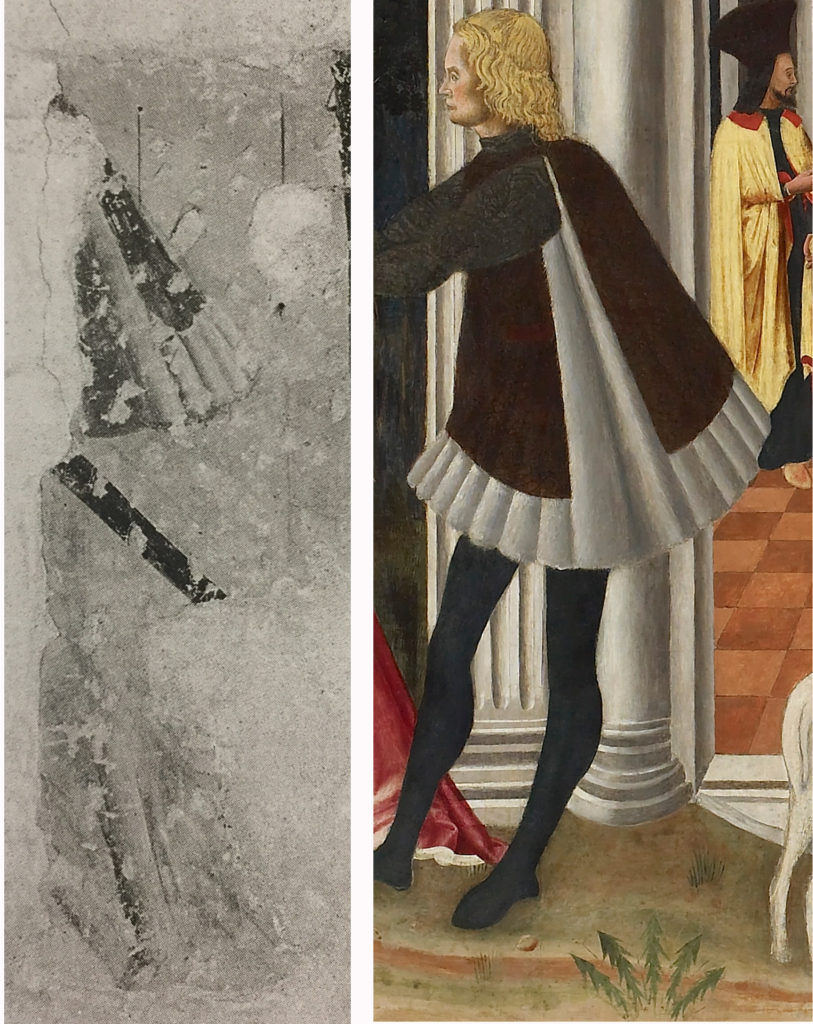
Left: Dario di Giovanni, fragment with a man’s fur-trimmed overcoat. Fresco. Chapel of St. Gotthardt, Church of San Gottardo, Asolo. Reproduced from Giorgio Fossaluzza, Gli affreschi nelle chiese della Marca Trevigiana dal Duecento al Quattrocento, Arte nelle Venezie 1.3 (Treviso, 2003), fig. 15.92. Right: Detail from the Abduction
That Dario’s repertory of facial types included ones retaining a sense of form inherited from the late medieval fresco tradition is reflected as well in a previously unrecognized collaboration with the Vivarini workshop that can be assigned to these years. The Polyptych with the Madonna and Child Enthroned with Saints in the Pinacoteca di Bari has been attributed to Bartolomeo or Antonio Vivarini alone or together.[85] The central panel of the Madonna and Child is indeed stylistically consistent with the work of Bartolomeo Vivarini, but the two extant side panels with Saints Benedict and Scholastica are by Dario, made clear through a comparison of the face of St. Benedict (fig. 17), forcefully defined by his long flat nose, with, on the one hand, the round fleshy face of Vivarini’s Madonna with lightly drawn features so influenced by the soft manner of his elder brother Antonio (see fig. 11), and, on the other, heads from the Walters Reception at Troy. This collaboration of independent masters opens the door to considering the possibilities of such relationships elsewhere, as in the Abduction series.
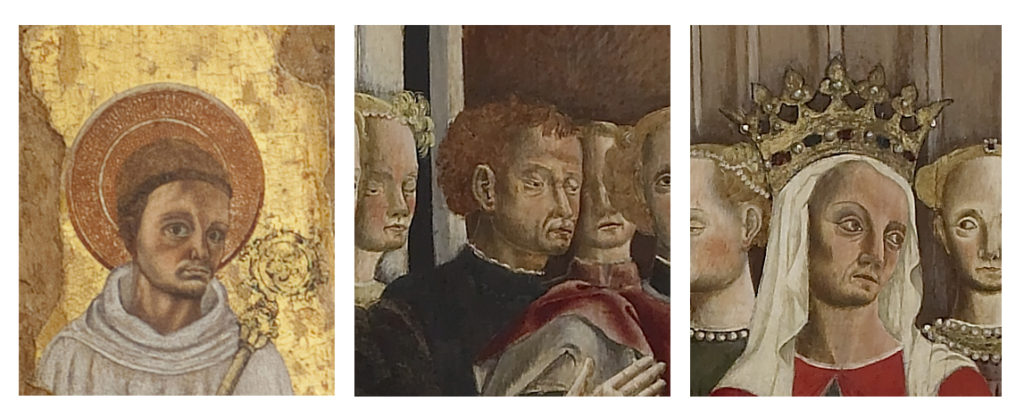
Left: Dario di Giovanni, St. Benedict, detail of Polyptych with the Madonna and Child Enthroned with Saints. Tempera and gold leaf on poplar, 49 1/4 × 10 3/8 in. (125 × 26.3 cm), Pinacoteca “Corrado Giaquinto,” Bari . Center and right: details from Dario di Giovanni and collaborators, The Reception of Helen at Troy.
The largest surviving project attributed to Dario prior to the Corner commission was carried out in Pordenone, the city of his birth, probably around 1466, as Dario was recorded as briefly back in Padua then and would have spent time in the Ovetari Chapel (completed in 1457), which experience appears to have informed his compositional solutions in Pordenone.[86] The frescoing of the chapel of the Popaite family dedicated to the life of St. Nicholas in the Cathedral of St. Mark (fig. 18) was a significant commission and in its pristine state must have been spectacular.[87] The Popaiti were raised to the nobility in 1447 by Archduke Albert of Austria, who held Pordenone as a Habsburg enclave. The male family member portrayed as the donor may be Antonio Popaite, podestà in 1466 and 1469.[88] The frescos were partially destroyed in the late sixteenth century.[89] While some of the faces (including that of the donor) are reconstructions, the compositions retain their original vigor. No documents concerning the decoration are known to survive. While the attribution to Dario by Coletti and then Furlan was not taken up in the following years, no alternative has been proposed, and he remains the only viable candidate. The approach that pervades the compositions of the extant scenes looks back both to less adventuresome segments of the Ovetari chapel by Ansuino da Forlì and Niccolo Pizzoli, as Furlan pointed out, and forward to the Walters series, as that astute observer was also aware.
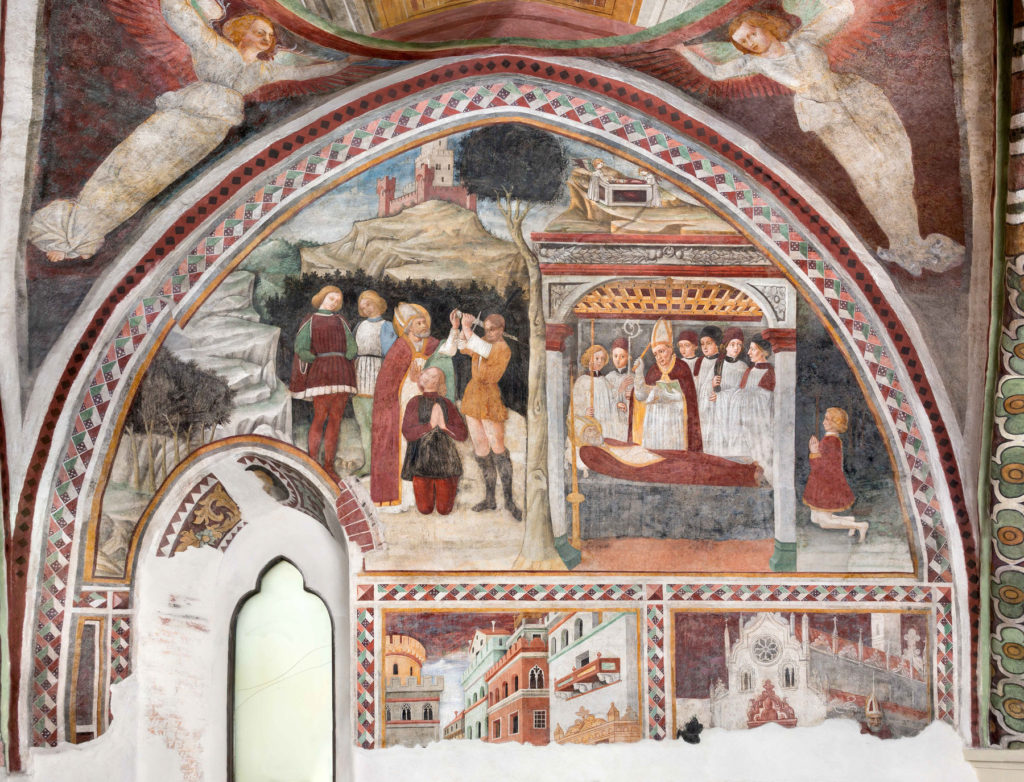
Dario di Giovanni, Episodes from the Life of Saint Nicholas (with the death of the saint) from a cycle on the Life of Saint Nicholas, ca. 1463–66. Fresco. Chapel of St. Nicholas, Cathedral of St. Mark, Pordenone.
From 1468 to early 1471, the timeframe within which Dario would have executed the paintings for the Corner, his base was again in Treviso until the completion of an altarpiece (lost) for a local noble family, the Betignoli.[90] That year he was in Conegliano, beginning a major commission for an altarpiece and the frescoing of a chapel there (now lost).[91] The last reference to him there as alive is from 1477, but the last known commission is from around 1474 for a signed fresco of the Madonna and Child for the facade of a house belonging to the Lusignan family, “del re di cipro” (of the king of Cyprus).[92] Thus Dario’s last known major commission was for the family for whom the portrait of Caterina—the point of departure for the Walters Abduction series—was painted.
The Abduction of Helen Series as an Istoria
In the later 1400s in Italy, the representation of an istoria, a story or narrative of exemplary nature, whether of historical events or from ancient mythology, was considered the greatest challenge for a painter.[93] The challenge came not only from the need to do justice to an uplifting or moral message but also from the necessity of depicting significant human actions in such a persuasive, varied, and pleasing way that the viewer fully engaged with the intended meaning. In the first pages of her fundamental work piecing together the nature of monumental narrative painting in fifteenth-century Venice, Patricia Fortini Brown underlined the importance of storytelling:
“Even when masquerading as entertainments—fables, romances, secular dramas, ‘naïve’ paintings—they function as mediating devices that help people to deal with the indeterminacies and insufficiencies of the real world. . . . Real events are untidy and incomplete in comparison to the stories we tell (or paint) about them. Narrative forms can make ambiguities tolerable, provide linkages and give structure to amorphous happenings. To confer coherence, wholeness, closure, and—perhaps most importantly—moral significance on the events that clutter our imperfect world, it is essential to narrate.”[94]
The Walters Abduction of Helen series exemplifies this characterization. Behind it, there are indeed untidy but important family stories to be rendered coherent. The family’s insistent claims on the Roman gens Cornelia and the virtues of Scipio Africanus underline a desire for coherence.[95] The choice of the abduction of Helen as the vehicle celebrating the marriage of Caterina fits into themes, based on historical and literary circumstances, that negotiate the dialogue between past and present that such storytelling does so well: the importance assigned to the Trojan War in Venice, to a woman’s irresistible beauty, and to associations between the island of Cythera, where Paris and Helen met, and Cyprus, where Caterina and Jacques would meet, both islands dedicated to Venus as goddess of love.[96]
The Trojan War (twelfth century BCE) was a popular subject for art in elite circles in Europe in the 1400s, particularly in tapestries and illuminated manuscripts.[97] Today it is a commonplace to think of Renaissance European culture in terms of a revival of Greco-Roman culture, but for the great courts of the period where most of the major commissions addressing secular history were generated, it can be argued that the perception of the historical (versus the cultural) continuum was not Greco-Roman but Trojan-Roman. In the 1400s, the history of Troy was fundamental to the sense of local and national history in many parts of Europe. While Roman culture owed its greatest debt to that of Greece, the ten-year Trojan War, in the persons of Trojan princes Aeneas, Antenor, and Francion fleeing their destroyed city in present-day Turkey, was understood to have been of extraordinary impact, precipitating the founding of Rome and of many of Europe’s other chief cities including Paris, London, and Venice.[98] By comparison with the giant explosion that physicists conclude initiated the evolution of our universe, this was the “big bang” of European history, and Paris first locking eyes with Helen was the initial spark.[99]
The fabrication of Venice’s foundation myths of Trojan origins as an aspect of identity—through Antenor, his followers (said to be the Heneti or Eneti [=Veneti], one of the tribes historically in the area) and descendants finding refuge first in Padua and then on the islands in the lagoon—was largely a work of the eleventh to thirteenth centuries. During that period, the city gradually extricated itself from the embrace of the Byzantine Empire (finalized by Venetian participation in the sack by European forces of Constantinople, its capital, in 1204) to become a major maritime force on the Adriatic.[100] Venice was the only city of significance in Italy that was not built up from a pre-existing Roman town; as it came to prominence, noble, older origins were sought elsewhere.[101] By the mid 1400s, while Trojan origins were beginning to be treated as myth by some, by others they continued to be treated as history.
The continuing appeal of the myth of Trojan origins is seen in the writings of two Venetian historians of the 1490s. In the opening pages of his celebratory On the Origins, Situation, and Government of the City of Venice (De origine situ et magistratibus urbis Venetae), composed around 1493, Marin Sanudo, the well-connected Venetian diarist and historian, references the city’s chroniclers and the authority of earlier historians.[102] While acknowledging the presence of Cisalpine Gauls in the region, he underlines the nobility of the Trojans who previously settled the area.[103] Later in the text, the author applied his sense of the adversities faced by the noble Trojans to the Corner family, comparing the burning of the family palace now known as Ca’ Corner della Ca’ Granda in 1532 to the burning of Troy.[104] Sanudo’s contemporary, the historian Bernardo Giustiniani (1408–1489), in his History of the Origins of the City of Venice (De origine urbis Venetiarum . . . , 1492), diplomatically proposed that both Gallic tribes and Trojans contributed to the region’s character and development.[105]
In the 1400s, “the abduction of Helen,” as an independent subject, was clearly deemed appropriate to celebrate a marriage; it is depicted on marriage-related items both in Venice and Florence.[106] The most striking representations are on Florentine cassoni or marriage chests, exemplified by Liberale da Verona’s Abduction of Helen, ca. 1470 (fig. 19) and that by Apollonio di Giovanni from about 1465 (fig. 20).[107] Cassoni were commissioned by the groom’s family and reflect prevailing societal (i.e., male) views on marriage and civic virtue: that a bride should be irresistibly beautiful, as was Helen. That a bride should also be so passionately desired, as was Helen, as to precipitate violence was perceived as a compliment.[108] In contrast, Flemish tapestries, the medium of public presentation with the greatest number of representations of the Trojan War in the 1400s, consistently privileged the high drama of the battlefield, as appropriate to their general propagandistic function.[109] The tapestries were generally executed in series, first for members of the French and English royal houses, proud of their Trojan heritage but also of a life in arms. Tapestries of individual episodes are recorded, but there appears to be no evidence that the abduction was popular for this format.[110]
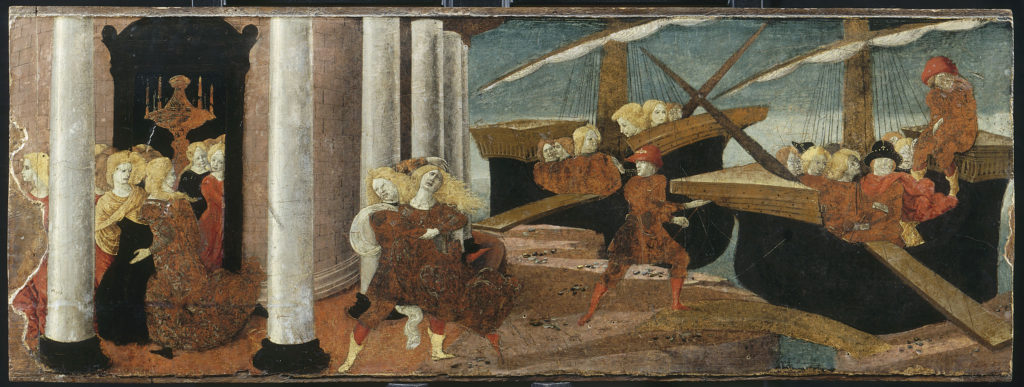
Liberale da Verona (ca. 1445–ca. 1526), The Abduction of Helen, ca. 1470. Oil on wood, 16 1/8 × 43 5/16 in. (41 × 110 cm). Musée du Petit Palais, Avignon. © RMN-Grand Palais / Art Resource, NY

Apollonio di Giovanni (ca. 1415 or 1417–1465), The Abduction of Helen, ca. 1465. Tempera on wood, 15 3/4 × 60 3/4 in. (40 × 153.6 cm). Private collection, formerly Metropolitan Museum of Art, New York. Photograph courtesy Sotheby’s
In the Renaissance, beauty—erotic beauty—was a woman’s primary claim to excellence, as it had been for the Greeks. Helen, the most beautiful of mortal women, epitomized this notion in antiquity. The first Renaissance treatise consisting of biographies of the “illustrious” or famous women of the past (De claribus illustribus) by the Italian humanist Giovanni Boccaccio (1313–1375) also praised Helen for the undoubted excellence of this natural gift. In the Greek myth of the Judgment of Paris (the “prequel” to the abduction), Minerva and Juno, otherwise intelligent and powerful goddesses, feel it necessary to contest the title of “the most beautiful” with Venus, goddess of erotic beauty.[111] Homer, the great wordsmith, had difficulty putting the effect of Helen’s beauty into words, but for many other subsequent (and lesser) authors—such as Guido delle Colonne, the main source for the Walters series—it was easier just to list her features.
Then there are appealing connections between the island Cythera, dedicated to Venus as her birthplace, where Paris and Helen first meet and their passion was ignited, and the island Cyprus, also dedicated to Venus as her birthplace, where Caterina Corner would join her husband. In some versions of events familiar to Renaissance scholars, Paris and Helen stop in Cyprus before reaching Troy.[112] Both Helen and Caterina are compared to the goddess: Helen was said to have been as beautiful as Venus, and the same was said of Caterina, who would be acclaimed in Cyprus as the “very goddess in beauty.”[113] In a transparent repurposing of the Judgment of Paris, the earliest biography of Caterina included a charming but nonsensical story to the effect that Venetian families had committed their daughters to a beauty contest, at which Caterina was selected as the most beautiful and therefore as the prospective queen whose portrait was to be sent to the young king.[114] Then there is the delicate poetic salute to Caterina Cornelia as a bride (written around 1468–1474) by the poet Bartolomeo Pagello in which Cytherea (Venus) brings jewels from Cyprus as tribute to Caterina as wife and queen.[115] These more idyllic qualities of Cythera as an island for lovers would come to mind in the separate chamber where one would be surrounded by Dario’s two-part Garden of Love ensemble (see figs. 3, 4), reflecting the tenderness and playfulness of the medieval courtly tradition of the delights of the enclosed pleasure garden, modulating the more overtly erotic urgency of the abduction.[116]
The Textual Sources
In addition to Homer, the abduction of Helen, queen of Sparta, by Paris, prince of Troy, was described with varying details and assumptions by tens of authors in antiquity and many others over the centuries prior to the 1460s.[117] Almost all authors shared the assumption that this abduction, however it came about, led to the ten-year war waged by Greeks against the Trojans to get Helen back and that resulted in the destruction of the great city of Troy and the dispersal of its peoples.[118]
In Italy in the 1400s the most respected version of the Trojan war as history—and the one exhibiting the most similarities to Dario’s paintings—was Guido delle Colonne’s History of the Destruction of Troy (Historia destructionis Troiae) of 1287, which was widely available through countless manuscript copies.[119] The author states that his account is based on two ancient texts describing events of the war, both by men who claimed to had been personally involved: Dares the Phrygian (Trojan) and Dictys of Crete (Greek). Homer’s Iliad was rejected out of hand as riddled with “falsehoods,” for describing the gods as fighting alongside humans and as having been written long after the events described.[120] In fact, Guido’s primary source for his purportedly historical account was a famous French romance by Benôit de Sainte-Maure, Le roman de Troie (written around 1160), which in turn was actually based on the (pseudo) historical texts said to be by Dictys (Greek original of the first century known from a Latin version of the fourth century CE) and Dares (again Greek original of first century known in a Latin version of the sixth century CE) with many fanciful details.[121] Guido’s Historia was generally perceived as a serious work of historical writing, although by the mid-1400s doubts were beginning to be raised.[122]
According to Guido’s account of the abduction of Helen (Books 6, 7), diplomatic efforts by Priam, king of Troy, to persuade the Greeks to return his sister Hesione, who had been abducted by the Greeks and treated as a concubine, had been unsuccessful. He told a council of princes that he wanted to try again and was ready to use force to at least achieve vengeance, but the fact of Greek military advantage caused many of the princes to counsel caution. Priam’s son Paris, however, called for action. He was certain that the gods wished him to defeat Greece and to “seize some very noble woman from the aristocracy of Greece and bring her captive to the Trojan kingdom” to be exchanged for Hesione. He declared to have received a “sure sign” from the gods themselves. In a dream, the god Mercury brought before Paris three goddesses—Venus, Minerva, and Juno—so that he might decide their quarrel as to which one was the most beautiful, a result of a “wonderful apple of precious material” inscribed “to the most beautiful” having been thrown among them. Mercury described what each goddess offered him to choose her: Juno (queen of the gods), that she would make him the greatest man in the world; Minerva (goddess of wisdom and war), that she would grant him all human knowledge; and Venus (goddess of love and sex), that she would let him “carry away from Greece a very noble woman, more beautiful than Venus herself.” He chose Venus, who confirmed her promise, upon which he awoke. So Paris asked Priam to send him “against Greece” to “bring back the woman with me, according to divine promises.”
Heedless of warnings of dire consequences, the ships struck out “in the name of the gods Jupiter and Venus.” Before reaching the Greek mainland, they came to the island of Cythera, under Greek control, and went ashore. On the island there was a wonderfully beautiful, rich, ancient temple dedicated to Venus, in whose honor a festival was underway. The Trojans, dressed in gorgeous attire, went to the temple and made offerings. Paris told those he encountered at the temple that he had come to find his father’s sister. His listeners were struck by his beauty and “regal pomp,” word of which reached Helen. Seized with fascination, she wanted to see him for herself. Her husband, Menelaus, was away. Declaring that she wished to fulfill some vows, she arranged to make the trip. “In royal attire and with her retainers,” she rode her horse to the shore and embarked for the short journey to Cythera, where she was received “with great honor” and went to the temple to fulfill her vows to Venus.
When Paris learned of Helen’s arrival, he went there as well. Animated by intense desire, he contemplated every aspect of her appearance beginning with her “thick golden hair, which shines with radiant splendor.” Their eyes met, and they revealed to each other through signs their mutual passion. Paris took his leave and returned to the ship, telling his men that it would be impossible to recover Hesione but that they could attack the temple and take away riches and many captives including the queen, Helen, who could be exchanged for the king’s sister. When night fell, the Trojans returned to the temple and attacked. They looted everything and took everyone captive. Paris captured Queen Helen “with his own hand.” She did not resist but was “animated by consent.” The tumult was such that the clamor reached the fortified castle “on a higher place above the temple,” the armed residents of which fell on the Trojans but were outnumbered. The Trojans set sail and arrived on the shores of the Trojan kingdom. Helen, among the captives, was “tormented with great anguish,” and Paris could hardly comfort her. Paris insisted that she had nothing to fear, that her rank would be respected and that as his wife she would enjoy great dignity. Priam sent her “royal garments” and, mounted on a handsome horse, she proceeded with the others to Troy, where they were met by Priam with a “retinue of many nobles” and other celebrants. He led her into his “lofty palace.” Paris and Helen were married the next day.
Guido’s text was sufficient for the basic narrative, while other sources may have provided details. Combining elements from a variety of literary sources to produce the cogent, innovative version reflected in the Walters paintings would have been the work of an advisor, a scholar who would have been familiar with the literary options or how to locate them. The best candidate is Paolo Marsi (1440–1484), a young but respected humanist hired by Marco Corner as his son Giorgio’s tutor.[123]
Representing the Story
Dario’s Abduction spalliere charm viewers now, as they must have done when painted, by engaging the imagination through a combination of an accessible narrative, clear staging, the glamor of magnificence, intriguing detail, and humor without sacrificing dignity. Lorenzo de’ Medici, one of the great patrons of art for the private palace, was insistent that, along with other factors, including the skill of the painter, the subject matter (le cose depinte) should please in itself (sè diletti).[124] Beyond drawing on Dario’s own past environment and projects in Padua, Pordenone, and elsewhere, the visual characteristics of the Walters series, along with the other paintings that were part of the same extended commission, suggest that he and his collaborators drew on qualities associated with the two major workshops then active in Venice: the panache of sumptuous textiles and luxurious foliage that had characterized the earlier altarpieces of Antonio Vivarini and Giovanni d’Alemagna for churches in Venice and Padua, and the perspectival staging of historical events and imaginative adaptation of Roman ornamentation characteristic of Jacopo Bellini and carried on by his sons.[125] Unfortunately, all the earlier fifteenth-century large-scale, complex history paintings commissioned from such luminaries as Pisanello, Gentile da Fabriano, Giovanni d’Alemagna, Antonio Vivarini, and then, more contemporaneously, Jacopo and Gentile Bellini to cover the walls of the great meeting chambers in the ducal palace or in the halls of various religious institutions that Dario may well have studied are now all lost, primarily through fire or damp.[126] Nevertheless, the influence of Jacopo Bellini (ca. 1400–ca. 1470) can still be gauged in some degree from his two famous existing notebooks (Musée du Louvre and British Museum), filled with compositional studies for istorie and now dated to the 1430s into the 1460s.[127] Two of the three Walters panels respond to features of Jacopo’s compositional formulas developed in the notebooks.
In working out a persuasive narrative, Dario employed architectural and sculptural references to evoke the distant past, even as Helen and the other young men and women are resplendent in their Renaissance fashions. While a student of Squarcione, Dario would have had access to a range of sources, including collections of Roman works of art (beginning with that of Squarcione himself), which in most cases can no longer be assessed. In addition, Dario appears to have had the opportunity to consult the Paduan scholar Giovanni Marcanova’s influential antiquarian manuscript Collection of Antiquities (Collectio antiquitatum, Biblioteca Estense Universitaria, Modena) completed in 1465 (known in multiple fifteenth-century copies).[128]
The paintings appear to have been conceived both as an integrated composition, of which the landscape components, set against the same banded sky (blue to nearly white above the horizon) flow successfully from one panel to another, and as discrete images with their own internal cohesion.[129] Within the integrated composition, the overall narrative or story line is staged almost as a procession, unfolding from left to right. By comparison, istorie for Florentine cassoni often involve a triumphal procession, most commonly either allegorical, as the Florentine Triumph of Venus (Walters Art Museum) from around 1500, or from ancient history. But when the istoria consists of a series of episodes over time—as does the Walters Abduction—the spatial disposition of the figures is normally varied, as in Apollonio di Giovanni’s Abduction of Helen (see fig. 19), engaging the eye in the kind of treasure hunt praised by that discerning viewer, Lorenzo de Medici.[130]
The underlying symmetry introduced to integrate the combined setting of the Abduction ensemble offers a beginning and conclusion, each defined by a sturdy architectural “bookend.” The procession sets off against a backdrop of the massive city walls of the city-state Sparta, moves through an open area of encounter and conflict identifiable as Cythera, and arrives in an architecturally defined interior space, the courtyard of the royal palace at Troy, where Helen kneeling before the king and queen of Troy brings the narrative as well as the action to a full stop. Depicting Sparta as the point of departure within the same composition as Troy is unusual, but it creates an easily grasped “journey” narrative. The brilliance of this solution is underlined by comparison with the ultimate distillation of the abduction in an anonymous German woodcut (fig. 21) from 1473 illustrating the life of Helen in the first printed edition of Giovanni Boccaccio’s Lives of Famous Women (De claribus mulieribus): Paris comforting Helen on a ship tucked between the walls of “Lacedaemon” (the kingdom of which Sparta was the capital) and Troy.
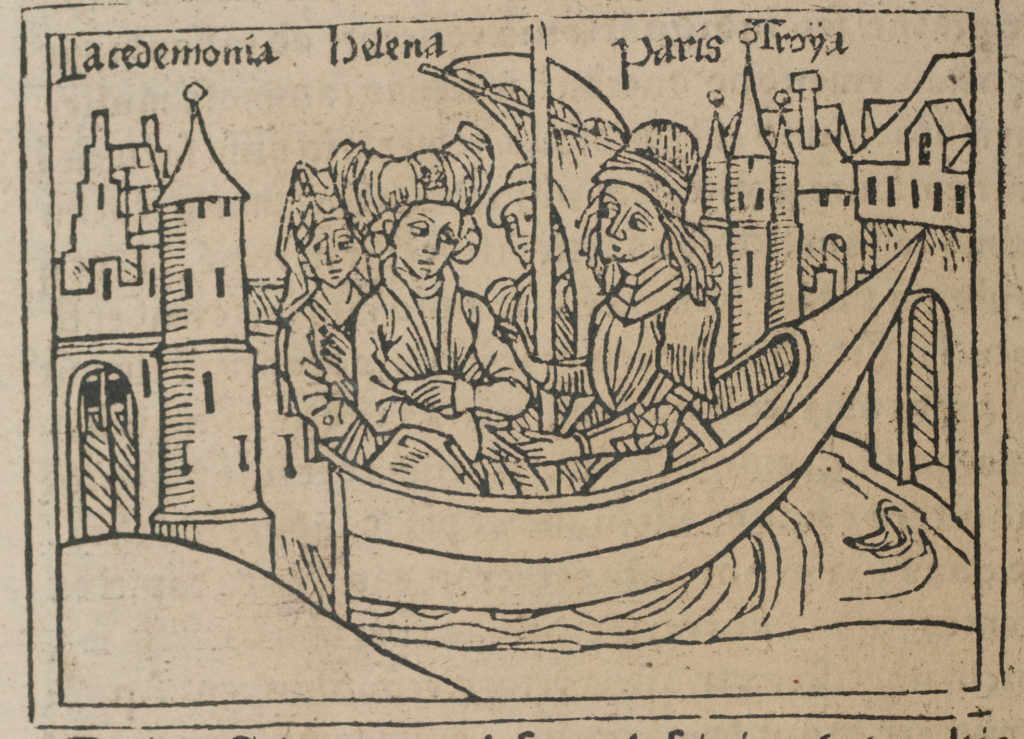
German, The Abduction of Helen, illustration to “Helen, Wife of King Menelaus” in Giovanni Boccaccio, De claribus mulieribus (Ulm, 1473). Woodcut. Walters Art Museum, Baltimore, bequest of Henry Walters, acc. no. 91.243
In the first panel, Queen Helen—identified by her ruby hair jewel and as the woman abducted in scene two—is surrounded by her entourage of young women, two girls, and three men bringing up the rear, before the gate and walls of Sparta (fig. 22). They stroll toward the ship that will take them to the island of Cythera, a protectorate of Sparta dedicated to Venus (and in real life a Venetian possession), to participate in celebrations honoring the goddess. The party is beckoned toward the ship by a grinning buffoon or jester in typical yellow costume and donkey’s ears who appears to be playing the part of guide, implying that mischief lies ahead.[131]
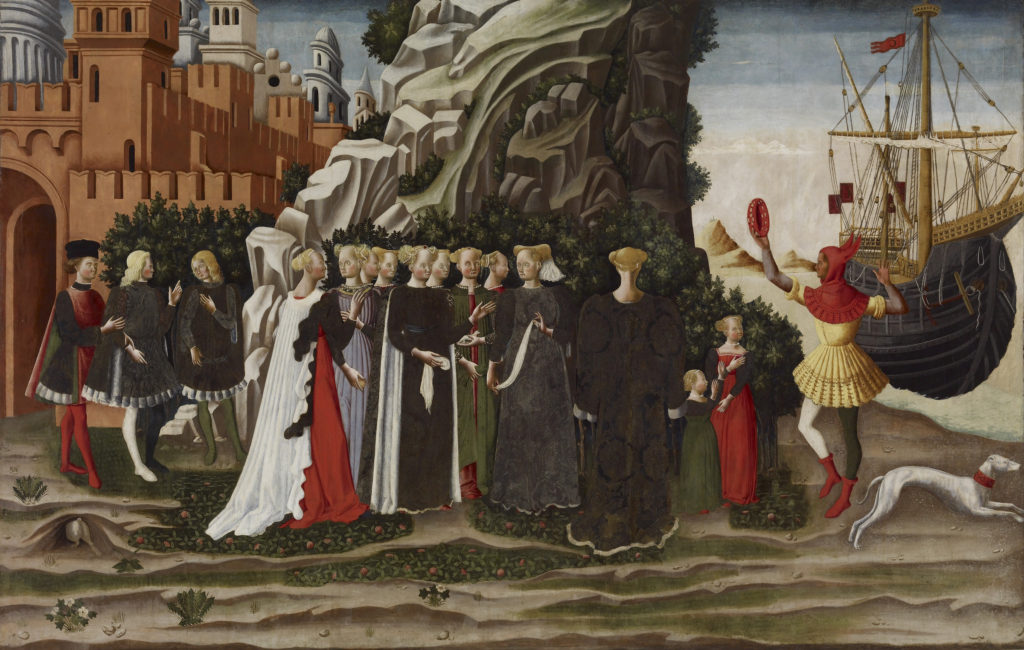
Dario di Giovanni and collaborators, The Departure of Queen Helen and Her Entourage for Cythera, ca. 1468–69. Tempera and Pressbrokat on spruce, 60 × 94 3/16 in. (152.4 × 239.2 cm). The Walters Art Museum, Baltimore, bequest of Henry Walters, acc. no. 37.1178
The figures are all dressed in expensive fashions of contemporary Venice while the more rigorous, approach to antiquity–ancient figures in ancient dress–would be the preference of Giovanni Bellini in his Continence of Scipio Africanus, ca. 1507 (see fig. 5), commissioned by the Corner family in honor of their Roman forebear. However, the Corners’ Abduction series was surely intended to negotiate the borders between history and present experience–and for Venetians, the experiencing of great events involved great clothes.[132] Marin Sanudo’s comments on the great civic rituals of Venice that constituted the nobility’s expression of communal magnificence often included the clothes that made them memorable: “it was a beautiful thing to see so many garments of silk, velvet, damask, and satins, and scarlets.[133]
The presentation of these young men and women is strikingly sumptuous. The women are fashionably but decorously dressed, wearing dresses with long trains (known generally as a gamurra, but called zupa, zipa, or socha in the north of Italy) and fur-lined or trimmed cloak with hanging sleeves (pelanda in Venice).[134] The effect is dependent less on the women’s jewels, which are rather restrained, consisting of ropes of pearls, a jeweled collar, or perhaps a single but large ruby hair jewel, as that worn by Helen, than on the the simulated brocades, shimmering with the effect of gold and silver threads, which in their original condition would have been astonishing in their visual effect.[135] The delight in display and the focus on the luxurious, tactile effect of the brocade is distilled in the elegant and alluring figure of the young woman depicted from the rear, drawing the viewer’s eye to the brocade for its own sake.[136] The men wear fur-(ermine) lined and/or fur-trimmed open-sided tunics (giornea) or overcoats with hanging sleeves (gonnella or cioppa) over their doublets (known by different terms such as giubetto, zuparello, or farsetto) into which they laced colorful hose (calze).[137] They must be under twenty-five, because it was at that age that they gave up colorful clothing for the sober black that signified their participation on the Great Council.[138] Venice was known for its sumptuary laws, which were intended to curb such display, especially of women’s clothing and jewels.[139] However, regulations were reduced or suspended in so many situations, such as weddings or any public event intended to impress foreign dignitaries, leaving scholars to conclude that they were not particularly efficacious.
The painting also reveals contemporary preoccupations with hair. Beauty, certainly irresistible beauty, required golden blond hair: all the women depicted in the panels have some variation of it.[140] Helen, as described by Guido delle Colonne (and virtually all authors) was endowed with golden hair; the beautiful St. Catherine of Alexandria, Caterina’s name saint, as well as the Virgin, and female saints in general were depicted as blonds at this period; it was the default attribute of female virtue as well as erotic intrigue. The formative, contemporary model for the latter was found in the writings of the influential early Renaissance humanist Francesco Petrarch (1304–1374), who had lived for some years in Venice. His sonnets in celebration of his beloved muse, Laura, and the enticing tendrils of her golden hair were engrained in the mind.[141] Not all blondes were naturally so—the effort entailed in meeting this cultural expectation is revealed in Janet Stephens’ note on a Venetian book of beauty tips from the period. The varied hairstyles of the women in Helen’s party all involve a high forehead with the hair secured atop the head with a little harness of pearls (frenello). While the assumption has been that such styles (versus freely hanging hair) indicate the married state, the older of the two girls in the painting is similarly coiffed. In the absence of a Venetian source from the 1400s, I hesitate to ascribe a marital indicator to these careful managed hair styles beyond the modesty thought appropriate for all adult women out in public.[142] However, the large ruby head brooch worn by Helen (and a smaller one worn by a second woman) may serve as such an indicator; rubies were frequent gifts to brides, intended to promote health and moderate lust.[143]
Other details in the painting—a yellow ball, handkerchiefs, little girls, animals, and flowers—enliven the scene and add their own nuances. The yellow or golden ball that the lady with the dagged white cape has in her hand, ready to be offered to Helen, could be a reference to the kind of courtly ball game played by ladies and gentlemen that figures in domestic palace decoration from the Venetian terrafirma.[144] It could also be a clever reminder (under the veil of a leisure pastime) of the Judgment of Paris, with which the story of the abduction began, and the golden apple or ball (often the latter in Italy) engraved “to the fairest” that was Venus’s prize (see Stephens, “Becoming a Blond,” fig. 4).[145]
Two of the young women play with their handkerchiefs, a ubiquitous possession. A young woman uses hers to blindfold a young man in the Melbourne Garden of Love (see fig. 3). Cupid himself may be shown blindfolded and bound by a personification of Chastity or even Venus herself, suggesting, among other possibilities, that once bound in marriage, one should cease looking.[146]
Also shared with the Garden of Love is the motif of a young woman cradling a small white dog.[147] A lapdog that is a much-caressed playfellow is a more likely reading in both paintings than a white ermine as a symbol of chastity, the identification proposed by Edward King.[148] The lithe Italian white whippet or greyhound is stretched out at full speed, the characteristic pose favored for the many representations of the species. Greyhounds were commonly owned as hunting dogs, and here the hound is on the scent of “game,” possibly a humorous reference to Paris and Helen about to converge on Cythera. The rabbit diving into its hole in the lower left may be simply fleeing the greyhound, but, through its fabled fecundity, it is closely associated with Venus.[149] On the other hand, the carpet-like patches of red clover, along with oxalis and dandelions (just the leaves), may simply be delights for the eye.[150]
Two girls, dressed and coiffed similarly to the young women, provide a rapt audience for the tambourine-shaking buffoon/jester. Painters usually chose boys as curious onlookers at processional or parade-like events.[151] This rare instance of girls as onlookers may allude to Caterina’s younger sisters.
The setting consists of three elements that each support the narrative: the walls of Sparta, a massive outcropping of rock, and the waiting ship. The walled city is identifiable as Sparta only by being the departure point for Helen and her party. There are no rooflines of known monuments visible over the ramparts (as there would be of an image of Rome in Florentine painting), though there is a Venetian chimney.[152] For all the reverence humanists offered up to Aristotle and Plato, there was little interest in the representation of their homeland per se.[153] The aim here was not accuracy but a dignified staging point for the istoria. The ahistorical addition of balls for architectural embellishment, also found in the other scenes, was most likely adapted from the fanciful renderings of Roman architecture in the pages of Marcanova’s Collectio, for example, An Equestrian Statue (Marcus Aurelius) in a Fictive Roman Setting (fig. 23).[154]
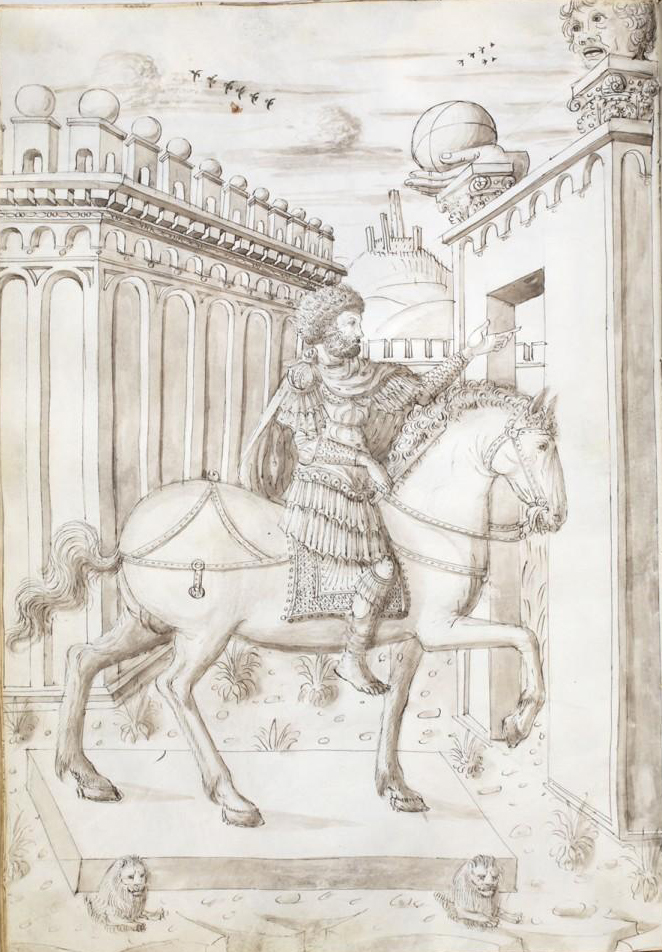
Paduan, An Equestrian Statue (Marcus Aurelius) in a Fictive Roman Setting. Pen and ink on vellum, 13 3/8 × 9 7/16 in. (34 × 24 cm). From Giovanni Marcanova’s Collectio Antiquitatum, before 1465. Biblioteca Estense Universitaria, Modena, Lat. 992, fol. 29v
From the city gate, Helen and her party cross before a fantastically peaked outcropping of rock fronted by figures on a rigid plane, as developed by Jacopo Bellini through studies in his notebooks, exemplified by his Martyrdom of St. Christopher (British Museum) or his Adoration of the Magi (Musée du Louvre). Untamed nature is softened by a row of shrubbery that sets off the rich textures and colors of the fabulous clothing on display before it. [155]
Helen’s waiting ship represents a type of Venetian three-masted merchantman commonly to be found in the harbor, as one being repaired in a detail from Breydenbach’s well-known panorama of Venice from Peregrinatio in terram sanctam (fig. 24).[156] It has a rounded hull that was excellent for transporting goods (or men) and had no counterpart in antiquity. The vessel is drawn in reasonably good perspective but exhibits odd characteristics that reveal Dario’s inexperience with depicting ships: for example, it rides surprisingly high in the water, and there is no crew. The pennant flies from the rigging rather than where it would be expected, the top of the mast, but the mast is cut off by the upper edge of the panel.[157] While the panel gives evidence of having been cut down along the top, it is unlikely that it originally extended sufficiently to allow for a proper crow’s nest. Since the pennant is important, its placement suggests a “fix” for a miscalculation. As demonstrated by an x-radiograph image of the right half of the painting (fig. 25), previously only the ship’s bow and forecastle were represented, pushing invasively in toward the shore.[158] A similarly aggressive use of a ship’s forecastle is featured in an Abduction of Helen (before 1476) attributed to Giovanni di Ser Giovanni, known as lo Scheggia (fig. 26), but the similarity is coincidental, reflecting the ease of depicting a ship in profile versus in perspective. Moving the ship back permitted a more complete portrayal that did not upstage the narrative or sever its flow.
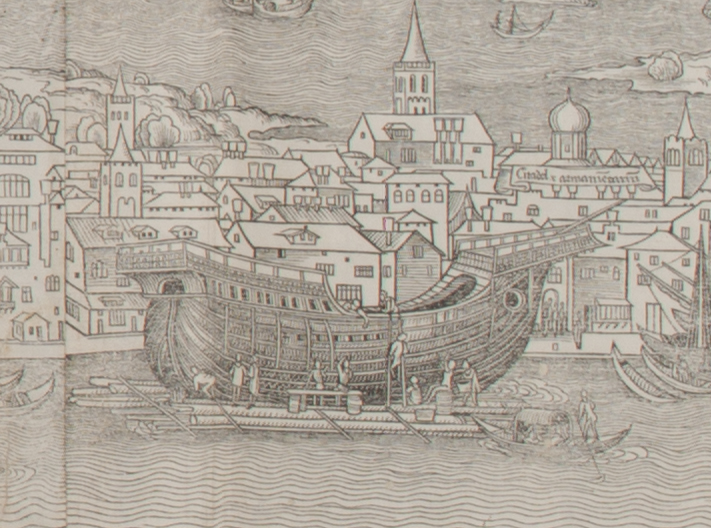
Erhard Reuwich (ca. 1455–ca. 1490), Panorama of Venice (detail). From Bernhard van Breydenbach, Peregrinatio in terram sanctam (Mainz, 1486). Woodcut. The Walters Art Museum, Baltimore, bequest of Henry Walters, 1931, acc. no. 91.283
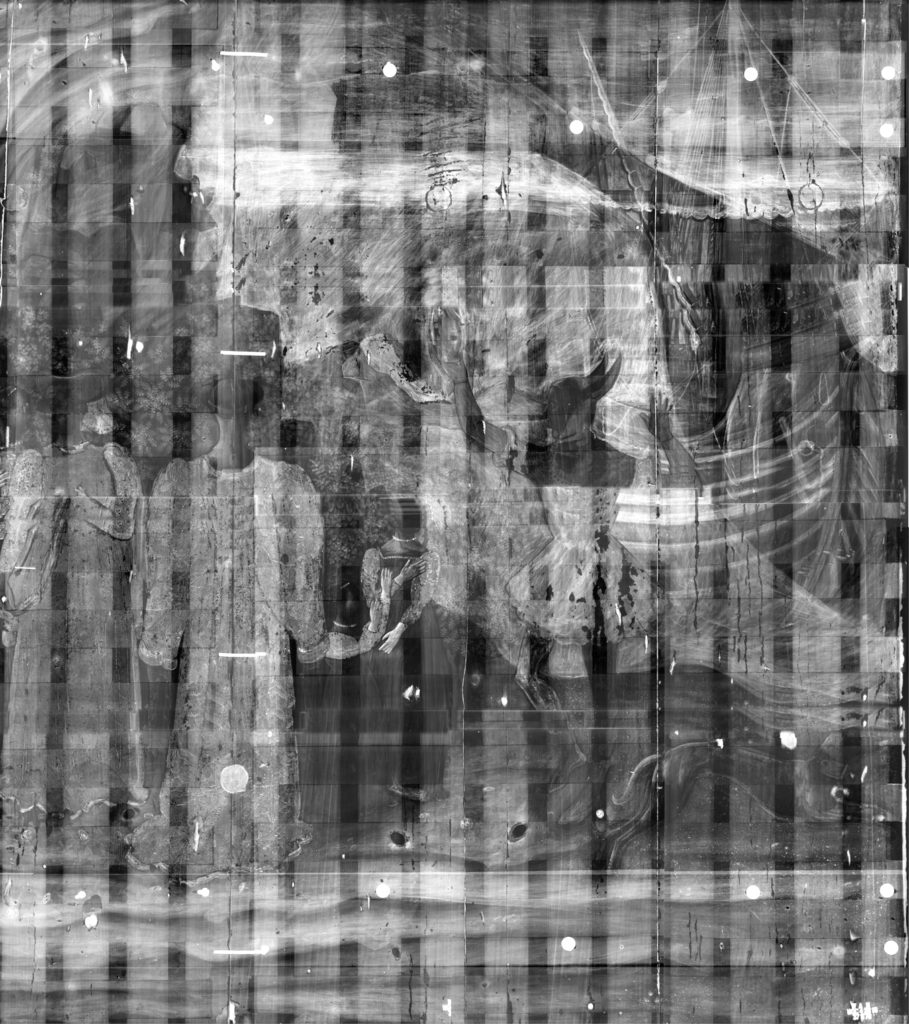
X-radiograph of the right side of Dario di Giovanni, The Departure (fig. 6), showing the initial placement of the ship
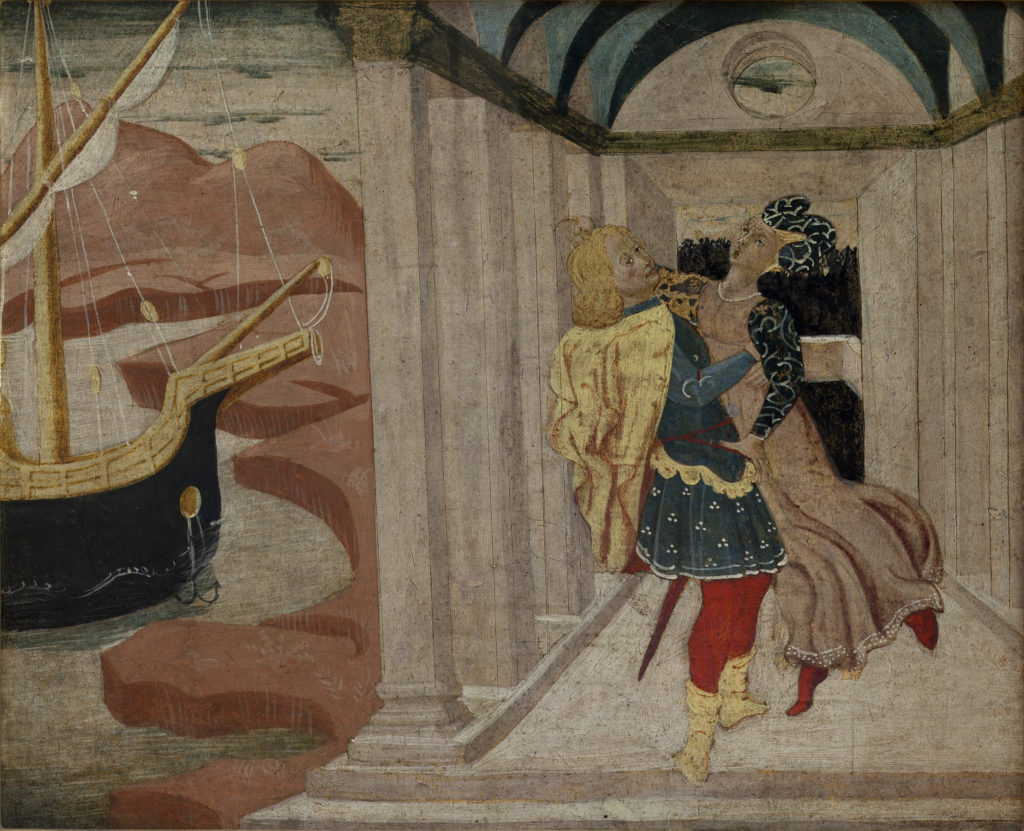
Giovanni di Ser Giovanni, known as lo Scheggia (1406–1486), The Abduction of Helen, 1460s. Tempera on wood, 15.7 × 18.8 in. (40 × 48 cm). Narodni Galerie, Prague. Photograph © 2019, National Gallery, Prague
The ship flies a pennant bearing a large “C” (fig. 27). In 1939, Edward King proposed that it might signal “Cythera,” a reasonable identification given how little was then known about the paintings.[159] As the pennant normally signaled the individual in charge, in the story that would be Queen Helen, but here she is the avatar of Queen Caterina. The single initial is usually that of a sovereign who can legitimately use just the first name, as “H” for Henry VIII, king of England or “A” for Anne, duchess regnant of Brittany, a contemporary. I propose that “C” is for Caterina.[160]
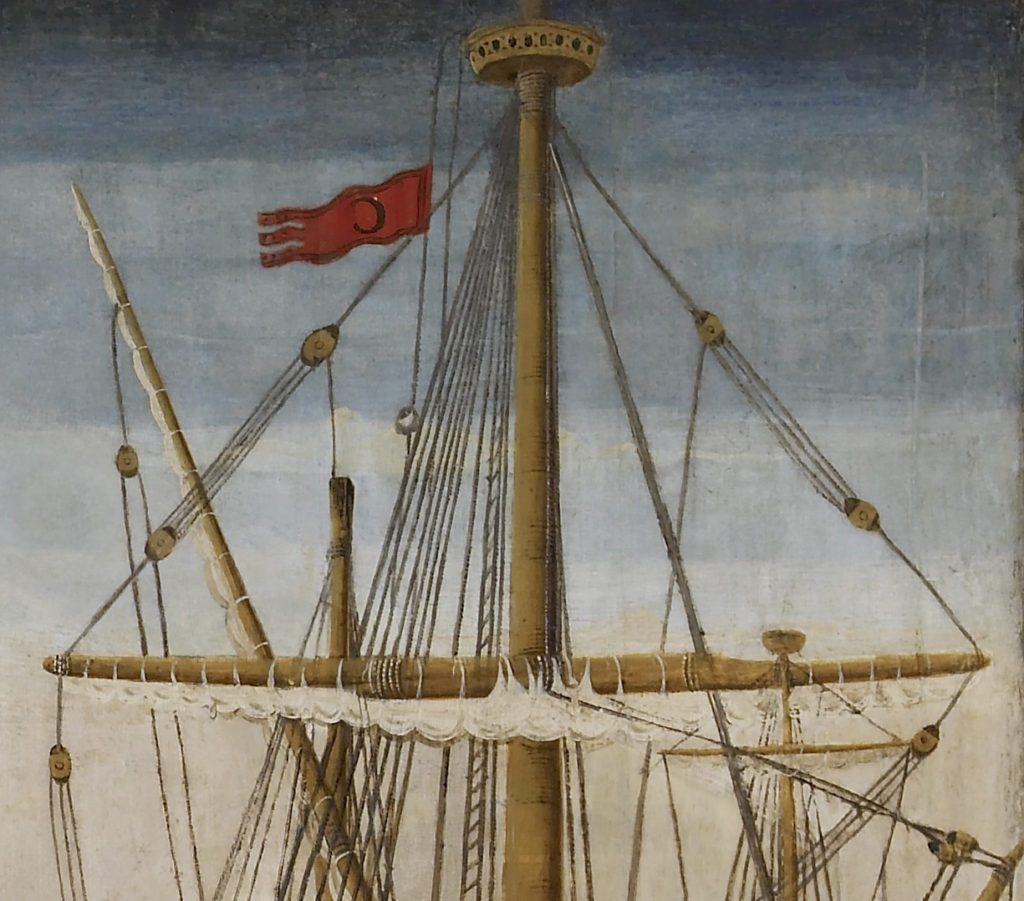
Dario di Giovanni and collaborators. The Departure: detail of pennant
The prominence of the merchantman may also allude to the importance of maritime trade for Venice (including members of the Corner family engaged in the sugar trade), much as would the veritable catalog of Venetian shipping found decades later in the background of Vittore Carpaccio’s imposing series The Legend of St. Ursula for the Scuola of St. Ursula (Gallerie dell’ Academia, Venice). This is an ancient type of vessel that continued to be used in the later 1400s for military and commercial purposes.[161] It also invites a contrast with Paris’s low-slung oared galley in the scene of abduction.
Tumult stretches across the second panel, the scene of the actual abduction (fig. 28), its mood of stress and confusion contrasting with the lightheartedness of the departure. The erotically charged moment of Paris and Helen locking eyes in the temple of Venus during the celebrations honoring the goddess is in the past, but Paris’s action in taking Helen by the wrist (not her hand) is a discreet but clear gesture with a history going back to the depiction of abduction scenes on Greek vase painting to convey the notion of a woman under the control of another, sometimes against her will.[162] In a not so dissimilar situation, many representations in Florentine painting of a woman being taken by the wrist are of a woman being given in marriage, in which instance control is passed from one man to another. Most versions of the abduction story make it clear that Helen was willing. As Dario has depicted her with downturned face, he may be drawing on a description of Helen in the mid-1300s Italian version of the story, The Trojan (Il Troiano) in which this body language is described as reflecting Helen’s embarrassment at feeling caught between her desires and her sense of duty.[163] As the paintings celebrate the wedding of a young girl who is surely thrilled at the romantic notion of being swept away to join the king, her husband, addressing the abduction with discretion that emphasizes more the attractions of the young woman than the act of being carried off seems appropriate. This restraint is at odds with the violence in Liberale da Verona’s Abduction of Helen, ca. 1470, for a cassone (see fig. 19), that by Lo Scheggia (see fig. 26), or the birth tray by Zanobi Strozzi in which Paris literally carries Helen off with no concern for her dignity. Of course, as discussed above, even this interpretation was considered a compliment to the bride’s essential attractions.

Dario di Giovanni and collaborators, The Abduction of Helen from Cythera, ca. 1468. Tempera on spruce, 60 3/8 × 116 1/4 in (153.3 × 295.2 cm). The Walters Art Museum, Baltimore, bequest of Henry Walters, 1931, acc. no. 37.1179
The narrative focus is on Helen’s stressed but calm exit to the right, toward the Trojan galley, but this is balanced visually by the shock and confusion spreading among Helen’s ladies, the signature exchange being that of the young woman near the center wrenching herself away from her pursuer. Everyone is still dressed splendidly, as they were for the temple celebrations, in contrast to versions of the narrative in which the Trojans come back at night fully armed for a fight. In addition, keeping to the underlying decorum of a wedding, the Trojans are not shown looting the temple.[164]
The setting for this tumult is a foreground clearing defined at the rear by a plane of lush, dense foliage of what may be meant for myrtle (plentiful on Cythera and sacred to Venus) punctuated by the Temple of Venus, a single tree, and a glimpse of the stern of a Trojan galley. Beyond the temple, a rising hill is topped by fortifications. The use of this backdrop of dense foliage is distinctive and nearly identical, including the single tree, to how this same device is employed in the Pordenone frescos (see fig. 18). Like the planar screen of dense foliage that defines the rear in the Garden of Love and the companion Garden with Rose Trellis, these employments may grow out of Dario’s familiarity with Antonio Vivarini’s effective use of a screen of foliage behind Christ Nailed to the Cross in his early Polyptych of the Passion, ca. 1430–1440 (Galleria Franchetti alla Ca’ d’Oro, Venice) or at the rear of the saints in the Santa Sabina Altarpiece, 1443, with Giovanni d’Alemagna (see fig. 11). The fortified place at the peak of the hill may evoke a passage in Guido’s account, in which, hearing the shouting, Cytheran soldiers came dashing down from a fortified place “above” the temple and attacked the Trojans, who fended them off and escaped.
An ancient temple of Venus, goddess of love, to whom the island was dedicated, was said by Guido to have been the site of the abduction. In the painting, this temple is physically insubstantial but densely interpreted, seemingly adapted from a combination of sources. The entrance, to which the temple has been abbreviated, is defined not by a triangular pediment but by the vocabulary of the Roman triumphal arch with gilded Corinthian capitals, adapted for Christian art and architecture by, among others, Leon Battista Alberti.[165] The interior as well has nothing to do with Greco-Roman temples but with more accessible “ancient” examples. While it is possible that Donatello’s predeliction for the barrel vault opened Dario’s eyes (see fig. 14), a stronger Paduan comparison that would have been equally well known to Dario is the interior of the Oratorio de San Giorgio (1376) in Padua (fig. 29), featuring a barrel vault combined with a flat end-wall defined by an oculus above two tall narrow windows, a configuration characteristic of churches built in the region for the new mendicant orders in the thirteenth and fourteenth centuries.[166]The vault itself is again a traditional late medieval star-studded blue “sky,” but in the temple it is defined by a Renaissance coffer-like grid. One example, accessible to Dario, of that combination is on the arch Mantegna designed for his Assumption of the Virgin (ca. 1455) fresco in the Ovetari Chapel (Padua). Finally, the tiled floor is laid out in a roughly accurate Albertian perspective system that is virtually identical to one in the Pordenone frescoes (fig. 30).

Dario di Giovanni, Episodes from the Life of St. Nicholas (with the birth of the saint), fresco, Chapel of Saint Nicholas, Cathedral of St. Mark, Pordenone
The imposing gilded (bronze) cult figure of the nude Venus, gracefully balancing on a semi-spherical base atop a sculpted pedestal, dominates the interior. Two priests, one identifiable by his “Eastern” (Greek Orthodox) headdress, are in attendance below.[167] Although the surface of the statue is abraded, the form is legible, especially if aided by an infrared image (fig. 31). Venus stands with her legs pressed modestly together and with her left hand raises a gold covered cup of a type commonly depicted in representations of contemporary feasts and in later representations of the goddess Fortuna balancing on a sphere.[168]
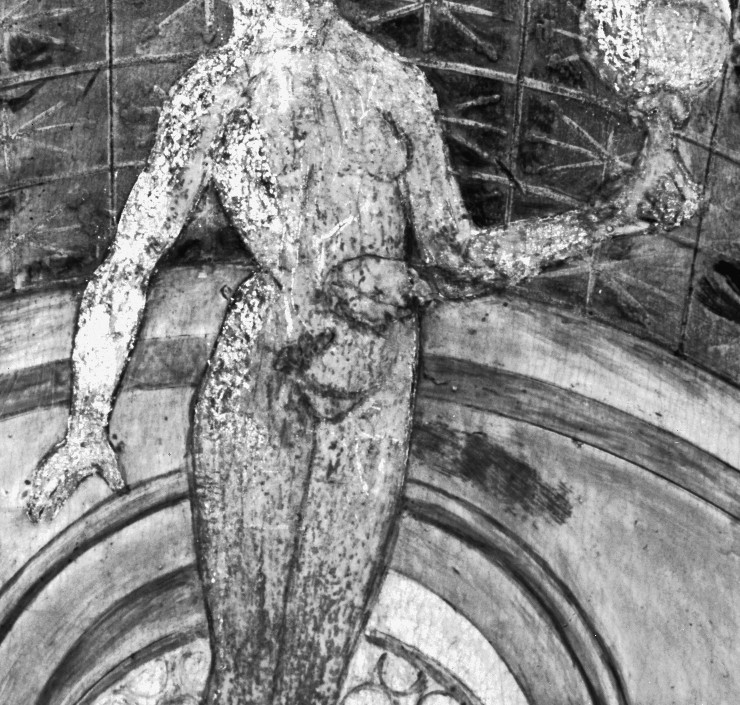
Infrared of the statue of Venus from The Abduction
There appear to be no earlier or contemporaneous extant figures of Venus or other classicizing female nudes in Venetian painting with which to compare this elegant figure. The emphatic grace of her contours emphasizing the long descending curve of her hip separates her definitively from the frank awkwardness of the late medieval nude in Venice, represented by Filippo Calendario’s marble Adam and Eve from ca. 1350 on the façade of San Marco or Altichiero’s intentionally awkward St. Lucy, stripped naked for torture (1378) in the Oratorio di San Giorgio. While Jacopo Bellini’s notebooks of the preceding decades, to which Dario appears to have had access, contain drawings of unclothed women, those larger than a centimeter lack the slender grace of Dario’s Venus.[169] In fact, in the defining lines of her legs, she resembles Dario’s allegorical, winged figure of Fortuna/Victory (?) poised atop a globe in The Garden of Love (see fig. 3), holding up a wreath and based on the same model as the pagan statue in The Blinding of St. Apollonia, 1440–1445 (Museo Carrara , Bergamo), attributed to Giovanni d’Alemagna.[170] I propose that the ultimate model for all three was a Roman bronze statuette, probably in a Paduan collection, quite similar to the Statuette of Flying Victory, poised on a globe with her legs outlined through the fabric of her gown and initially holding up a wreath (1st century BCE to 1st century CE), in the Museum of Fine Arts, Boston (fig. 32).[171]
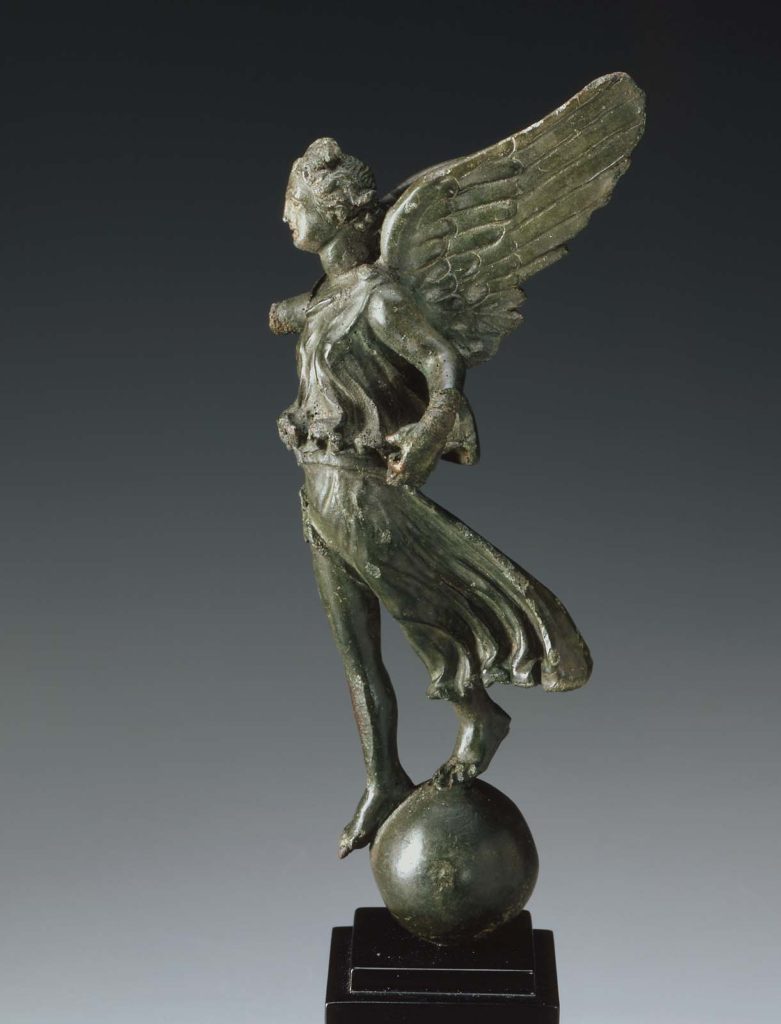
Roman, Statuette of Flying Victory, 1st century BCE–1st century CE. Bronze, height 6 15/16 in. (16 cm). Museum of Fine Arts, Boston, Harriet Otis Cruft Fund, acc. no. 62.971 Photograph © Museum of Fine Arts, Boston
The pedestal is a concoction of generic Roman detailing, the ahistorical ball motif used also in the other scenes, and a middle section that in its proportions combined with the garlands reflects a type of Roman funerary altar characteristic of the region around Padua of which various examples, as one now in the Museo Civico, Padua (fig. 33), were to be seen in Dario’s time and were previously adapted by Giovanni d’Alemagna and Jacopo Bellini.[172]
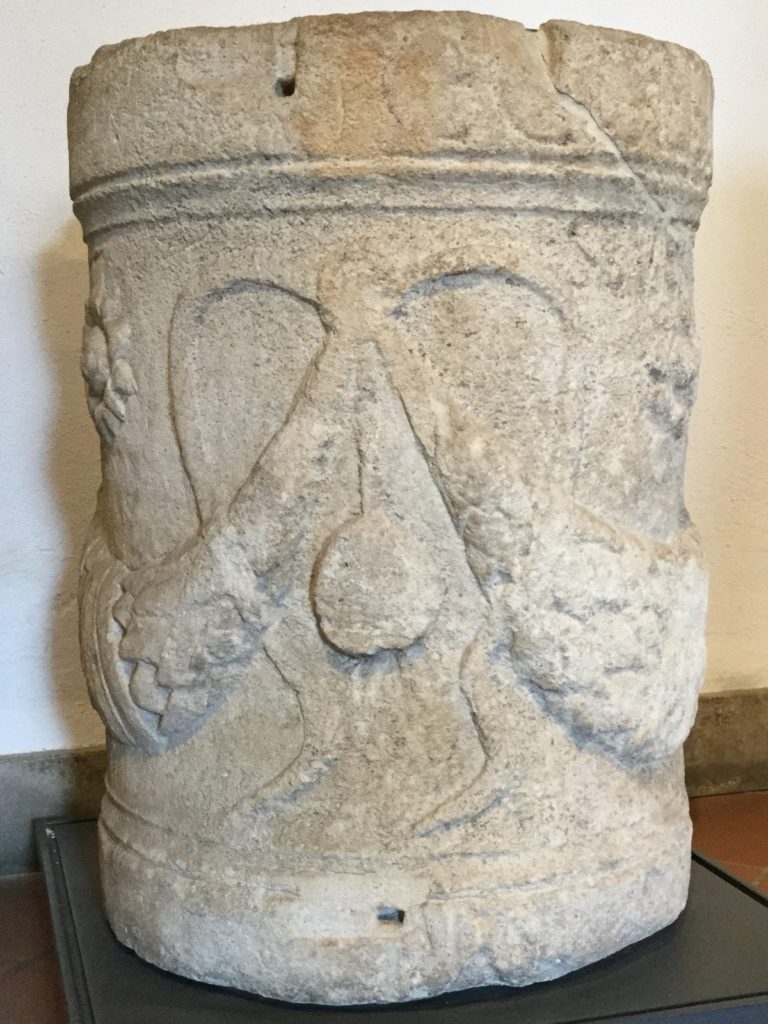
Roman (Veneto), Funerary Altar of Caius Coelius Severus, early 1st century CE. Marble. Found near Bassano del Grappa. Museo Civico, Padua, inv. 238. Author’s photograph
Finally, the hunting dogs add an amusing counterfoil to the main action. The red one in the foreground is a setter “pointing” (toward Helen?), indicating that he has found the “game.” The white mastiff or sheepdog (?) looking idly into the temple, ignoring the turmoil, is hardly needed to attract our gaze to the statue of Venus, but it is effective in introducing the kind of light humor that gives pleasure to the viewer.[173] It was painted out at an undetermined later date, perhaps due to a concern for decorum.
The story concludes in the third panel in a courtyard of the royal palace at Troy with Helen, “royally” attired (by Priam’s order), kneeling before the king, who receives her graciously, reaching out to raise her (fig. 34). The calm and “grounded” quality of the figures after the havoc of the abduction is enhanced by the use of shadow (absent from the previous scenes), embracing architecture, and by the protective presence of Jupiter, in the form of his majestic eagle alighting on a rooftop to the rear.[174] Priam had built an altar to Jupiter in Troy, and it was under the god’s aegis, and that of Venus, that Paris had sailed to Sparta. The king and queen are surrounded by members of their court, and Paris stands by Helen’s side.
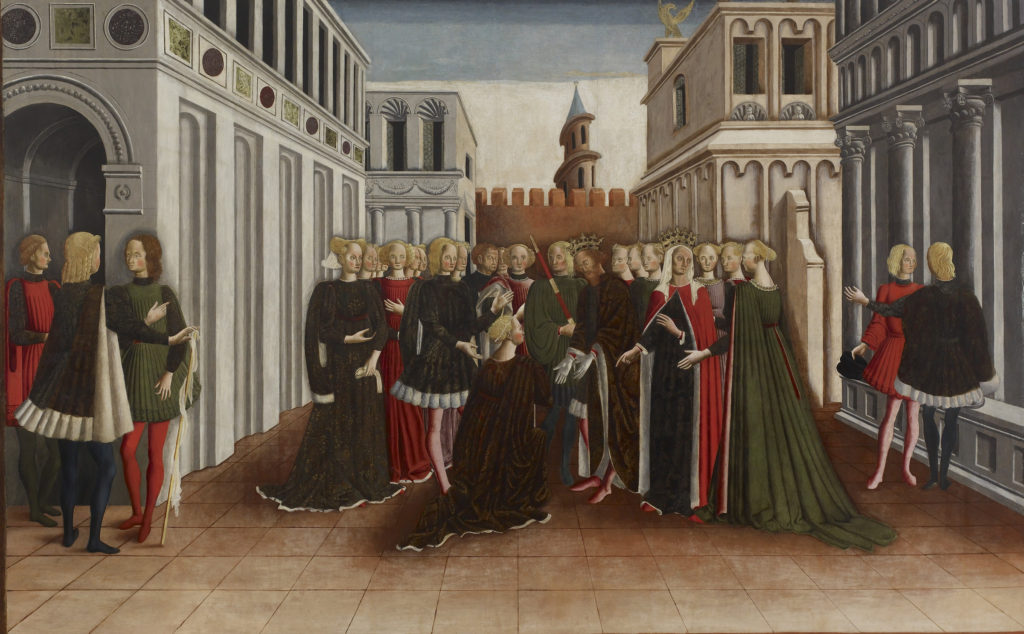
Dario di Giovanni and collaborators, The Reception of Helen at Troy, ca. 1468. Tempera and Pressbrokat on spruce, 60 1/16 × 96 1/8 in. (152.6 × 244.2 cm). The Walters Art Museum, Baltimore, bequest of Henry Walters, acc. no. 37.1180
The overall composition is laid out around a linear perspective construction with a central vanishing point between the eyes of a young man standing between Paris and Priam and lateral distance points defining the graduated recession of the floor tiles that effectively organizes and integrates the space, lending a measurable depth and sense of “place” to the scene. Students of the development of linear perspective in Florence as a method for creating a relatable space for the viewer to mentally “enter,” as articulated by Leon Battista Alberti in De pittura (1435), will not be surprised to see it here. Nevertheless, it is rare in extant earlier Venetian painting, given the massive losses to mid-century public istorie, as noted above, but Jacopo Bellini’s drawings of structured urban spaces, such as Urban Square before a Church offer evidence of the kind of model for structuring narrative spaces then available in Venice.[175]
Within this organizational layout, Dario marshalled adaptations from various architectural sources within a late medieval matrix. The receding blind arcade at the left effectively anchors the spatial recession and the narrative setting in a way that echoes the similar role of the arcade in Mantegna’s St. James Baptizing Hermogenes (destroyed) in the Ovetari Chapel (fig. 35), which Dario would surely have visited in 1466 when back in Padua. Dario and his advisor must also have thought through the use of individual decorative detailing.The two rows of attached columns are topped by capitals of different orders, both earlier than the Corinthian used for the temple. The capitals to the rear have the characteristics of the Tuscan order, an Italian offshoot of Doric, while the capitals at the right are fanciful derivations of Ionic, identified by the corner volutes, but ornamented with the balls that Dario introduced in the other scenes.
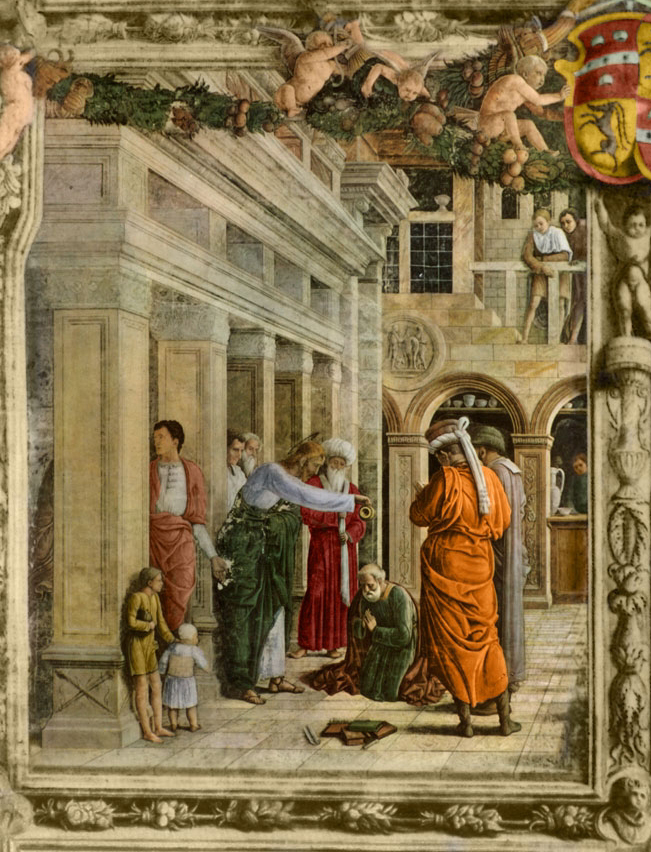
Andrea Mantegna (ca. 1431–1506), St. James Baptizing Hermogenes, 1453–57. Fresco. Ovetari Chapel, Church of the Eremitani, Padua. Destroyed 1944
Above the arcade is a decorative band of alternating panels of purple-red porphyry (roundels) and green serpentine marble (rectangles). This rich coloristic combination is often encountered in late medieval or Renaissance painting, architecture, and sculpture in Venice and Padua, and occasionally elsewhere. Scholars usually call it “traditional” if they note it at all, but this assessment may not do justice to its significance. In praising the marble decoration of the new church of Santa Maria dei Miracoli (ca. 1481–1485), the Venetian diarist Marin Sanudo notes with satisfaction the decision to combine porphyry and serpentine “in the antique manner” (lavorata all’anticha con porfidi et serpentine).[176] A stunning but apparently undiscussed earlier example is at the center of Mantegna’s Martyrdom of St. Christopher in the Ovetari Chapel, in which the depiction of a Roman city square, marked by multiple types of identifiably Roman architectural detailing, includes series of roundels of porphyry and serpentine framing marble relief portraits (fig. 36).[177] This framing / architectural ornament function recalls the use of simulated porphyry and serpentine made by Giovanni d’Alemagna to border istorie in Padua and Venice nearly two decades earlier.
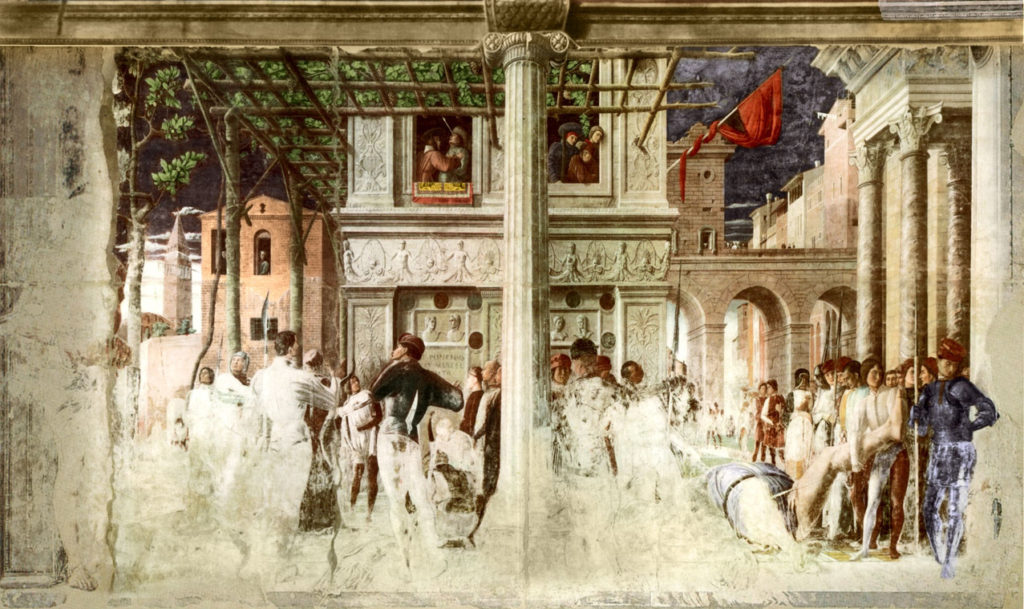
Andrea Mantegna (ca. 1431–1506) and assistants, The Martyrdom of St. Christopher, 1453–57. Fresco. Ovetari Chapel, Church of the Eremitani, Padua. Destroyed 1944
It was under Emperor Constantine (r. 306–337 CE) at his new capital for the Roman Empire at Byzantium, renamed Constantinople, that the ritualizing of imperial spaces through the use of porphyry rotae (roundels of the imperial purple initially implying imperial presence) gained currency, a process begun by earlier emperors in Rome itself. Often combined with serpentine, this “imperial” combination would later be found as well at Ravenna, capital of the Western Roman Empire in the 400s (under Venetian control in the 1400s), and then underwent a kind of apotheosis in Venice within the medieval church of San Marco, crowded with spolia of Constantinople, with porphyry columns whole or sliced to produce the simulations of imperial roundels or rotae that dot the interior paving.[178] The combination appears in paintings by Mantegna and others in an array of situations where it would be appropriate or attractive to adopt “antique” architectural decoration.[179] Dario also used porphyry or porphyry and serpentine in the associated Garden of Love paintings (see figs. 3, 4 ).
The inward-opening window frames with occhio glass (round “eyes,” flattened discs of glass held in place by lead) depicted here (and in the temple of Venus) were common in Venice in the 1460s, though there is no evidence for such glass windows in ancient Rome. Nevertheless, identical windows are inserted in one fanciful representation of the Baths of Diocletian in Marcanova’s Collectio, which was likely Dario’s source.[180]
Representing the Story as a Performance
Within the Abduction series there are two figures who are sufficiently anomalous that resolving their presence may offer insights concerning the context of the commission.[181] The first figure is the buffoon with a tambourine in Scene I, playing the role of mischievous party-planner, wielding his tambourine to draw the queen’s party toward the waiting ship. The second is the man with a staff to which a scarf is attached in the Reception at Troy, dressed like the others in the narrative but seeming to operate outside it.
The comedic element of the buffoon in this istoria of the abduction of Helen of Troy is highly unusual. Istorie representing significant events, actual or imagined, of Renaissance society’s collective memory might include an ancillary vignette of daily life off to the side such as young boys watching a procession or the ubiquitous dogs, providing a moment’s visual diversion from an insistent narrative of war, history, allegory, or ancient myths. However, such paintings did not include unscripted prompts preparing the viewer for explicit humor, which would normally be perceived as an unacceptable disruption to the mood of high seriousness. The grinning buffoon (bufon in the Venetian dialect) or fool has no role in any version of the story identified thus far, and there is little with which to compare him within the context of Italian istorie of the 1400s.[182] The majority of courts of the period employed at least one professional jester/buffoon/fool. Though the merchant patriciate of Venice had long styled themselves as noble, there was no actual court, neither was there the staff that would be associated with a court. The performance of court-like rituals of self-definition were carried out much more communally, and in Venice the buffoons were self-employed.
The buffoon did in fact play a significant role in the contemporary Venetian imagination but in a performative, civic/societal context. He was a frequent character—from sophisticated satirist to rural bumpkin—in the entertaining theatricals—momaria (mummeries)—produced by the city’s compagnie delle calza, “companies or societies of [rich young men in] hose” (the name referencing the distinctive hose these societies chose as their livery). [183] These theatricals were an integral, important, and beloved element of the elaborate feste celebrating weddings and betrothals among the nobility as well of as major civic events that were so distinctive a part of public life in Renaissance Venice. These short-lived societies usually consisted of around twenty young men from rich noble families (averaging 17–20 years old). The statutes of several of them are well documented, but what is known of their activities in the 1400s comes mostly from private correspondence or diaries, such as that of Marin Sanudo beginning in the 1490s. While details such as the number of those at dinner (often over three hundred) are carefully recorded, the subjects of the theatricals, as well as the names of those involved, other than possibly the company, were rarely noted until into the 1500s.
In the later 1400s the identified performances appear to have been either Roman comedies or comedic mummeries/theatricals of local composition of which the texts do not survive.[184] Since Sanudo’s diary entries mention mummeries of the Abduction of Helen, the Judgment of Paris, and other episodes from the Trojan War, audiences must have accepted and enjoyed their performance treated with humor, even mockery.[185] In the Walters paintings the buffoon is complemented by further humorous details—as the indecorousness of the dog wandering into the temple and the timeless moment of recognition in the wonderfully realistic rejection gesture of an agitated young woman among Helen’s companions. Professional buffoons are easy to imagine in rowdy satires of rural bumpkins.[186] But their role in comedic treatments of historical or mythological subjects at this period is unexamined. In the Walters Departure, it could be to provide witty commentary on human nature.
A striking comparison can be made with theatricals offered in 1502 by the Venetian Signoria to Anne de Foix, of the French royal family, recently married by proxy to the king of Hungary, who stopped in Venice on the way to join her husband. These included the Judgment of Paris, including offering the queen a golden apple; and the Abduction of Helen, including an evocation of Cythera. The queen was said to have compared the productions to the mystery plays she was accustomed to at home. She may well have been thinking of the well-known play Mystère de la destruction de Troie la grande, written in 1450–1452 by Jacque Millet, based on Benôit de Saint Maure’s Roman de Troie. Susanne Tichy’s extended probing of the Trojan theme underlying the 1502 theatrics considers similar issues to those entertained above: the complement to the bride’s irresistible beauty and the political overtones of underscoring a joint sense of the past, France’s attachment (like that of Venice) to a myth of Trojan origins.[187]
The staging of these comedic theatricals in the later 1400s must have been varied, although always sumptuous in presentation. Mummeries could apparently be organized rather like a procession, led by a herald, moving between spaces or stage sets that might involve miniaturized architecture such as a castle under siege or make use of galleys or boats on the Grand Canal.[188] Such a description fits the layout of the Walters Abduction series quite well. The issue of staging leads to the second anomalous figure, a richly dressed male in the last scene at the left, away from the action, who stands with his back to us and rests his hand on a staff to which a white veil appears to be attached. This staff is situated in clear view but has proved impossible to explain within the narrative unless the young man is not actually part of the narrative but has a role in the management of the mummery, which except for the “lord” in charge of the event, could be filled by noble amateurs or lower-class professionals.
The comedic elements, presence of anomalous figures, and staging of the narrative lead to the proposition that what we see is an idealized representation of a performance, thus an indirect, light-hearted allusion to the wedding by evoking the theatrics that were performed by one of the compagnie delle calza, most likely the Immortali, of which Caterina’s older brother Giorgio was a member. In that case, Dario di Giovanni’s Abduction of Helen may be understood not only as a series of monumental paintings that seek to bring an exemplary moment in the distant past to life in order to shape an understanding of contemporary events, but a reference to a recent performance of those events in the distant past. As a vehicle for an indirect but lasting commemoration of this wedding so important to the family’s stature, they reference the celebrations of that wedding rather than the wedding itself, slipping between time frames of mythic history to celebrate an event so important for the family’s fortunes but to which they hesitated to put their name.
Coda
There likely came a moment in the 1500s when these paintings no longer suited current taste or filled their owners’ needs. Their subsequent trajectory is, however, unknown until the 1800s, when they reemerge, together. The five paintings were together in the 1800s most likely in Italy, before 1887 the year that the two garden paintings were thought to have been purchased there.[189] At some point prior to that the Walters Reception and the Melbourne Garden of Love were together either literally, i.e., stuck together back to back (or perhaps hung side by side), as there is an exactly matching (if back- to-back) cut-out section of the two (subsequently replaced), as was discussed by John Payne of the National Gallery of Victoria and here by Karen French and Eric Gordon.[190] The two sets of paintings were separated with the two “garden paintings” signaled in the English collection of Harold Ainsworth Peto (1854–1933), possibly purchased in Italy in 1887. At Peto’s death, they were given to different sisters, sold in separate auctions in 1939 and reunited by the Harris gallery, London. With the sale of the Melbourne Garden of Love in 1947, the “garden paintings” went their separate ways.
After the two sets of paintings separated, restoration work was done on the Walters paintings in 1891, presumably in London, as a page from the London Daily Telegraph newspaper from that year was used as facing to protect the paint (see Gordon and French, “Conservation,” in this volume). They were sold at auction in a 1905 sale, Galleria Sangiorgi, Rome, May 2, 1905, lot 142 (Rome, property of Cav. Marcello Galli-Dunn [1842–1912], Castello di Badia, Poggibonsi, Tuscany) with no indication of where or when they were purchased. As Prof. Galli-Dunn rebuilt the castello from a semi-ruin before refurbishing it, the paintings would not have been acquired with the castello.[191] The 1905 purchaser has not been identified, nor is it known who sold them to Henry Walters or when. Walters preferred to limit documentation of his purchases.[192] However, the series was in Walters’ collection by 1915, when it was signaled by Bernard Berenson in an article on Venetian paintings in the United States.[193]
Joaneath Spicer ([email protected]) is the James A.
Murnaghan Curator of Renaissance and Baroque Art at the Walters Art Museum.
In connection with this multiyear, in-house project—the largest in the museum’s history—I owe personal, heart-felt thanks to many: to Julia Marciari-Alexander and Eleanor Hughes for their ongoing support and also to Gary Vikan, under whose directorship the initial conservation stage was approved; to my most immediate colleagues and collaborators: Eric Gordon, Karen French, Pamela Betts, and Glenn Gates; as well as to all those who have contributed to my thinking in larger and smaller ways: Jaynie Anderson, Lisa Anderson-Zhu, Hannah Augst, Mauro Bondoli, Caroline Bruzelius, Stephen Campbell, the Cini foundation, Anna Clarkson, Chris Daly, Anne Dunlop, Patricia Fortini Brown, Daniel Freedberg, Caterina Furlan, Carla Gelao, Joseph Hammond, Holly Hurlburt, Kate Lowe, Andrea Macron, Paola Marini, Mauro Minardi, Jürgen Müller, April Oettinger, Elisabetta Polidori, Dennis Romano, Eugenio Refini, Susannah Rutherglen, the Scarpa family, Walter Stephens, Bernadett Toth, Claudia Wardle, Diane Wolfthal, participants in sessions at the Renaissance Society of America, and the Baltimore Cenacolo, the Journal editors and outside reader.
[1] The spellings and forms of names and myriad other details concerning the Corner and Lusignan families in this essay are based largely on Holly Hurlburt, Daughter of Venice, Caterina Corner, Queen of Cyprus and Woman of the Renaissance (New Haven, 2015).
[2] This issue and the panels’ importance to it were addressed already in 1915 by Bernard Berenson (“Venetian Paintings in the United States: Part Two,” Art in America 3 [1915]: 42–53 at 51); in dating them to around 1465, he wrote: “compositions of a narrative character, both lay and ecclesiastical, must have abounded in Venice before 1480. Yet by an unlucky accident few of any earlier date have been preserved.” This was further adumbrated by Jaynie Anderson in writing of one part of this commission, the Melbourne Garden of Love, within the context of Venetian domestic painting of the 1400s as being comparable to Sandro Botticelli’s Primavera within the Florentine context. Anderson, “Gardens of Love in Venetian Painting of the Quattrocento,” in Rituals, Images, and Words: Varieties of Cultural Expression in Late Medieval and Early Modern Europe, ed. F.W. Kent and Charles Zika (Turnhout, 2005), 201–34 at 202.
[3] Bernard Berenson, in publications of 1915 and 1916 (“Venetian Paintings in the United States,” 51; Venetian Painting in America: The Fifteenth Century [New York, 1916]), dated them ca. 1465 and ca. 1470, which was largely followed, with a few exceptions such as Federico Zeri (Italian Paintings in the Walters Art Gallery, 2 vols. [Baltimore, 1976], 1: no. 161) who proposed 1445–1450, a dating possibly based on his astute noting of a Paduan connection shared with Giovanni d’Alemagna (died 1450).
[4] For provenance, see the Coda at the end of this essay.
[5] Spalliera is here used as a term to encompass large wall paintings that would be installed at shoulder height or higher and that are too large for incorporation in actual pieces of furniture. Whether wall paintings were installed just below the cornice (sometimes called cornici) or further down the wall is generally difficult to establish for domestic spaces, which rarely remain intact. Anne Barrault, Spalliera Paintings of Renaissance Tuscany: Fables of Poets for Patrician Homes (University Park, Pa., 1994),51–73.
[6] Barrault (Spalliera Paintings of Renaissance Tuscany, 43, 67) distinguished the Uccello series from later ones, which she catalogued as spalliere. She considered the Uccello panels together as simply too large for this designation. In the present study I have found it more useful to consider series of large paintings meant for the wall (versus furniture) together.
[7] Materials may of course be transported, but spruce is an inferior wood for this purpose, so its choice elsewhere is unlikely. The initial identification of the wood as spruce was made by Elizabeth Packard and cited in Zeri, Italian Paintings in the Walters Art Gallery 1: 241, but the significance was not recognized. See the recent analysis by French, Betts and Gates, “Painting Technique,” in this volume.
[8] The issues surrounding “magnificence” as a civic virtue of the powerful beginning with Aristotle are brought together in Alison Cole, Virtue and Magnificence: Art of the Italian Renaissance Courts (New York, 1995), with emphasis on the justifying texts written by contemporary humanists: first of all, Giovanni Pontano’s De magnificentia (1497) and earlier Marsilio Ficino’s De virtutibus morabilus (1457) and Cristoforo Landino, De vera nobilitate (1487).
[9] Besides the small panels on classical subjects attributable to Giovanni Bellini and his circle that Susannah Rutherglen, in “Ornamental Paintings of the Venetian Renaissance” (PhD. diss., Princeton University, 2012 [cat. nos. 1–3]), has convincingly discussed as intended for insertion in a restello (a specifically Venetian type of wall cabinet featuring a mirror and places for personal or collected items), and the now-separated panels originally for a cabinet door depicting two women overlooking the Venetian lagoon (cat. no. 7), the author discusses, as her cat. no. 8, two related damaged spalliere (National Gallery, London, and Philadelphia Museum of Art) depicting the story of Alcyone, attributable to Vittore Carpaccio and datable to ca. 1497–1500, as predecessors of the famous Corner commission to Mantegna. There is no information on the commission of the Carpaccio spalliere, but it is hard to imagine that they were not for a Venetian palace, so they are part of the story of spalliera painting in Venice. In this regard, it is not clear why Carpaccio’s The Visit of Hippolyta, Queen of the Amazons, to Theseus, King of Athens (ca. 1495, oil on panel, 102 × 145 cm, Paris, Musée Jacquemart-André) is not discussed as well. In personal communication, Rutherglen has kindly let me know that at the time of her dissertation she was not aware of the Walters spalliere.
[10] For earlier traditions of fresco on courtly themes for domestic decoration in the Veneto, see Anne Dunlop, Painted Palaces: The Rise of Secular Art in Renaissance Italy (University Park, Pa., 2009).
[11] Patricia Fortini Brown, Private Lives in Renaissance Venice: Art, Architecture and the Family (New Haven and London, 2004), 85–86.
[12] Erice Rigoni, L’arte rinascimentale in Padova (Padua, 1970), 53–56.
[13] Ian Holgate is probably correct in interpreting Giovanni d’Alemagna’s decoration of the Corner palace as a “cycle.” Holgate, “Giovanni D’Alemagna, Antonio Vivarini and the Early History of the Ovetari Chapel,” Artibus et Historiae 24, no. 47 (2003): 9–29 at 24. Since Corner, as Podestà, had granted the painter citizenship of Padua in 1430 (Holgate, ibid), the istorie for his palace were therefore likely painted between 1430 and 1436. For Federico Corner and this cycle of paintings as a reference point for later painting commissions by this branch of the Corner family, see Susan Steer, “‘Ell maestro dell anchona’: The Venetian Altarpieces of Bartolomeo Vivarini and Their Commissioners” (PhD diss., University of Bristol, 2003), 106–34.
[14] Rutherglen, “Ornamental Paintings of the Venetian Renaissance,” cat. no. 8; see further note 9 above.
[15] For the commission, initially for four paintings, see Patricia Fortini Brown, Venice and Antiquity: The Venetian Sense of the Past (New Haven, 1996), 252–54; George Knox, “The Camerino of Francesco Corner,” Arte Veneta 32 (1978): 79–84; Clifford Brown, “Andrea Mantegna and the Cornaro of Venice,” Burlington Magazine 116 (1974): 101–3; and Rutherglen, “Ornamental Paintings of the Venetian Renaissance,” cat. nos. 4 and 27.
[16] For Venetian palaces as living spaces, see Brown, Private Lives in Renaissance Venice, 23–52, 71.
[17] To obtain a rough sense of the feasibility of the Walters series installed on a single wall in a principal camera—given that no mid-fifteenth-century palazzi in Venice have really maintained their character, I measured, with the assistance of April Oettinger, the long wall of the principal camera in the fifteenth-century Ca’ d’Oro (now Gallerie Franchetti), that space having its structural integrity. The Walters series, framed, would fit nicely on the long wall.
[18] For the physical complexities of the Melbourne Garden of Love and a different proposal for its original disposition, see Payne, “Restoration Uncovers the Past”; for a discussion of the painting in the context of gardens of love and a revised view of the painting’s initial dimensions, see Jaynie Anderson, “Gardens of Love in Venetian Painting of the Quattrocento.” The attribution has generally been considered in tandem with the Walters paintings, as in Giorgio Fossaluzza, “Dario da Treviso,” in Gli affreschi nelle chiese della Marca trevigiana dal Duecento al Quattrocento: Arte nelle Venezie, I.3: Rinascimento e Pseudorinascimento (Treviso, 2003), 33–77 at 41.
[19] On the history of Venice, works consulted include W. Carew Hazlit, The Venetian Republic: Its Rise, Its Growth and Its Fall, A.D. 409–1797, 2 vols. (New York, 1900); David Chambers, The Imperial Age of Venice, 1380–1580 (New York, 1970); David Chambers, Jennifer Fletcher, and Brian Pullan, Venice: A Documentary History (Oxford, 1992); John Martin and Dennis Romano, Venice Reconsidered: The History and Civilization of an Italian City-State 1297-1797 (Baltimore, 2000); Pietro Bembo, History of Venice, ed. and trans. Robert W. Ulery (Cambridge, Mass., 2007); and Benjamin Arbel, “Venice’s Maritime Empire in the Early Modern Period,” in A Companion to Venetian History, 1400–1797, ed. Eric Dursteler (Leiden, 2013), 125–253.
[20] For the early history of Ca’ Corner della Regina at San Cassiano, currently owned by the Prada Foundation, see Elena Bassi, Palazzi di Venezia: Admiranda Urbis Venetae (Venice, 1978), 166–71. Its appearance today reflects remodeling in the 1720s by Domenico Rossi.
[21] Marin Sanudo, De origine, situ, et magistratibus Urbis Venetae, ovvero La Città de Venetia (1493–1530), ed. Angela Caracciolo Aricò (Venice, 2011), 21; Bassi, Palazzi di Venezia, 88–93; Giandomenico Romanelli, Ca’ Corner della Ca’ Granda: Architettura e committenza nella Venezia del Cinquecento (Venice, 1993). Its appearance today reflects Jacopo Sansovino’s design of the mid-1500s.
[22] On the Corner family, see Aldo Berruti, Patriziato Veneto: I Cornaro (Turin, 1952). On the Venetian nobility as a class, see Dennis Romano, Patricians and Popolani: The Social Foundations of the Venetian Renaissance State (Baltimore, 1987); David Rosand, Myths of Venice: The Figuration of a State (Chapel Hill, 2001); and Patricia Fortini Brown, Private Lives in Renaissance Venice: Art, Architecture and the Family (New Haven and London, 2004), 1–22. By the early 1500s, with the reduction in the profits from trade, it has been estimated that the majority of the nobility actually relied on public offices for their income. Patricia Fortini Brown, Venetian Narrative Painting in the Age of Carpaccio (New Haven, 1988), 25. See also David Chambers, Patrons and Artists in the Italian Renaissance (New York, 1971); Stanley Chojnacki, Women and Men in Renaissance Venice: Twelve Essays on Patrician Society (Baltimore, 2000); Tracey A. Cooper, “Art and Patronage in Venice: Patricians and Citizens,” in Venice and the Veneto, ed. Peter Humfrey (Cambridge, 2008), 151–203.
[23] The Cornelian theme would be most fully explored (per extant texts) in the funeral oration for Marco Corner in 1479 (Hurlburt, Caterina Corner, 115). Nevertheless, I would argue that it was in regard to Caterina as a queen that the Cornelian bloodlines would be most publicly in play. For Bartolomeo Pagello, “De nuptiis Zachi Cypriorum regi et Catherinae Corneliae ex sanguine Venetorum,” see Pagello, Poesie inedite di Bartolomeo Pagello, celebre umanista, ed. Francesco Zordan (Tortona,1894), and Hurlburt, Caterina Corner, 13. For the continuation of this vein, see Tobias Leuker, “La venere di casa Cornelia: Giovanni d’Arezzo e le sue poesie per Caterina Cornaro,” in Caterina Cornaro, Last Queen of Cyprus and Daughter of Venice, ed.Candida Syndikus and Sabine Rogge (Münster, 2013), 168–86.
[24] Hurlburt, Caterina Corner, 40–41. See also Arnaldo della Torre, Paolo Marsi da Pescina, vol. 1 ofIndagini di storia letteraria e artistica (Capelli, 1903–1907), 197, who cites the suggestion that the humanist Francesco Nursi was Caterina’s tutor. Since Nursi was born in 1453, this is not possible; however, he did serve as her secretary later in life.
[25] On the 1600-ducat limit, see Stanley Chojnacki, “From Trousseau to Groomgift in Late Medieval Venice,” in Medieval and Renaissance Venice: Studies in Honor of Donald E. Queller, ed. Ellen E. Kittell and Thomas F. Madden, (Chicago, 1999), 141–65 at 146.
[26] Hurlburt, Caterina Corner, 16–20.
[27] Antonio Colbertaldo, Storia di Caterina Corner regina di Cipro (la prima biografia), ed. Daria Perocco (Padua, 2012), 116.
[28] The existence of such a portrait is questioned by Hurlburt, Caterina Corner, 40–41, for want of a reference within the surviving negotiation documents.
[29] Vasari (Le vite de’ più eccellenti pittori, scultori e architettori [Florence, 1568]) reports in his “Life of Jacopo Bellini” that the artist (ca. 1400–ca. 1470) painted portraits of both Caterina and her brother Giorgio when the painter was young. That is clearly impossible and reflects some confusion.
[30] When Peter Humfrey (“The Portrait in Fifteenth-Century Venice,” in The Renaissance Portrait from Donatello to Bellini, ed. Keith Christiansen and Stefan Weppelmann, exh. cat. New York, Metropolitan Museum of Art [New York, 2011], 64–76 at 66), wrote that in the absence of a court, Venetian “patrician families did not, moreover, seek extra-Venetian marital alliances that might have stimulated portraits of potential brides,” he forgot about Caterina Corner, whose portrait by Gentile Bellini he discusses a few paragraphs later.
[31] While references abound concerning individual portraits of prospective brides (e.g., Everett Fahy, “The Marriage Portrait in the Renaissance,” in Art and Love in Renaissance Italy, ed. Andrea Bayer, exh. cat. New York, Metropolitan Museum of Art [New York, 2008], 17–28 at 21–23), there does not appear to be an overarching discussion.
[32] Zita Rohr, “Lessons for My Daughter: Self-fashioning Stateswomanship in the Late Medieval Crown of Aragon,” in Self-Fashioning and Assumptions of Identity in Medieval and Early Modern Iberia, ed. Laura Delbrugge (Leiden, 2015), 46–78 at 65.
[33] Lorne Campbell, Renaissance Portraits: European Portrait-Painting in the Fourteenth, Fifteenth, and Sixteenth Centuries (New Haven and London, 1990), 197, quoting Nicholas Harris Nicolas, Journal . . . during an Embassy to Negotiate a Marriage between Henry VI and a Daughter of the Count of Armagnac (London, 1828), 10.
[34] Luke Syson, “Zanetto Bugatto, Court Portraitist in Sforza Milan,” Burlington Magazine 138 (1996): 300–308.
[35] Hurlburt, Caterina Corner, 33.
[36] Colbertaldo, Storia di Caterina Corner, 116, my paraphrase of: “una fanciuletta la cui fronte rassembrava il chiaro cielo, le guancie non invidiavano le vermiglie rose, le labra a simiglianza di coralli et erano preggiate perle li denti; vinceva il collo la neve, le ciglia nere, le vaghe luci degl’ occhi a simiglianza di due stelle ardenti, né havea sì ascose le mamelle nel velo ch’alquanto non si mirassero, oltre l’aurate chiome ch’in rete d’oro. . . .”
[37] For Petrarch and the evolution of conventions of female beauty in the Renaissance, see Cropper, “On Beautiful Women, Parmigianino, Petrarchismo, and the Vernacular Style.” How Venetian women achieved the desired golden locks and pale skin with a light blush to the cheeks is addressed by Janet Stephens, “Becoming a Blond,” in this volume.
[38] As Maiden with the Unicorn, tempera and Pressbrokat on spruce, 39 × 35 1/2 in. (100 × 90 cm), Esztergom, Christian Museum, inv. 55.212, from the collection of Arnold Ipolyi (1823–1886). Miklós Boskovits, Miklós Mojzer, and András Mucsi, Das Christliche Museum von Esztergom, 2nd ed. (Budapest, 1967), no. 25 as Lombard painter, middle of the fifteenth century; Bernadett Toth, in her unpublished master’s thesis, “The Lady of the Unicorn of Esztergom” (summary in English kindly prepared by the author), takes a different line of interpretation than that followed here.
[39] There are no extant contemporary images of the wedding, but neither are there of any other Venetian wedding from this period.
[40] See Hurlbert, Caterina Corner, 37–40.
[41] Pietro Bembo, History of Venice, ed. and trans. Robert W. Ulery (Cambridge, Mass., 2007), book 1, lines 30–35.
[42] Toderini, Cerimoniali e feste in occasione di avvenimenti e passaggi nelli stati della replica veneta di duchi, arcidughi et imperatori dell augustisisma casa d’Austria dall’ anno 1361 al 1797, 14, as quoted by Susanne Tichy, “Et vene la mumaria. . . . ”: Studien zur venezianischen Festkultur der Renaissance (Munich, 1997), 42. In personal communication Hurlburt has questioned the reliability of this source in reference to the use of “Cornelia” here. I cannot assess that; however, since Pagello’s poem of 1468–1474 (which Hurlburt cites in a different context) uses “Cornelia” in reference to Caterina as well, I did not see a reason to doubt the chronicle’s description. I would suppose that the poet would use the term as one easily recognized by the reader.
[43] See note 23.
[44] See Hurlburt, Caterina Corner, 51–100; Benjamin Arbel, “The Reign of Caterina Corner as a Family Affair (1474-1489),” Studi Veneziani 26 (1993): 67–85; Arbel, “A Fresh Look at the Venetian Protectorate of Cyprus (1474–89),” in Sydikus and Robbe, Caterina Cornaro, 213–30.
[45] Hurlburt, Caterina Corner, 101–127; Holly Hurlburt, “Body of Empire: Caterina Corner in Venetian History and Iconography,” Early Modern Women 4 (2009): 61–99.
[46] Hurlburt, Caterina Corner, 129–77.
[47] Holly Hurlburt, “À la Cypriota: Gentile Bellini, the Queen of Cyprus, and Familial Ambition,” in Reflections on Renaissance Venice: A Celebration of Patricia Fortini Brown, ed. Blake de Maria and Mary E. Frank (Milan, 2013), 32–39.
[48] Monica Molteni, “Per l’iconografia cinquecentesca di Caterina Cornaro,” in Sydikus and Rogge, Caterina Cornaro, 11–32; Hurlburt, Caterina Corner, 219–35. From the remaining art and prints after lost paintings, a lost (?) painting of the abdication by Paolo Veronese, known through a nineteenth-century engraving (Hurlburt, Caterina Corner, fig. 63), was easily the most accomplished. There are several purported portraits of her probably executed after her death—for examples in the museum at Asolo (Fossaluzza, Museo Civico di Asolo, no. 104) or Nicosia (Hurlburt, Caterina Corner, fig. 59) that appear to derive from a lost original. It would be in a fresco series on her life for the portego of Ca’ Corner della Regina by Costantino Cedini (1741–1811), that the sorrows of the young queen’s life found a place in art.
[49] Galleria Sangiorgi, Rome, Catalogo della vendita di rarissimi quadri, bronzi, arazzi, marmi mobili ed oggetti di curiosità del Prof. Cav. M. Galli Dunn, May 2, 1905, lot 142. Lionello Venturi, “Corriere, L’aste pubblica Sangiorgio,” L’Arte 8, no. 3 (1905): 223–25 at 225. See Zeri, Italian Paintings in the Walters Art Gallery, 1:187, for a listing of attributions up to 1968/1969, when his research on these paintings ceased. See the Coda at the end of this essay for the provenance.
[50] Berenson, Venetian Painting in the United States, 51–55. Henry Walters apparently bought the paintings as given to Fiorenzo di Lorenzo (Perugia, ca. 1440–1522), an attribution known today only because it was rejected by Berenson (1916). In 1946, Roberto Longhi proposed a little-studied Vivarini follower, Antonio Rosso (1450–1510), but neither did this name find support (Viatico per cinque secoli di pittura veneziani [Florence, 1946], 51, as “a fragment of a cassone”).
[51] Proposed by Rodolfo Pallucchini, I Vivarini, (Venice, 1961), 81, 86. Fra Antonio Falier da Negroponte (active ca. 1460s, Venice), within the circle of influence of Vivarini’s circle, whose only established painting is the Madonna and Child Enthroned in the Venetian church of San Francesco della Vigna, was proposed by Mauro Lucco in 1990: “Venezia,” in La pittura nel Veneto, 2: Il Quattrocento, ed. Mauro Lucco (Milan 1990), 391–480 at 400. A further variation proposed by Jaynie Anderson in 2005 imagined “a Florentine artist working in the Vivarini studio or a Venetian who had immigrated to Florence”: “Gardens of Love” at 212.
[52] Zeri, Italian Paintings in the Walters Art Gallery, 1: nos. 160–162, includes a more detailed list of attributions up to 1968/1969, apparently his cut-off point for research.
[53] Luigi Coletti, Pittura veneta del Quattrocento, xliv, lxxxi n. 55 (Novarra, 1953). The post-1900 literature specifically devoted to the artist includes essays or parts of essays dedicated to him by Giuseppe Gerola, “Dario Pittore,” in Miscellanea di studi in onore di Attilio Hortis (Trieste, 1910); Andrea Benedetti, “Cerdoni(s) Dario,” in his Brevi notizie sui Pordenonesi illustri (Pordenone, 1952), 17–18; Italo Furlan, “Dario di Pordenone,” Il Noncello 28 (1968): 3–32; Luigi Pesce, Vita socio-culturale in Diocesi di Treviso nel primo Quattrocento (Venice, 1983), 226–31; Giorgio Fossaluzza, “Treviso,” in Mauro Lucco, La pittura nel Veneto, 2: La Quattrocento (Milan, 1989), 541–72 at 541–46; and Giorgio Fossaluzza, “Dario da Treviso,” in Gli affreschi nelle chiese della Marca trevigiana dal Duecento al Quattrocento. Arte nelle Venezie, I.3 Rinascimento e Pseudorinascimento (Treviso, 2003), 33-77. There are also lexicon overviews by D. von Hadeln, “Dario di Giovanni,” in Ulrich Thieme ed., Allgemeines Lexikon der Bildende Künstler 8 (Leipzig, 1913), 404–5; Giovanna Baldissin Molli, “Dario di Giovanni,” in Dizionario biografico degli italiani, vol. 32 (Rome, 1986), 51; Paolo Casadio, “Dario da Pordenone/Dario di Giovanni, detto anche Dario da Treviso,” in Lucco, La pittura nel Veneto: Il Quattrocento, vol. 2: 743–44; Ugo Ruggeri, “Dario (di Giovanni) da Treviso,” in The Dictionary of Art, ed. Jane Turner, vol. 8 (London, 1996), 526. G. Bergamini, “Dario di Giovanni,” in Saur allgemeines Künstler-Lexikon: Die bildenden Künstler aller Zeiten und Völker 24 (Munich, 2000): 287–88; and various exhibition and permanent collection catalog entries.
[54] Gerola, “Dario Pittore” (1910), first pulls together archival work on the artist, drawing on work published in 1908 as Vittorio Lazzarini and Andrea Moschetti. Documenti relativi alla pittura padovana del secolo XV (Bologna, reissued 1974). Most known archival documents were brought together by Giorgio Fossaluzza, “Dario da Treviso,” 74–77, to which I will hereafter refer.
[55] Furlan, “Dario da Pordone,” 7–9.
[56] Miklós Boskovits rejected the attribution (without comment) in a footnote to “Una ricerca su Francesco Squarcione, Paragone 325 (1977): 40–70 at 66 n. 50. Giorgio Fossaluzza did not mention the Abduction series in his 1990 overview of Dario’s works in “La pittura nel Veneto: Treviso,” 540–44; however, the biographical survey of the artist in the same publication, by Paolo Casidio, does (744). In 2003, Fossaluzza, “Dario da Treviso,” 51 and n. 90, illustrated all the paintings here considered part of the Corner commission (as Master of the Story of Helen) and noted the earlier attribution to Dario, but retains the attribution to the Master of the Story of Helen in the circle of Vivarini.
[57] In a panel on regionalism in Italian Renaissance painting organized by Campbell at the annual meeting of the Renaissance Society of America, March 17, 2019. See further note 60.
[58] Betts and Gates, “Dressed in Tin” in this volume.
[59] It is generally agreed that the actual execution of the foliage in Garden with a Trellis of Roses does not appear to be by the same hand as that in the Walters paintings but is closer to that seen in paintings from the Vivarini workshop as the Santa Sabina Altarpiece (see fig. 11) and in the Madonna and Child Enthroned by Antonio da Negroponte in San Francesco della Vigna, a painting from that same circle.
[60] The characterization of the woman in the red gown and white cape in the Departure is sufficiently close to her counterpart in Piero’s Finding of the True Cross that it cannot be a coincidence, as Stephen Campbell pointed out in a talk at the Walters Art Museum on October 14, 2014.
[61] On artists’ movements in the Renaissance, see David Young Kim, The Traveling Artist in the Italian Renaissance: Geography, Mobility, and Style (New Haven, 2014); Stephen J. Campbell and Stephen J. Milner, “Art, Identity, and Cultural Translation in Renaissance Italy,” in Artistic Exchange and Cultural Translation in the Italian Renaissance City, Stephen J. Campbell and Stephen J. Milner, eds., (Cambridge, 2004), 1–13; Stephen Campbell. “Artistic Geographies,” in Cambridge Companion to the Italian Renaissance, ed. Michael Wyatt (Cambridge, 2014), 17-39.
[62] Fossaluzza, “Dario da Treviso,” doc. 2.
[63] Fossaluzza, “Dario da Treviso,” doc. 1, which further indicates that Dario will receive a salary but will be also instructed in art, specifically drawing.
[64] Giorgio Vassari, Le vite de’ più eccellenti pittori, scultori e architettori (Florence, 1568), 488; Carlo Ridolfi, Le meraviglie dell’arte dell’arte ovvero le vite degli illustri pittori Veneti e dello stato (Venice, 1648), 68.
[65] Fossaluzza, “Dario da Treviso,” doc. 21.
[66] Gerola, “Dario Pittore,” 886.
[67] See Gerola, “Dario Pittore”; Furlan, “Dario da Pordenone”; and Fossaluzza, La pittura nel Veneto: “Treviso.”
[68] Fossaluzza, “Dario da Treviso,” doc. 16 (doge’s palace, Venice).
[69] On Dario’s retouching (1451) of a polychromed Crucifix (Fossaluzza, “Dario da Treviso,” his figs. 15.22 and 15.23, carried in Good Friday processions and belonging to the church of the Hospital of the Mendicants (still in situ), in Treviso: Luigi Pesce, Vita socio-culturale in diocesi di Treviso nel primo Quattrocento (Venice, 1983), 229; Fossaluzza, “Dario da Treviso,” 38–39 (suggesting that the wood carver might have been Angelo dal Mangano, with whom Dario had recently worked); Markham Schulz, “Antonio Bonvicino and Venetian Crucifixes of the Early Quattrocento,” Mitteilungen des Kunsthistorischen Institutes in Florenz 48, no. 3 (2004): 293–332 at 319–20, demonstrates decisively that the Crucifix is from the workshop of Antonio Bonvicino and datable to around 1415. On the art belonging to the church and hospital, see David Michael D’Andrea, Civic Christianity in Renaissance Italy: The Hospital of Treviso, 1400–1530 (Rochester, 2007).
[70]Mikló Boskovits, “Ricerca su Franceso Squarcione,” Paragone 325 (1977): 40–70; Irena Faveretto, “La racolta di sculture antiche di Francesco Squarcione tra leggenda e realtà,” in Francesco Squarcione: Pictorum Gymnasiarcha Singularis: Atti delle giornate di studio Padova, 10–11 febbraio 1998, ed. Alberta de Nicolò Salmazo (Padua, 1999); Alberta De Nicolo Salmazo, “Andrea Mantegna e Padova, 1445–1460,” in Mantegna e Padova, 1445–1460, ed. Davide Banzato et al., exh. cat. Padua, Museo Eremitani (Milan, 2006), 3–27.
[71] For the documents, discussion, and illustration of the Portrait of Bernardino of Siena, see Roberto Cobianchi, “Fashioning the Imagery of a Franciscan Observant Preacher: Early Renaissance Portraiture of Bernardino of Siena in Northern Italy,” I Tatti Studies in the Italian Renaissance 12 (2009): 55–83; K.V. Shaw and T.M. Boccia Shaw, “Further Observations on a Quattrocento ‘Ymago Sancti Bernardini’ in the Santo,” Il Santo 36, no. 3 (1996): 475–85 at 482; and Roberto Cobianchi, “Lo temperato uso dele cose”: La committenza dell’Osservanza francescana nell’italia del Rinascimento (Spoleto, 2013). Another full-length portrayal of Bernardino, after his canonization, in the Los Angles Museum of Art has been attributed to Dario (Susan L. Caroselli, Italian Panel Painting of the Early Renaissance in the Collection of the Los Angeles County Museum of Art [Los Angeles, 1994], no. 4), but the handling of the drapery is sufficiently different as to make the attribution problematic.
[72] Fossaluzza, “Dario da Treviso,” doc. 3; Raimondo Callegari, “Opere e committenze d’arte rinascimentale a Padova,” Arte Veneta, 58 (1996): 7–29 at 9; Ian Holgate, “Giovanni D’Alemagna, Antonio Vivarini and the Early History of the Ovetari Chapel,” Artibus et Historiae 24, no. 47 (2003): 9–29 at 10.
[73] Fossaluzza, “Dario da Treviso,” n. 34 and doc. 4. For Pietro de’ Maggi, see Paolo Sambin, “Spigolature d’archivio, 2: I Maggi da Milano famiglia e scuola di pittori nella Padova quattrocentesca,” in Atti e memorie dell’Accademia Patavina, part 3: Memorie della Classe di scienze morali lettere ed arti,vol. 88 (1975/76): 213–35.
[74] There appears to be no overarching study of the artistic environment in Padua in the 1440s or 1450s. For the progressive aspects of this environment, I look forward to the forthcoming study by Sarah Blake McHam. For the present, see her “Padua, Bassano, and Treviso,” in Venice and the Veneto, ed. Peter Humfrey (Cambridge, 2007), 207–251; Alberta De Nicolo Salmazo, “Andrea Mantegna e Padova, 1445–1460,” in Mantegna e Padova 1445–1460, ed. Davide Banzato et al. (Milan, 2006), 3-27; Italo Furlan, “Aspetti della pittura a Padova nella seconda metà del quattrocento,” in Dopo Mantegna: Arte a Padova e nel territorio nei secoli XV e XVI, exh. cat. Padua, Palazzo della Ragione (Milan, 1976); Hugo Chapman, Padua in the 1450s: Marco Zoppo and His Contemporaries, exh. cat. London, British Museum (London, 1998); Lucco, La pittura nel Veneto: “Padova;” and Erice Rigoni, L’arte Rinascimentale in Padova (Padua, 1970) (documents). For the surprisingly extensive activities of German artists in Padua, one need look elsewhere, for example to the scattered references in Philippe Braunstein, Les Allemands à Venise (1380–1520) (Rome, 2016).
[75] For an overview of the enigmatic Pizzolo, see Mattia di Vinco, “Pizzolo, Niccolò di Pietro di Giovanni,” Dizionario Biografico degli Italiani, vol. 84 (2015) (online ed.).
[76] For a large Crucifixion fresco (Trevisio, Museo Civico) from this period, see Fossaluzza, La pittura nel Veneto: Treviso, 542.
[77] Furlan, “Dario da Pordenone,” 19.
[78] Fossaluzza, “Dario da Treviso,” 39–40, doc. 16.
[79] Continuing this line of speculation, the fresco needing work could have been the grandest of them all—an immense Paradise, centered on the “Coronation of the Virgin,” painted in 1365–66 by the Paduan Guariento d’Arpo, whose work Dario would have known well.
[80]The beginning of this period is marked by the frescoed, wreathed Madonna and Child on a Flowery Mound, signed and dated 1459 (Asolo, Museo Civico) and said to be from the destroyed church of San Biagio in Asolo, for which see Fossaluzza, Museo civico di Asolo, no. 1, with earlier literature.
[81] Fossaluzza, “Dario da Treviso,” 47–48, 51–56. For the church as consecrated in the early 1300s as S. Angelo and belonging to the Franciscans: Andrea da Mosto, ed. L’Archivio di stato di Venezia: Indice generale, storico, descrittivo ed analitico, 2: Archivi degli istituti religiosi (Rome, 1940), 156.
[82] Edward S. King, “The Legend of Paris and Helen,” Journal of the Walters Art Gallery 2 (1939): 54–72 at 55.
[83] The implied composition (if complete) of the niche would be in conflict with the arch surrounding St. Gotthard; it is not clear how one should read this. The striking head of the Franciscan is identified as “Venetian School, St. Blaise” (Biagio) by Fossaluzza (“Dario da Treviso,” his fig. 15.1, 15.43, 15.78, 15.79), though in 1990 the author gave the figure to “Dario da Treviso (?)” (Fossaluzza, “Treviso,” his fig. 630).
[84] Fossaluzza, “Dario da Treviso,” his fig. 15.92.
[85] On the museum website, it is cataloged as Antonio Vivarini and in Romanelli, I Vivarini, no. 7 as Antonio and Bartolomeo Vivarini by Clara Gelao, who has kindly looked at the attributional issue with me and found the comparison with heads from the Reception convincing.
[86] Fossaluzza, “Dario da Treviso,” doc. 24 (stay in Padua in 1466).
[87] Attributed to Dario by Coletti and Furlan. On the chapel, see the chapter by Caterina Furlan, “‘Per dar maggiore vaghezza et splendore alla chiesa’: La decorazione pittorica dalla metà del Quattrocento alla fine del Cinquecento,’” in San Marco di Pordenone, ed. Paolo Goi, 3 vols. (Fiume Veneto, 1993), 1: 259–63 . She accepts the weight of the rejections (for example, by Zeri) of the attribution to Dario made by her brother Italo Furlan and cites the artist as the Master of the Story of St. Nicholas. For the ennoblement of the family, see Andrea Marcon, “Storie di famiglie e palazzi / Histories of Families and Palaces,” in Pordenone: Sulle rive del Noncello / On the Banks of the Noncello, ed. Paolo Pastres (Cittadella, 2010), 65–67 at 65. For the holders of the position of Podestà of Pordenone, see https://it.wikipedia.org/wiki/Sindaci_di_Pordenone.
[88] The earlier photograph in Furlan, “Per dar maggiore vaghezza et splendore alla chiesa,” (her fig. 7), shows the face and much of the head obliterated.
[89] G. B. Cavalcaselle revised by Giuseppe Bergamini, La pittura friulana del Rinascimento (Vicenza, 1973), 298.
[90] Fossaluzza, “Dario da Treviso,” doc. 28: a dispute with the patron, the nobleman Matteo Betignoli, 1469, when he (more likely assistants) carried out decorative detailing of a façade in Serravalle.
[91] Fossaluzza, “Dario da Treviso,” doc. 29 for a chapel in the Church of San Francesco (1471–72).
[92] Fossaluza, “Dario da Treviso,” doc. 32, his fig. 15.102, 15.16, 15.17.
[93] As articulated by the Florentine Leonbattista Alberti in his treatise On painting (De pittura [1435], Book 2).
[94] Brown, Venetian Narrative Painting, 3.
[95] In this regard, a small painting of a Roman Triumph (77.3 × 50.5 cm) should be noted. It has been linked to the Walters Abduction series since Zeri’s proposal in 1976 (Italian Paintings in the Walters Art Gallery, 1:237). Its present location is unknown, but in 1925 it was in the collection of Eugen Jacobi, Frankfurt-am-Main, and around 1955 was for sale in Paris (Ausstelung von Meisterwerken alter Malarei aus Privatbesitz, Staedel Institut in Frankfurt, 1925, no. 62, as Ferrarese School, 15th century). It could well have been intended for insertion in a door for a cabinet. There it could represent a visualization of the “Triumph of P. Cornelius Scipio Africanus,” thus decades before a descendant commissioned such a painting from Bellini (fig. 2), as discussed above. This type of painting for furniture is discussed by Susannah Rutherglen in “Painting at the Threshold: Pictures for Doors in Renaissance Venice,” Art Bulletin 98, no. 4 (2016): 438–65. The composition and architectural setting appear to combine characteristics of the well-known Roman relief The Triumph of Marcus Aurelius (Musei Capitolini) and Dario’s favorite Roman rotae, as in the “Garden of Love” paintings and The Reception of Helen at Troy.
Two further paintings of Roman generals, one identified within the painting as Scipio Africanus in the National Gallery, Prague (inv. O 11982/D.O.-894, 171.5 x 69 cm; see P. Pribyl and O. Pujmanova. Italian Painting, c. 1330–1550, 1: National Gallery in Prague, 2: Collections in the Czech Republic. Illustrated summary catalogue [Prague, 2008], 48–49, and the other, called A Roman General (Julius Caesar?) belonging to the Harvard Art Museums (inv. 1958.25, now cut down), were grouped with other paintings called Master of the Story of Helen by Zeri. In the interim, that relationship was reasserted by Christiane Joost-Gaugier, “A Rediscovered Series of Uomini Famosi from Quattrocento Venice,” Art Bulletin 58, no. 2 (1976): 184–95; and by Fossaluzza, “Dario da Treviso,” 50. It is attractive to imagine a member of the Corner family commissioning a series of “Famous Men” including Scipio, but the stylistic similarities to other works accepted here as by Dario are insufficient to claim these paintings for him. As has been noted, the Prague painting is quite close in style and use of motifs to a St. Michael in Berlin (Gemäldegalerie). Though attributed by Zeri, Italian Paintings in the Walters Art Gallery, 1:237, to the Master of the Story of Helen, St. Michael is surely from the Vivarini workshop, while the stern, linear face of the Fogg’s Roman General might be assignable to Marco Zoppo, then working in Venice.
[96] The subject of the Walters series was first correctly identified in 1923 by Paul Schubring, Cassoni: Truhen und Truhenbilder der italienischen Frührenaissance. 2nd ed. (Leipzig, 1923), 423.
[97] For tapestries, see Scot McKendrick, “The Great History of Troy: A Reassessment of the Development of a Secular Theme in Late Medieval Art,” Journal of the Warburg and Courtauld Institutes 54 (1991): 43–82; Paul. Asselberghs, “Les tapisseries tournaisiennes de la guerre de Troie,” Revue Belge d’Archéologie et d’Histoire de l’Art 39 (1970): 103–12. For the illuminated manuscript tradition, see C. Durand, Illustrations médiévales de la légende de Troie: Catalogue commenté des manuscrits fr. illustrés du Roman de Troie et de ses dérivés (Turnhout, 2008); Hugo Buchthal, Historia Troiana: Studies in the History of Mediaeval Secular Illustration (London, 1971; and Judy Kem, Jean Lemaire de Belges’s Les Illustrations de Gaule et singularitez de Troye: The Trojan Legend in the Late Middle Ages and Early Renaissance (New York, 1994), esp. 125–34.
For an overview of subjects chosen, see Alan Shepard and Stephen D. Powell, Fantasies of Troy: Classical Tales and the Social Imaginary in Medieval and Early Modern Europe (Toronto, 2011); and Margaret Scherer, The Legends of Troy in Art and Literature (New York, 1964).
[98] For the importance of foundation myths, focused on the Venetian attachment to the myth of Trojan origins, see Brown, Venice and Antiquity, 3–45; Egidio Gorra, Testi inediti di storia trojana preceduti da uno studio sulla leggenda trojana In Italia (Turin, 1887); Antonio Carile and Giorgio Fedalto. Le origini di Venezia (Bologna, 1978); Edward Muir, Civic Ritual in Renaissance Venice (Princeton, 1981); Serban Marin, Il mito delle origini: La cronachistica veneziana e la mitologia politica della città lagunare nel Medio Evo (Ariccia, 2017); Christian Baier, “Homer’s Cultural Children: The Myth of Troy and European Identity,” History and Memory 29, no. 2 (2017): 35–62.
[99] The continuing power of this myth is seen in modern Turkish officials citing it in their arguments for Turkey joining the European Union (Baier, “The Myth of Troy and European Identity,” 52–53). The Turkish claim to Trojan ancestry found a champion in Gian Mario Filefo’s (1426–1480) “Amyris,” apparently commissioned by a patron wishing to gain stature with the Ottomans. See Christian Peters, “Claiming and Contesting Trojan Ancestry on Both Sides of the Bosporus–Epic Answers to an Ethnographic Dispute in Quattrocento Humanist Poetry,” in The Quest for an Appropriate Past in Literature, Art and Architecture, ed. Karl A.E. Enenkel and Konrad Adriaan Ottenheym (Leiden, 2018), 15–46.
[100] On the early history of Venice, see W. Carew Hazlitt, The Venetian Republic: Its Rise, Its Growth and Its Fall, A.D. 409–1797, 2 vols. (New York, 1900); David Chambers, Jennifer Fletcher, and Brian Pullan, Venice: A Documentary History, 1450–1630 (Oxford, 1992).
[101] Less romantically, those whom historians today think settled the islands of the lagoon in the 400s, seeking refuge from marauding Huns under Attila, included descendants of Roman families from the region of Padua so that, in 697 CE—claimed in early histories of the city as the date of the election of the first duke or doge (Venetian dialect)—the families listed as involved, among whom the Corner, were in part of legitimately Roman magistrate origin.
[102] These included both the fifteenth-century historian Flavio Biondo, and famous authors from antiquity, Strabo and especially the Roman Titus Livius Pativinus (from Padua), in claiming to go back, as he had in a previous study of the early doges, ab urbe condita (from the founding of the city), the famous opening line of Livy’s history of Rome that Sanudo counted on readers to recognize. Marin Sanudo, De origine, situ, et magistratibus urbis venetae, ovvero ca città de Venetia (1493–1530), ed. Angela Caracciolo Aricò (Venice, 2011), 9–13.
[103] In fact, the historians he cites do not connect Trojans with the islands that make up Venice; it was the unnamed medieval Venetian chroniclers who nurtured the myth, but citing them would not add luster to his argument.
[104] Marin Sanudo, I Diarii (Bologna, 1969), 56, 751.
[105] Patricia H. Labalme, Bernardo Giustiniani: A Venetian of the Quattrocento (Rome, 1969), 262.
[106] Characteristic items produced in Venice in the 1400s were bridal caskets made in the Embriachi family workshop, of which several extant today are decorated with episodes from the life of Paris, as Bridal Casket with Episodes from the Life of Paris (Walters Art Museum, acc. no. 71.242). Further afield, identification as “the new Helen” was an aspect of the iconography of Marguerite of York at her 1468 marriage with Charles the Bold, duke of Burgundy (of the French royal family), for which see Paul Asselberghs, “Marguerite d’York, la nouvelle Hélène, et les tapisseries tournaisiennes de la Guerre de Troie,” in Marguerite d’York et son temps, exh. cat. Brussels, Banque de Bruxelles (Brussels, 1967), 17–23. Within months of her marriage, the duchess commissioned Recuyell of the Histories of Troy from William Caxton, printed in 1473.
[107] For paintings for marriage cassoni, see Paul Schubring, Cassoni: Truhen und Truhenbilder der italienischen Frührenaissance, 2nd ed. (Leipzig, 1923). Claudio Paolini, Daniela Parenti, and Ludovica Sebregondi, Virtù d’amore: Pittura nuziale nel Quattrocento fiorentino (Florence, 2010); Cristelle Baskins, ed. The Triumph of Marriage: Painted Cassoni of the Renaissance, exh. cat. Boston, Isabella Stewart Gardner Museum (Boston, 2009). For the Abduction formerly in the Metropolitan Museum, see Sotheby’s (New York), January 26, 2016, lot 410, and Ellen Callman, Apollonio di Giovanni (Oxford, 1974), no. 32. Relevant comparisons include the birth tray with Abduction of Helen by Zanobi Strozzi (National Gallery, London) and the Master of the Judgment of Paris (Dillian Gordon, National Gallery Catalogues: The Fifteenth Century Italian Paintings, vol. 1 [London, 2003], 426–33).
[108] On marriage in Venice, see Alexander Cowan, Marriage, Manners and Mobility in Early Modern Venice (Aldershot, 2007); Brown, Private Lives in Renaissance Venice; Patricia H. Labalme, “How to (and How Not to) Get Married in Sixteenth-Century Venice (Selections from the Diaries of Marin Sanudo),” Renaissance Quarterly 52 (1999): 43–72. Jacqueline Maria Musacchio, Art, Marriage, and Family in the Florentine Renaissance Palace (New Haven, 2008).
[109] See note 97.
[110] It is not among the individual subjects noted in McKendrick, “The Great History of Troy.” However, tapestries of “The Judgment of Paris” are twice noted as possessions of female members of the British or French royal houses.
[111] Ruby Blondell, “The Problem of Female Beauty,” in her Helen of Troy: Beauty, Myth, Devastation (Oxford, 2013), 1–26. The Roman (not Greek) names for the gods are used here since that is what Italians in the 1400s used.
[112] Dictys, Ephemeris Belli Troiani, I,5.
[113] Francis de Pernisiis, Bishop of Famagusta, in his 1473 epitaph for Jacques II (Hurlburt, Caterina Corner, 51).
[114] Colbertaldo, Storia di Caterina Corner, Regina di Cipro,117.
[115] Quoted from Hurlbert, Caterina Corner, 13; Hurlburt signaled the importance of the poem before its potential connection to the Abduction series was recognized.
[116] In exploring the relationship of the rose garden/ garden of love to the Melbourne composition, Anderson, “Gardens of Love,” 215–17, introduces the tradition inspired by the Roman de la Rose. More recently, Jean Campbell has explored the interweaving of Le Roman de la Rose and Ovid’s Ars amatoria in the 1400s, “‘Painting Venus’ in the Poetic Tradition of the Early Renaissance,” in The Renaissance Nude, ed. Thomas Kren with Jill Burke and Stephen J. Campbell, exh. cat. Los Angeles, The J. Paul Getty Museum (Los Angeles, 2018), offering significant insights for understanding the cultural ambience of a “garden of love.”
[117] For a helpful summary of the enormous literature over this time span, see Diane P. Thompson, The Trojan War: Literature and Legends from the Bronze Age to the Present, 2nd ed. (Jefferson, N.C., 2013), 123–40.
[118] The question has been raised as to whether the Walters series originally encompassed further episodes of the Trojan War. See King, “The Legend of Paris and Helen,” 57, by reference to the representation of the Trojan War in tapestry series; he was not aware of what now can now be surmised as to the context of the series. This is improbable, as the abduction sequence was often represented alone; its clear role in the iconography for a wedding would be undercut by further scenes; the commission as presently understood already involves five or six paintings, thus a gigantic undertaking; the composition of the three, addressed below, is visually constructed to have a beginning and an end.
[119] The primacy of Delle Colonne as a source was first identified by King, “The Legend of Paris and Helen.” The edition used here is Mary Elizabeth Meek, ed. and trans., Historia Destructionis Troiae by Guido delle Colonne, (Bloomington, 1974).
[120] For Guido delle Colonne on Homer and Ovid as authors of “falsehoods,” see his “Prologue,” lines 11, 26-29.
[121] For translations and commentaries on Dyctis, Ephemeris Belli Troiani and Dares, De Excidio Troiae Historiae, see R.M. Frazer, The Trojan War: The Chronicles of Dictys of Crete and Dares the Phrygian (Bloomington, 1966); Emmanuele Lilli, ed., L’altra Iliade: Il diario di guerra di un soldato greco (Milan, 2015). A concise sequencing of many of the sources is found in Arthur M. Young, Troy and Her Legend (Westport, 1971).
[122] In reference to the doubts of the Florentine humanist Coluccio Salutati, see Valentina Prosperi, “The Trojan Chronicles of Dictys and Dares in the Early Italian Humanism: A Reassessment,” Atlantide 2 (2014): 1–10.
[123] Marsi’s publications include a commentary on the Fasti of Ovid, first published in 1482 in Venice, which includes a dedication to Giorgio (with a nod to Marco) and a passage on the “resurrection” of Troy in Italy. For Marsi, see Paolo Pontari, “Paolo Marsi,” in Dizionario biografico degli Italiani, vol. 70 (2008); Arnaldo della Torre, Paolo Marsi da Pescina: Contributo alla storia dell’Acc. Pomponiana (Rocca San Casciano, 1903); Angela Fritsen, Antiquarian Voices: The Roman Academy and the Commentary Tradition on Ovid’s “Fasti”: Text and Context (Columbus, 2015); Margaret Leah King, Venetian Humanism in an Age of Patrician Dominance (Princeton, 1986), 10, 18, 57, 338, 465.
[124] From the extended quotation found in Anne Barrault, Spalliera Paintings of Renaissance Tuscany: Fables of Poets for Patrician Homes (University Park, Pa., 1994), 51.
[125] King, “The Legend of Paris and Helen,” 57, the earliest commentary to grasp the combination of Vivarini and Jacopo Bellini.
[126] Brown, Venetian Narrative Painting, 258–98, provides an invaluable catalog of large-scale narrative cycles for institutions in Venice.
[127] The two most extensive studies are Colin Eisler, The Genius of Jacopo Bellini: The Complete Paintings and Drawings (New York, 1988); Bernhard Degenhart and Annegrit Schmitt, Jacopo Bellini: The Louvre Album of Drawings (New York, 1984). See also Patricia Fortini Brown, “The Antiquarianism of Jacopo Bellini,” Artibus et Historiae 13, no. 26 (1992): 65-84.
[128] Biblioteca Estense Universitaria, Modena, Lat.992; Rosemary Trippe, “The Art of Memory: Recollecting Rome in Giovanni Marcanova’s Collectio Antiquitatum,” Art History (2010): 767–99, with further bibliography. Brown, “The Antiquarianism of Jacopo Bellini,” 69–72.
[129] This visual coherence in respect to overall composition and also the dimensions of the panels (with the widest in the middle and the two of similar dimensions on the sides) depends on assuming that the present sequencing of the panels is that intended. Since King clarified the subject matter in 1939, only one proposal for a different sequence has been put forth: Jaynie Anderson, “Gardens of Love,” 230, suggested beginning with the actual abduction first, the reception in Troy second, and the third being possibly “the Trojan women being sent back to the princes, away from Troy.”
[130] Lorenzo de’ Medici quoted in Barrault, Spalliera Painting of Renaissance Tuscany, 51.
[131] Consulted on the buffoon, fool, or jester: Giancarlo Schizzerotto, Gonnella: Il mito del buffone (Pisa, 2001); Yona Pinson, The Fools’ Journey: A Myth of Obsession in Northern Renaissance Art (Turnhout, 2008); Peter Jordan, Venetian Origins of the Comedia dell’ Arte (New York, 2014).
[132] Trippe, “Recollecting Rome in Giovanni Marcanova’s Collectio Antiquitatum,” 784, has described the artists involved in Marcanova’s Collectio inserting “modern” figures living in the midst of Roman settings as an attempt to “activate” history.
[133] Sanudo, Venice, 63 (1521, Diaries 31:7).
[134] My thanks to Pamela Betts for some of these details. See Jacqueline Herald, Renaissance Dress in Italy, 1400–1500 (London, 1981), 47, 49; Roberta Orsi Landini and Mary Westerman Bulgarella, “Costume in Fifteenth-Century Florentine Portraits of Women,” in Virtue and Beauty: Leonardo’s Ginevra de’Benci and Renaissance Portraits of Women, ed. David Allen Brown, exh. cat. Washington, National Gallery of Art (Princeton, 2001); Stanley Chojnacki, “From Trousseau to Groomgift in Late Medieval Venice,” in Medieval and Renaissance Venice, ed. Ellen E. Kittell and Thomas F. Madden (Chicago, 1999),154-155 (Corner family document).
[135] See Betts and Gates, “Dressed in Tin.”
[136] The best known views of figures from the rear are the gorgeous costume studies by Pisanello in which the trains dissolve into breathtaking fantasy.
[137] Jacqueline Herald, Renaissance Dress in Italy, 1400–1500 (London, 1981), 53.
[138] Tracy E. Cooper, “Art and Patronage in Venice: Patricians and Citizens,” in Venice and the Veneto, ed. Peter Humfrey (Cambridge, 2008), 151–203.
[139] M. Newett, “The Sumptuary Laws of Venice in the Fourteenth and Fifteenth Centuries,” in Historical Essays First Published in 1902 in Commemoration of the Jubilee of the Owens College Manchester, ed. T. Tout and J. Tait, (Manchester, 1907), 245–78; Monica Molmenti, La storia della Repubblica nella vita privata, 3 vols. (Bergamo 1927–1929), 1: 392–98, 444–45, 2: 308–12; Patricia Fortini Brown, “Behind the Walls: The Material Culture of Venetian Elites,” in John Jeffries Martin and Dennis Romano, Venice Reconsidered: The History and Civilization of an Italian City-State, 1297–1797 (Baltimore, 2000), 295–338; Patricia Fortini Brown, Private Lives in Renaissance Venice: Art, Architecture and the Family (New Haven and London, 2004), 150–53, 182–83.
[140] Joanna Woods-Marsden, “Portrait of the Lady, 1430–1520,” in Brown, Virtue & Beauty, 63–89 at 67, erroneously describes the standard method for turning hair blond as involving dye. See further Joseph Manca, “Blond Hair as a Mark of Nobility in Ferrarese Portraiture of the Quattrocento,” in Musei Ferraresi 17 (1990–1991): 51–60.
[141] Per note 37, for the classic study on the impact of the Petrarchan model, see Cropper, “On Beautiful Women, Parmigianino, Petrarchismo, and the Vernacular Style.”
[142] There is a tendency to extrapolate from the more thoroughly studied circumstances in Florence. Joanna Woods-Marsden “Portrait of the Lady, 1430-1520,” 67, proposes that all the young women with neat hairstyles secured to their heads in Florentine portraits from the Quattrocento are married. This may be so, but so few have been identified that the proposition is not really susceptible to proof.
[143] Patrizia Castelli, “Le virtu delle gemme,” in L’oreficeria nella Firenze del Quattrocento (Florence, 1977), 339; Woods-Marsden, “Portrait of the Lady, 1430–1520,” 67. See also Blake de Maria, “Multifaceted Endeavors: Jewelry and Gemstones in Renaissance Venice,” in Blake de Maria and Mary E. Frank eds., Reflections on Renaissance Venice: A Celebration of Patricia Fortini Brown (Milan, 2015), 119–31.
[144] For a late fourteenth-century fresco at Castel Roncolo, Bolzano, with a group of young men and women playing a ball game, see the Sala del Torneo.
[145] A possible Italian source is the Istorietta Troiana (1200s), which refers to a “palla d’oro,” in Egidio Gorra, Testi inediti di storia Trojana preceduti da uno studio sulla leggenda Trojana In Italia (Turin, 1887), 382.
[146] For this, see the famous study by Erwin Panofsky, “Blind Cupid,” in Studies in Iconology: Humanistic Themes in the Age of the Renaissance (New York, 1939), 95–128.
[147] The white lapdog in the Melbourne Garden of Love is discussed by Paul Watson, The Garden of Love in Tuscan Art of the Early Renaissance (Philadelphia, 1979), 123, as an erotic plaything (and certainly not an ermine). The lady’s white lap dog in Andrea Bonaiuto’s Way to Salvation, Spanish Chapel, S. Maria Novella, 1366–67, is described by Vasari (Vite 2, 195) as expressing the “pleasures and vain delights enacted by human figures.”
[148] Identified as an ermine by King, “The Legend of Paris and Helen,” 63.
[149] Susan E. Davis and Margo DeMello, Stories Rabbits Tell: A Natural and Cultural History of a Misunderstood Creature (Herndon, Va. 2003), 134–35.
[150] Lottlisa Behling. Die Pflanze in her mittelalterlichen Tafelmalerei (Weimar, 1957), 33–35. The oxalis was identified by Bernadett Toth, “The Lady with the Unicorn in the Esztergom Christian Museum and Its Circle: Additions to the Art of the Master of the Baltimore Paris-Stories” [in Hungarian], MA thesis, Eötvös Loránd University of Sciences, Budapest, 2009.
[151] Examples range from Giovanni di Paolo’s Calvary, 1426 (Walters Art Museum) to the Master of Statonice, The Wedding of Antioco and Stratonice, ca. 1470 (Henry E. Huntington Library and Art Gallery, San Marino; Baskins, Triumph of Marriage, no. 10).
[152] Zeri, Italian Paintings in the Walters Art Gallery, under no. 160.
[153] At a time when few traveled to Greece, much less made drawings of ancient Greek monuments, the merchant-diplomat Ciriaco d’Ancona (1391–1452), was the great exception. While his studies appear to have circulated quite widely through copies, including ones of Roman monuments included in the Collectio of Giovanni Marcanova, there is no evidence that his drawings made in Greece were available to Dario and no reason to think that the artist would have been interested even if they were. For an introduction to Ciriaco and his drawings of Greece, see Brown, Venice and Antiquity, 81–91, 149–150.
[154] As also observed by Toth, “The Lady with the Unicorn.”
[155] This compositional format, including a striking use of planar isocephaly—the figures primarily on one plane with their heads primarily at the same height—was most extensively developed by Jacopo Bellini through studies in his notebooks, exemplified by his Martyrdom of St. Sebastian, in the British Museum, London, 1855, 0811.10
[156] For Venetian shipbuilding in the 1400s, see Frederic C. Lane, Venetian Ships and Shipbuilding in the Renaissance (Baltimore, 1934); Lilian Ray Martin, The Art and Archaeology of Venetian Ships and Boats (College Station, Tex., 2001); Mauro Bondioli, “The Arsenal of Venice and the Art of Building Ships,” in Boats, Ships and Shipyards: Proceedings of the Ninth International Symposium on Boat and Ship Archaeology, Venice 2000, ed. Carl Beltrame (Oxford, 2003), 10–13; Pamela O. Long et al., eds. The Book of Michael of Rhodes: A Fifteenth-Century Maritime Manuscript (Cambridge, Mass., 2009).
[157] My thanks to Mauro Bondioli for taking the time to characterize the ship’s features for me.
[158] For cutting down of the panel, see French and Gordon, “Conservation” in this volume; for more on the infrared image, see Betts and Gates, [title] .
[159] King, “Legend of Helen of Troy,” n. 53.
[160] At one point I thought about “Corner,” but normally a family uses a heraldic device to signal themselves, and in any case Caterina was now officially Caterina Veneta, “daughter of Venice” and not a Corner. The ensigns on both vessels bear variously defined crescents, the significance of which is not clear.
[161] For the Venetian galley, see Lane, Venetian Ships and Shipbuilding in the Renaissance; John Morrison, and Robert Gardiner, eds., The Age of the Galley: Mediterranean Oared Vessels Since Pre-Classical Times, Conway’s History of the Ship, vol. 2 (London, 1995); Martin, The Art and Archaeology of Venetian Ships and Boats; and Bondioli, “The Arsenal of Venice.”
[162] For the gesture of a man taking a woman by the wrist as an act of possession implying that she is being “taken” against her will in medieval and Renaissance art, see Diane Wolfthal, Images of Rape: The “Heroic” Tradition and Its Alternative (Cambridge, 1999),39–41, and for the gesture within the iconography of Greek images of the “Abduction of Helen,” Timothy Gantz, Early Greek Myth (Baltimore, 1993), 573. For women taken by the wrist in marriage paintings, see Ludovica Sebregondi, “Rituali di nozze nella Firenze rinascimentale,” in Virtù d’amore: Pittura nuziale nel Quattrocento Fiorentino, ed. Claudio Paolini, Daniela Parenti, and Ludovica Sebregondi (Florence, 2010), 35–43 at 36 and illustrations on pp. 27, 30, 31, 34, and 37.
[163] Il Troiano, by Domenico da Montecchiello, draws heavily on fourteenth-century prose translations into Italian of Ovid’s fictive exchange of letters between Paris and Helen in the Heroides, rather than on Benoît de Sainte-Maure and Guido delle Colonne.
[164] The taking of booty, including some spectacular sculpture, is featured in the foreground of Maerten van Heemskerck’s Panoramic Fantasy of the Ancient World with the Abduction of Helen (1535, Walters Art Museum).
[165] In his façade of the Tempio Maletestiana, ca. 1450–68 in Rimini and represented prominently in Venice by the design of the Florentine Andrea del Castagno’s Dormition of the Virgin (before 1442), reproduced in mosaic in the Mascoli chapel (Basilica of San Marco). My thanks to Philip Sohm for prodding me to rethink this.
[166] In Herbert Dellwing, Kirchenbaukunst des späten Mittelalters in Venetien (Worms, 1990), while the following illustrations bear out this pattern, I could not find this configuration discussed in the text: Bassano (fig. 4), Belluno (fig. 7), Follina (figs. 24, 27), Padua (figs. 58, 61–62), Thiene (fig. 114), Treviso (fig. 127), Udine (fig. 148), Vicenza (figs. 299, 323). The configuration was taken up again for the design of Santa Maria dei Miracoli in Venice, 1470, by Pietro Lombardo. For a brief mention of the Oratorio, see Dellwing Kirchenbaukunst des späten Mittelalters in Venetien, 54.
[167] The appearance of this form of Greek Orthodox headdress in Italian art dates from the observation of attendees to the 1439 general church council in Florence.
[168] Most notably that by Heindrich Aldegrever from 1555. Within a larger study of the fortunes of the goddess Fortuna, Jürgen Müller and Bettina Gruber argue for the rather abrupt appearance after 1500 of a winged (or not) nude figure of Fortuna as Venus balancing on a globe and holding up a covered cup, culminating in a figure such as Heinrich Aldegrever’s of 1555 (“Fortuna Revealed: On the Goddess’s Sexualization in the Renaissance,” in The End of Fortuna and Rise of Modernity, ed. Arndt Brenecke and Peter Vogt [Berlin, 2017], 82–107). Dario’s Venus / Fortuna is virtually identical to this type and decades earlier. It and its Roman sources should be considered in resolving the evolution of Fortuna around 1500.
[169] Sketchbook, British Museum, London, 1855,0811.31, Study with Nude Women.
[170] See Romanelli, Vivarini, no. 5 (Giovanni Valagussa) for a detail of the statue. Boskovits noted the similarity of the Bergamo and Melbourne figures in “Giovanni d’Alemagna, Saint Apollonia Destroys a Pagan Idol,” in Boskovits and Brown, Italian Paintings of the Fifteenth Century, 322.
[171] Museum of Fine Arts, Boston, Harriet Otis Craft Fund 62.971; Mary Comstock and Cornelius Vermeule. Greek, Etruscan and Roman Bronzes in the Museum of Fine Arts, Boston (Greenwich, 1971), no. 74 as Nike. As her hands are broken off, she does not hold a wreath (common attribute of “victory”) in the left hand, as does a similar bronze statuette (lacking the globe) in the Walters and the “Fortune” in the Garden of Love (see fig. 3). Victory’s bared right leg would suggest a profile such as Venus’s. Images of this Victory type, widespread on Roman coins and carved gems (as a splendid, complete example in the Walters), were to call to mind the Hellenistic gilded bronze statue of Nike (Victory) standing on a globe and holding out a wreath to reward the victor that the Emperor Augustus famously installed on an altar in the Roman Senate House in 29 BCE as a symbol of world dominion and that generated so many later versions. James J. Sheridan, “The Altar of Victory—Paganism’s Last Battle,” L’Antiquité Classique, 35, no. 1 (1966): 186–206. The semispherical base was not otherwise a common element in actual Roman statuary, though Dario could have noted Mantegna’s representation of such a statuette of a cult figure in Scenes from the Life of St. James in the Ovetari Chapel and statues on globes atop columns in Marcanova’s Collectio. See further Howard Patch, The Goddess Fortuna in Medieval Literature (Cambridge, Mass., 1927), 148. These adaptations may have gone unrecognized because we are so accustomed to studies from the ancient sculpture to be based on marbles: David Gasparotto, “The Renaissance Nude and the Study of the Antique,” in Kren, Burke, and Campbell, The Renaissance Nude, 247–68. As we go to press, the possibility that Lorenzo Ghiberti owned a version of the same statuette type has been raised by Doris Carl in an exciting article “An Inventory of Lorenzo Ghiberti’s Collection of Antiquities,” Burlington Magazine 161, no. 1393 (April 2019), 274–99 at 281, illustrated by the Walters Victory.
[172] Zeri, Italian Paintings in the Walters Art Gallery, 2:239 was the first to point out this out as well as the connection to Giovanni d’Alemagna, who had previously used the motif in much the same way: Giovanni d’Alemagna, Saint Apollonia Destroys a Pagan Idol, ca. 1442–1445 (National Gallery of Art, Washington; Boskovits and Brown, Italian Paintings of the Fifteenth Century, 320). Jacopo Bellini may have sketched one on an antiquities study tour including Padua or, alternatively copied it from a study by another “collector” for a much-published careful pen drawing in his Louvre notebook (Patricia Fortini Brown, “The Antiquarianism of Jacopo Bellini,” Artibus et Historiae 13, no. 26 [1992]: 65–84). For the similar one illustrated here (fig. 33), also of local origins, in the Museo Civico, Padua, see Francesca Ghedini, Sculture greche e romane del Museum civico di Padova (Rome, 1980), no. 65, also nos. 8 and 28. My great thanks to Lisa Anderson-Zhu for advising me on this and other details of Roman reference. (If there are mistakes here, they are mine.) Carpaccio introduced one as the base of a broken porphyry column in Entombment of Christ of ca. 1505 (Gemäldegalerie, Berlin). Paris Bordone (1500–1571), from nearby Treviso, would subsequently adapt them as well: David and Bathsheba, 1540s (Walters Art Museum).
[173] Much like the dog eying a defiant cat behind a street-level grate in one of Altichiero da Zevio’s frescos ca. 1378 for the Chapel of St. James in the Santo in Padua.
[174] See Marcanova, Collectio Antiquitatum, fol. 55, for a sculpted eagle over a doorway, invoking Jupiter’s protection of Rome.
[175] The critical extant exceptions are Paduan, as Donatello’s relief of the Miracle of the Miser’s Heart, noted above and Andrea Mantegna’s consummate application in the Lives of St. James and Christopher in the Ovetari Chapel, both seemingly reflections of developments in Florence, the second possibly via contact with Jacopo Bellini, whose studies of these techniques while working in Florence 1423 to 1429 before returning to Venice are manifested in his own myriad compositional studies for istorie in his London and Paris notebooks.
[176] Marin Sanudo, De origine, situ, et magistratibus Urbis Venetae ovvero la Città de Venetia (1493–1530), ed. Angela Caracciolo Aricò (Venice, 2011), 26. Wolfgang Wolters, “Una bellisima Chiesa torniata di marmi, lavorata all’anticha,” in Santa Maria dei Miracoli a Venezi: La storia, la fabbrica, i restauri, ed. Mario Piana and Wolfgang Wolters (Venice, 2003), 41–50, uses Sanudo’s passage for the title of his essay on the uses of marble in Santa Maria dei Miracoli; however, he left out the following four words, “con porfidi et serpentini,” that clarify Sanudo’s meaning. Wolters quotes the full sentence in his note 1 but does not follow up on it.
[177] There appears to be no discussion of Mantegna’s frequent combination of these materials, including in studies such as Roger Jones. “Mantegna and Materials,” I Tatti Studies in the Italian Renaissance 2 (1987): 71–90.
[178] Dario del Bufalo, Porphyry: Red Imperial Porphyry—Power and Religion (Turin, 2012); Richard Delbrueck, Antike Porphyrwerke (Berlin, 1932).
[179] For example, Rotae before altars marking the presence of Christ as Emperor are found in Venetian and Florentine churches, for which see Suzanne B. Butters, The Triumph of Vulcan: Sculptors Tools, Porphyry, and the Prince in Ducal Florence (Florence, 1996).
[180] Marcanova, Collectio Antiquitatum, fol. 56. For windows in Quattrocento Italy, see Peter Thornton, Italian Renaissance Interiors, 1400–1600 (New York, 1991), 27. Glass was beginning to be used for panes for windows in the Roman Empire, and a scholar in the 1400s might know this due to familiarity with a literary source like Lactantius’s On the Workmanship of God (De Opifico Dei), chap. 8, which references looking through a window of lucente vitro, which could be read as “clear glass,” but that would not offer much for an artist to go on.
[181] My thanks to both Walter Stephens and Eugenio Refini for discussing the following proposal with me.
[182] The shaggy-haired young man in a plain short tunic in Biagio d’Antonio’s (ca. 1446–1516) spalliera The Triumph of Camillus (National Gallery of Art, Washington, 1470–1475) riding on the skirt of the triumphant general’s car has been identified as a “traditional Fool” (Baskin, Painted Cassoni, 138). The young man is the slave often depicted in Roman triumphs who accompanied the victor and whispered reminders to the victor that he was not actually a god. Ragged slaves with a parallel task are found in two cassoni paintings depicting Roman triumphs by Apollonio di Giovanni around 1460 (Ellen Callmann, Apollonio di Giovanni [Oxford, 1974], fig. 211, 274). There is, however, at least one version of a Roman triumph in which the painter did include a Renaissance fool in this capacity: Lo Scheggia’s Triumph of Caesar (New-York Historical Society). This is likely a misunderstanding of the referenced motif. The scripted whispers of a slave are very different from the clever quips of a fool. See further Mary Beard, The Roman Triumph (Cambridge, Mass., 2007), 81–82, 85–92.
[183] Of the extensive bibliography on the compagnie, the most useful for this study were Lionello Venturi, Le Compagnie della Calza, Sec. XV–XVI (Venice, 1909); Edward Muir, Civic Ritual in Renaissance Venice (Princeton, 1981). M.T. Muraro, “La feste a Venezia e les sue manifestazioni rappresentative: Le compagnie della Calza e le ‘momarie’,” in Storia della cultura veneta, ed. Gianfranco Folena (Vicenza, 1981), 315–41. L. Padoan Urban, “Le Compagnie della Calza: Edonismo e cultura al servizio della politica,” Quaderni Veneti 6 (1987): 111–27; Susanne Tichy, “Et vene la momaria . . .”: Studien zur venezianischen Festkultur der Renaissance (Munich, 1997); Mateo Casini, “A Compagnia della Calza in January 1475,” in Blake De Maria and Mary E. Frank, eds., Reflections on Renaissance Venice: A Celebration of Patricia Fortini Brown (New York, 2013), 55–61; Peter Jordan, The Venetian Origins of the Comedia dell’ Arte (New York, 2014).
[184] Increasingly in the early 1500s specific plays, both by ancient or contemporary writers, will be cited, for which see Jordan, Venetian Origins of the Comedia dell’ Arte; and Giorgio Padoan, La Commedia Rinascimentale Veneta (1433–1565) (Vicenza, 1982).
[185] There are contemporary references to “The Abduction of Helen” being performed for Anne de Foix, Queen of Hungary, in 1502 (Tichy, Momaria, 63–64, 77–78) and then for Duke of Urbino in 1524 (Labalme, Diaries of Marin Sanudo, 76; Diarii, 36, 459); the story of Troy in 1520 (Sanudo, Diarii, 28, 253–55). For other Trojan subjects: Jordan, Venetian Origins of the Comedia dell’Arte, 127; Judgment of Paris (Sanudo, Diarii, 19, col. 443); the building of Troy; and Jason and the Golden Fleece. There is also good evidence that professional actors of the populani (working class) regularly acted in these mummeries along with noble members of the compagnia. A particularly admired professional buffoon, Zan Polo, worked with various compagnie beginning around 1512 (Jordan, Venetian Origins of the Comedia dell’Arte, 95, 98–99).
[186] Here we need look no further than a drawing by Jacopo Bellini in his drawing book (British Museum) apparently unrecognized as a depiction of the traditional ritual (here in its rural form) of “showing the bride,” led on horseback and attended by raucous grimacing musicians, before being taken to bed. British Museum Notebook, 1855,0811.10, fol. 48. In patrician circles, the showing (off) of the bride was dignified and might be performed by a dancing master (Labalme, “How to Get Married,” 44).
[187] Tichy, Momaria, 63-78.
[188] For the setup of a procession led by a herald, see Jordan, Venetian Origins of the Comedia dell’Arte, 106.
[189] Salient aspects of the provenance were developed by Karen French through technical examination, so the details of the present summary are given in French and Gordon, “Conservation,” in this volume.
[190] Payne, “Restoration Uncovers the Past.”
[191] Hermann Van-Duyse, Château de Badia, jadis des Marturi à Poggibonsi près de Sienne, proprieté de M.r le Chev.r Professeur Marcel Galli-Dunn, description artistique de Monsieur Hermann Van-Duyse (Siena, 1896); C.A. Neri, Descrizione storico-artistica del Castello di Badia, già di Marturi, a Poggibonsi: di proprietà del Prof. Marcello Galli-Dunn (Castelfiorentino, 1901).
[192] William R. Johnston, William and Henry Walters, the Reticent Collectors (Baltimore, 1999), 137.
[193] Berenson, “Venetian Paintings in the United States, Part Two,” 51–55. While Berenson, acting as a dealer, sold many paintings to Walters in the preceding years, research by Stanley Mazaroff through the Berenson papers in Villa I Tatti detailing sales as well as other dealings with Walters did not yield any new documentation on the Abduction series (Mazaroff, Henry Walters and Bernard Berenson: Collector and Connoisseur [Baltimore, 2010]).
